
- Travel Advice
- (86)28-8175 4631

- 4 Days Lhasa City Small Group Tour From USD509
- 5 Days Lhasa and Yamdrok Lake Small Group Tour From USD689
- 7 Days Lhasa to Kathmandu Small Group Tour From USD979
- 8 Days Everest Base Camp Small Group Tour From USD939
- 8 Days Kathmandu to Lhasa Overland Tour From USD1069
- 10 Days Lhasa EBC and Namtso Small Group Tour From USD1289
- 15 Days Lhasa to Mount Kailash Group Tour From USD2059
- Lhasa Tours
- Everest Base Camp Tours
- Mount Kailash Tours
- Tibet Trekking Tours
- Tibet Bike Tours
Tibet Train Tours
- Tibet Winter Tours
- Tibet Festival Tours
- Tibet Family Tours
- Tibet Culture Tours
- Tibet Photography Tours
- Lhasa Chengdu Overland Tours
- 10 Days Beijing Xian Lhasa Shanghai Small Group Tour From USD1072
- 10 Days Chengdu to Lhasa Overland Tour via G318 National Highway From USD1990
- 12 Days Chengdu Tibet Railway Lhasa Namtso Shigatse Small Group Tour From USD1575
- 13 Days Beijing Xian Lhasa Yangtse River Shanghai Small Group Tour From USD1725
- 14 Days Beijing Xian Lhasa Shigatse EBC Chengdu Small Group Tour From USD1603
- 15 Days Beijing Xian Lhasa Chengdu Guilin Shanghai Small Group Tour From USD1787
- 7 Days Lhasa to Kathmandu Small Group Tour From USD960
- 8 Days Kathmandu to Lhasa Overland Adventure Tour From USD1000
- 13 Days Lhasa Everest Mount Kailash and Kathmandu Adventure Tour From USD2026
- 15 Days Beijing Lhasa EBC Kathmandu Small Group Tour From USD2242
- 10 Days Beijing Xian Lhasa Kathmandu Small Group Tour From USD1276
- 12 Days Beijing Lhasa Shigatse EBC Kathmandu Small Group Tour From USD1712
- 15 Days Beijing Lhasa Shigatse EBC Kathmandu Small Group Tour From USD2014
- 17 Days Kathmandu to Beijing Overland Small Group Tour From USD2283
- Beijing Lhasa Train
- Shanghai Lhasa Train
- Guangzhou Lhasa Train
- Chengdu Lhasa Train
- Chongqing Lhasa Train
- Xian Lhasa Train
- Xining Lhasa Train
- Lanzhou Lhasa Train
- Tibet Visa from Nepal
- Tibet Visa for Indian
- Permit for Everest Base Camp Tour
- Permit for Mount Kailash Tour
- Aliens Travel Permit
- How to Visit Tibet in 2024
- Best Time to Visit Tibet
- Best Places to Visit in Tibet
- How Many Days to Tour Tibet
- How Much Does It Cost to Travel to Tibet

How to Get to Tibet
- How to Keep Safe in Tibet
- FAQs about Altitude Sickness in Tibet
- Things to Know before Choosing Hotels in Tibet
- How to Enjoy a Budget Tibet Tour
- How to Reach Lhasa from Kathmandu
- Guide on Mount Kailash Kora Trek
- Top 6 Classic Trekking Routes in Tibet
- 3 Different Ways to Travel from Chengdu to Lhasa

All Tibet Group Tour
All Tibet Tours
Tibet Group Tour
- Lhasa and Surrounding Tour
- Everest Base Camp Tour
- Mount Kailash Tour
Lhasa to Kathmandu Tour
- Nepal & Tibet Tour
- China & Tibet Tour
Kathmandu to Lhasa Tour
- Trekking Tour
Central Tibet Tour
Eastern Tibet Tour
- Biking Tour
- Cultural Tour
- Family with Kids Tour
- Photography Tour
Festival Tour
All China Tibet Tour
All Nepal Tibet Tours
- 7 Days Lhasa to Kathmandu Small Group Tour - Expedition across the Roof of the World From USD979
- 7 Days Kathmandu & Lhasa Tour By Flight
- 9 Days Kathmandu & Tibet Golden Triangle Tour
- 14 Days Nepal & Tibet Highlights Tour
- 10 Days Tibet and Nepal: Journey to the Highest Himalaya
- 13 Days Classic Tibet Nepal and Bhutan Tour
- 14 Days Lhasa to Kathmandu Overland Tour from Beijing
- 14 Days Journey to the Himalayan Kingdoms
- 17 Days An Epic Journey through India, Nepal & Tibet
- 11 Days Himalaya Overland Tour from Lhasa to Kathmandu
- 18 Days Travel through Silk Road to Tibet and Exotic Nepal
All China Tibet Nepal Tour
- 15 Days Beijing Xian Lhasa Shigatse EBC Kathmandu Small Group Tour From USD2242
- 20 Days Beijing Xian Lhasa EBC Kathmandu Pokhara Chitwan Small Group Tour From USD2799
Tibet Train
- Beijing to Lhasa Train
- Shanghai to Lhasa Train
- Xining to Lhasa Train
- Chengdu to Lhasa Train
- Guangzhou to Lhasa Train
- Xian to Lhasa Train
- Lanzhou to Lhasa Train
- Chongqing to Lhasa Train
- Tibet Travel Permit FOR FREE
- Get a Tour Quote
- Tibet Budget Group Tour
By Destinations
- About Tibettour.org

- How to Get to Tibet from China
- How to Get to Tibet from Beijing
- How to Get to Tibet from Shanghai
- How to Get to Tibet from Xian
- How to Get to Tibet from Chengdu
- How to Get to Tibet from United States
- How to Get to Tibet from Nepal
- How to Get to Tibet from UK
- How to Get to Tibet from Malaysia
- How to Get to Tibet from Singapore
- How to Get to Tibet from Australia
- How to Get to Tibet from India
- How to Get to Tibet from Japan
- How to Get to Tibet by Train
- How to Get to Tibet by Flight
How to Travel from Nepal to Tibet: The Ultimate Guide in 2024
Tibet, a top Southeast Asian destination, boasts a high-altitude plateau with stunning landscapes, including snow-clad mountains, holy lakes, and ancient Buddhist sites. Close to Nepal, a popular destination for trekkers and nature enthusiasts, Tibet can be seamlessly accessed from Kathmandu, making it an ideal starting point for international travelers.
Where are Nepal and Tibet? How Far is it from Kathmandu to Lhasa?
As neighboring regions in the Himalayas, Nepal, and Tibet share a long border that stretches approximately 1,414 km along the southern edge of Tibet and the northern border of Nepal. The Tibet Autonomous Region of China is located in the southwestern part of the country, on the high-elevation Tibetan Plateau. Nepal, a landlocked country, shares a border with China to the north and India to the south.
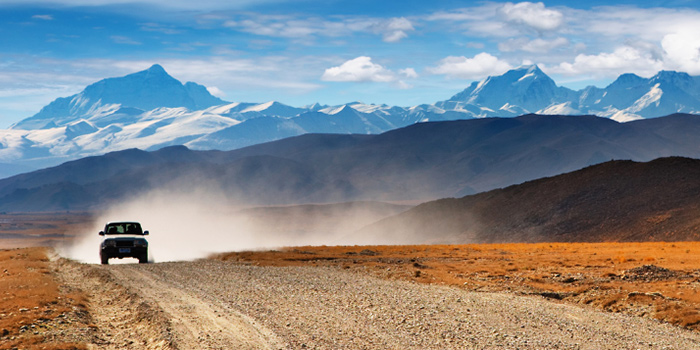
7 Days Lhasa to Kathmandu Small Group Tour
Nepal to tibet by overland: the most popular way across tibetan plateau, nepal to tibet overland via gyirong.
Overland travel into Tibet from Nepal is fast becoming one of the most popular ways to get to Tibet. Instead of flying to Lhasa from Kathmandu, you travel overland through Gyirong Port, the Chinese border checkpoint between China and Nepal. Getting there is relatively easy and is a six-hour drive from the Nepali capital, though you may want to stop along the way and start again from closer to the border in the morning, as the border closes at 3 pm Nepali time.
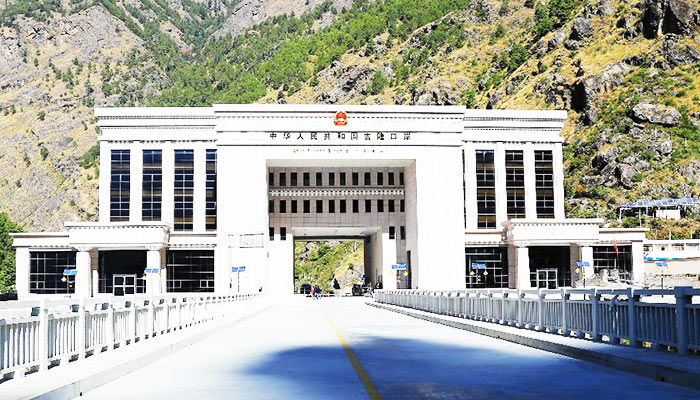
The Gyirong Port is the crossing border between Nepal and Tibet.
The border crossing of Gyirong Port has reopened since August 2017, after an earthquake in 2015 closed all border crossings from Nepal to Tibet. Now a major international border crossing, with Rasuwa Gadhi being the checkpoint on the Nepali side, thousands of people and vehicles with goods pass through this overland port every day.
Classic Itinerary: Kathmandu to Lhasa Overland via Mount Everest
An 8-day Kathmandu to Lhasa adventure that takes you across the massive Himalayas, this classic tour is one of the most popular tours of Tibet and is a great way to travel across the plateau from Nepal. Crossing the border at Gyirong Port, you will stop to acclimatize at Gyirong Town before taking the long drive to Mount Everest Base Camp, at 5,200 meters above sea level. The base camp lies a short distance from the remote Rongbuk Monastery, renowned as the highest Buddhist monastery in the world.
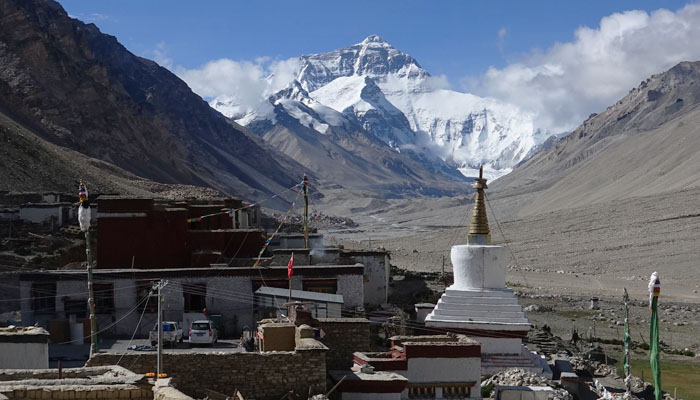
You can visit Mount Everest Base Camp while traveling overland from Kathmandu to Lhasa.
From there, you will double back to the Sino-Nepal Friendship Highway and travel east through Shigatse, the second city of Tibet, and Gyantse to reach Lhasa. Known as the City of Sunshine because of the huge number of sunny days throughout the year, Lhasa is the religious and cultural heart of Tibet and is the location of the most sacred temple in Tibet, the 1,300-year-old Jokhang Temple. An outstanding city with a host of popular attractions, it is also the location of the Potala Palace, the stunning Red and White palace that was the winter palace of the Dalai Lamas.
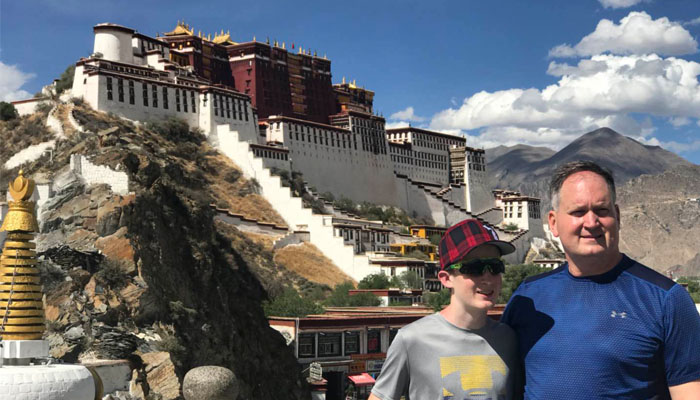
Visit the holy Lhasa city at the end of the 8-day Nepal to Tibet overland tour.
Nepal to Tibet by Flight: the Most Time-saving Way across the Himalayas
There is one direct flight from Kathmandu to Lhasa each week at present. The flight to Lhasa Gonggar International Airport from the Tribhuvan International Airport in Kathmandu takes around 90 minutes to cross the 607 kilometers across the plateau and pass directly over the summit of Mount Everest along the route.
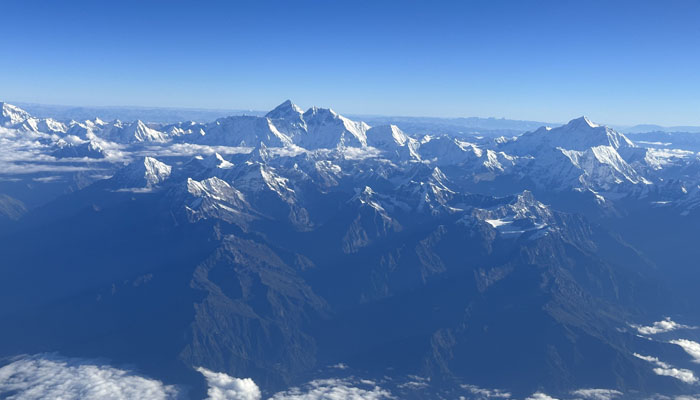
Kathmandu to Lhasa flight pass directly over the summit of Mount Everest.
While it is the fastest way to get to Lhasa from Nepal, the flight is not cheap, and a one-way economy flight can cost as much as 334 US dollars per person. The flight is offered by Himalaya Airlines and departs every Monday at 7:25 am. For many people traveling to Tibet from international locations outside Asia, Nepal is a popular stopover before traveling to Tibet by flight.
We recommend the 7-day Lhasa to Kathmandu Overland Tour to get the best of both ways of traveling. After arriving by flight, you’ll spend a few days in Lhasa exploring the city's famous cultural attractions before following the route back to Kathmandu while exploring Tibet overland.
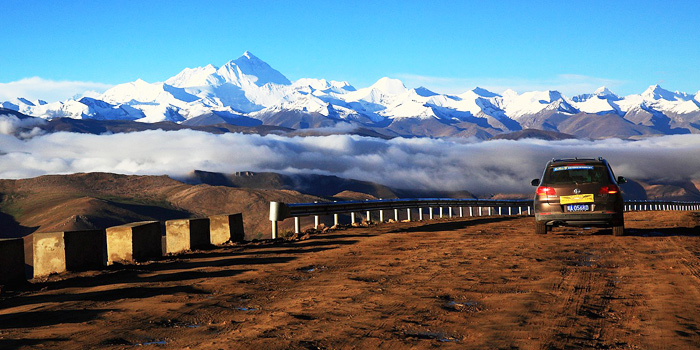
8 Days Kathmandu to Lhasa Driving Across Himalaya Overland Adventure Tour
Nepal to tibet by cycling: the challenging route for adventurous tourists.
Tourists looking for a challenging adventure with an intimate experience of the region’s natural beauty can cycle from Kathmandu all the way to Lhasa. The whole tour covers over 1,000 km and takes between 13 and 20 days to complete.
Cycling along the Friendship Highway is an amazing experience. The landscape is filled with majestic scenery of sweeping grasslands, pristine alpine lakes, and soaring mountains. You will be able to feel nature’s rhythm as you cycle through and stop along the way to visit monasteries or eat at small villages. It is bound to be the highlight in any cycling enthusiast’s life.
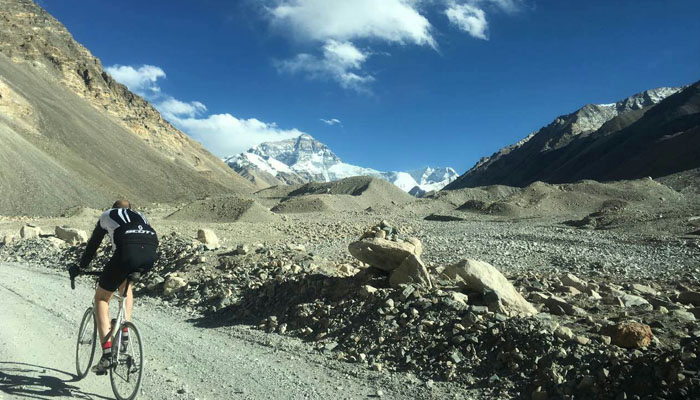
It is not a trip to be taken lightly hover. With an average altitude of 4,450 meters and some big ascents, a good fitness level is required. Altitude sickness is a significant risk, and weather conditions can become harsh at any time of year. Safety is essential at all times, a mechanical failure on your bike can cause injury. It can also be difficult to resupply on the way. As the leading local Tibet tour operator, we offer expert cycling leader and the professional support, to guarantee you a comfortable cycling journey from Kathmandu to Lhasa.
Nepal to Tibet by Train: A Forthcoming Experience to Expect
The planned railway between China and Nepal isn’t open yet, but it is moving forward, so it will be an option in the future. In 2014, the railway connecting Lhasa and Shigatse opened, immediately making transportation between these cities more convenient. That railway line will be extended by 628 km to reach Kathmandu via Gyirong. The Shigatse-Gyirong section is expected to start construction in 2025.
The railway will mostly follow the highway route from Shigatse to Nyalam, then Nyalam to Gyirong. When it is finished, tourists can enjoy high-speed rail travel through a larger part of the beautiful Tibetan Plateau.
What Documents are Required to Enter Tibet from Nepal?
For you to enter Tibet from Nepal, several documents are required before being allowed across the border. This applies to both overland travel and travel by plane, and it is not possible to enter Tibet from Nepal without all of the documents already in your possession.
Chinese Group Visa and Tibet Travel Permit: Essential Documents
The first thing you will need is the Tibet Travel Permit , which is required for entry into Tibet and travel around the region of Lhasa. We obtain this by using a scanned copy of your passport before your trip. Processing usually takes up to 15-20 days, so it is advisable to book well in advance to ensure that your permit is ready for your departure date.

Tibet Travel Permit is required for all foreigners to Tibet.
More Documents for Tibet Discovery
There are also other permits that you will need for travel into and around Tibet, and they are required for travel in certain places on the plateau.
The first is the Alien’s Travel Permit, which is required for travel to Tibet's “unopened” areas outside Lhasa like Mount Everest region. This is normally obtained once you reach Lhasa when traveling from mainland China, but for those traveling from Nepal, we will apply for and receive the permit in advance of your trip on your behalf.
Besides, you will also need the Military Permit. This is required for travel to certain military-restricted areas of Tibet, such as Ngari and Nyingchi, and is only needed for entry from Nepal to Tibet if your trip takes you to Mount Kailash in Ngari Prefecture. We will also help you to obtain it in advance.
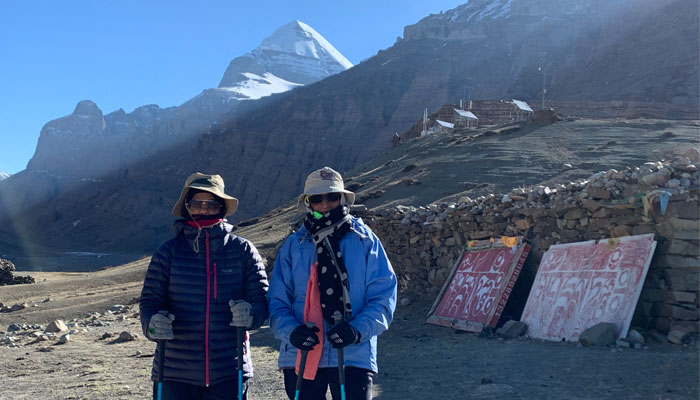
Nepal to Tibet Route Map Guide
Distance from Nepal to Tibet:
Kathmandu - Lhasa: 606km Kathmandu – EBC in Tibet: 160 km Kathmandu – Mount Kailash: 538 km
Routes from Nepal to Tibet:
1) Kathmandu to Lhasa by Overland: it covers around 1120 kilometers by road distance, following the Friendship Highway.
2) Kathmandu to Lhasa by Flight: it takes about 1.5 hours to get to Lhasa Gonggar Airport from Tribhuvan International Airport in Kathmandu.
Recommended Tibet and Nepal Tours
If you have chosen the right time to visit Tibet and Nepal, why not try our best-selling Tibet and Nepal small group tours? Choose between the Lhasa and Kathmandu overland, or extend to Mount Kailash, and start your lifetime journey at the roof of the world now!
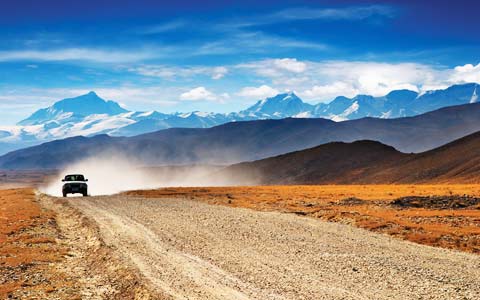
Tour Route: Lhasa - Shigatse - Everest Base Camp - Gyirong Border - Kathmandu
From US$979
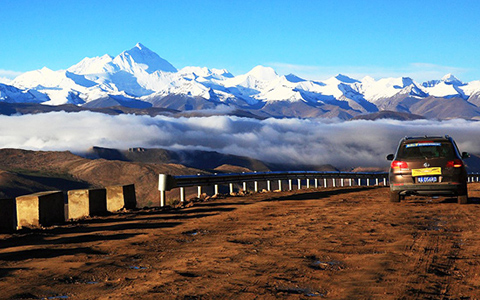
Tour Route: Kathmandu - Gyirong Border - Everest Base Camp - Shigatse - Lhasa
From US$1069
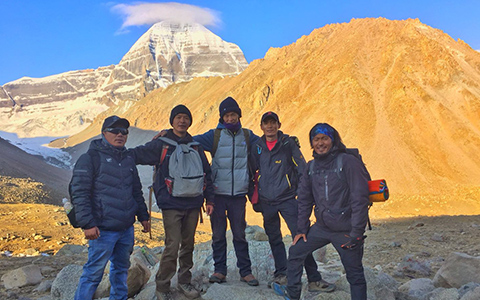
Tour Route: Lhasa - Gyantse - Shigatse - EBC - Saga - Darchen - Kailash Trek - Darchen - Saga - Gyirong - Kathmandu
From US$2059
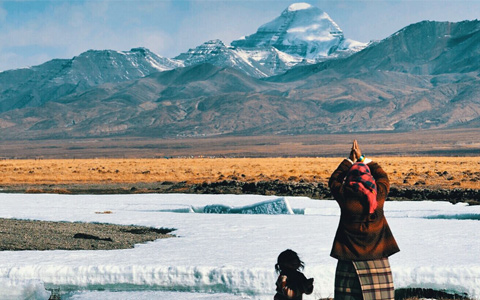
Tour Route: Kathmandu - Gyiron - Saga - Mt.Kailash - Lake Manasarovar - Saga - Gyiron - Kathmandu
From US$1749
Ask a Quick Question
Question Summary *
Please fill in your contact information, we will send you the answer by email
SUBMIT Cancel
Be the First One to Comment "How to Travel from Nepal to Tibet: The Ultimate Guide in 2024"
Budget Tibet Group Tours
- > 4 Days Lhasa Tour
- > 5 Days Lhasa & Ganden Monastery Tour
- > 6 Days Central Tibet Tour
- > 8 Days Everest Base Camp Tour
- > 15 Days Mount Kailash Tour
Our Best Tours
- > Tibet Small Group Tours
- > Tibet Nepal Tours
- > Tibet China Tours
- > Tibet Nepal China Tours
- > Tibet Train Tours
Office Address : Room 8102 (first floor) of Lhasa Gang Gyan hotel, Beijing East Road, Chengguan district, Lhasa.
News & Updates
Sign up to receive our newsletter for great articles, stunning photos, and special deals.
Featured On:

- 0086-891-6679450
- Everest Base Camp Tour Mount Kailash Tour Lhasa Tour Top 7 Tibet Tours Tibet Private Tour
- 4 Days Lhasa City Essential Group Tour from USD490 8 Days Lhasa to Everest Base Camp Group Tour from USD930 9 Days Lhasa Shigatse Mt.Everest Namtso Tour from USD1230 15 Days Mt.Everest & Mt Kailash Group Tour from USD1990
- 7 Days Lhasa Mt. Everest Kathmandu Overland Group Tour from USD980 12 Days Lhasa Mt Everest & Mt Kailash Kathmandu Group Tour from USD1990 13 Days Classic Tibet Nepal Bhutan Group Tour from USD2706 13 Days Tibet Nepal Nature Scenery Tour from USD2810
- Beijing and Tibet Tours Shanghai and Tibet Tours Chengdu and Tibet Tours Xian and Tibet Tours Guangzhou and Tibet Tours
- 6 Days Xining Lhasa Train Tour from USD880 6 Days Chengdu Lhasa Train Tour from USD785 7 Days Beijing Lhasa Train Tour from USD1040 8 Days Shanghai Tibet Train Tour from USD1235 Trains to Tibet
- Flights to Tibet
- Tibet Attractions
- Tibet Hotels
- Tibet Weather
- Tibet Permit
- When to Travel
- Plan a Trip
- How to Get to Tibet
- Travel Tips
- Tibetan New Year Tibetan Festivals Customs and Traditions Tibetan Food Tibetan Buddhism
- Bhutan Nepal Tibet Tours Nepal Tours Bhutan Tours Lhasa to Kathmandu India to Tibet
- Tibet Travel Tips
How to Travel from Nepal to Tibet?
- China to Tibet
- Beijing to Tibet
- Shanghai to Tibet
- Chengdu to Tibet
- Xiamen to Tibet
- Shenzhen to Tibet
- HongKong to Tibet
- Nepal to Tibet
- US to Tibet
- Canada to Tibet
- UK to Tibet
- Germany to Tibet
- Netherlands to Tibet
- Spain to Tibet
- Italy to Tibet
- Australia to Tibet
- Malaysia to Tibet
- Singapore to Tibet
- India to Tibet
- Japan to Tibet
- Philippines to Tibet
- Travel to Tibet by Train
- Travel to Tibet by Flight
- Travel to Tibet by Road

- by Catherine
- Last Updated: 2024-01-17
A trip from Nepal to Tibet offers you an opportunity to enjoy the profound Buddhist culture, and breathtaking Himalayan landscapes, and explore the hidden connections between the two tourist destinations. There are currently two options for traveling to Tibet from Nepal. You can either take a car crossing Gyirong Port or take a plane to Lhasa Gonggar Airport. Whichever way you choose, all foreign travelers must first obtain the Tibet Travel Permit through a Tibet travel agency before you enter Tibet. Here are details about how to go to Tibet from Nepal and how to get a permit.
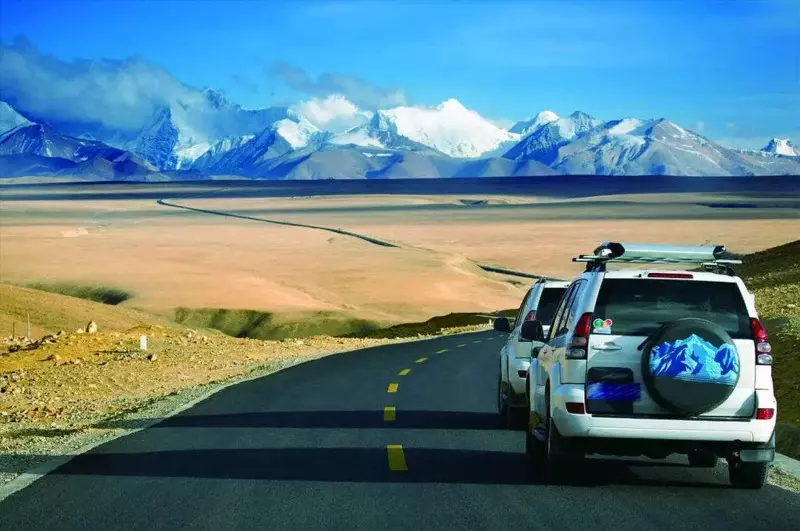
Why Travel from Nepal to Tibet?
The connections between Tibet and Nepal go back to ancient times. Nepal is the only way from ancient India to Tibet. As early as the Tang Dynasty, the Nepalese princess came to Tibet and married Tibet King Songtsen Gampo . Since then, close trade relations have been maintained between the two adjacent kingdoms, and the religious relations between the two places are also very close. So far, many famous Tibetan Buddhist monasteries have been preserved in Nepal, so Nepal has become the kingdom behind Tibet.
If you travel from Nepal to Tibet, you are just following the footsteps of the ancient Buddhist pilgrims who made a promise in their lifetime to visit the holy shrines and temples of these two ancient kingdoms.
You can either board a flight to Lhasa, Tibet from Kathmandu, Nepal or take an overland tour to Tibet. The straight-line distance between Kathmandu and Lhasa is 609 kilometers, while the land distance is about 1,300 kilometers.
Take a plane from Kathmandu to Lhasa
The fastest way and most convenient to reach Lhasa from Kathmandu is by plane. Nepal is the only country that has offered direct international flights to Tibet in the past but it has not yet resumed. Nepal’s main airport is the Tribhuvan International Airport which is around 6 kilometers from Kathmandu's downtown.
Now the direct flight from Kathmandu to Lhasa is remusing, only one direct flight on Monday till 28 March 2024. On other days, only connecting flights between Lhasa and Kathmandu are available, operated independently by Sichuan Airlines and Air China. It usually takes about 18 hours to get to Lhasa from Kathmandu by air and costs about $520 for a one-way ticket.
Equipped with your passport and China group visa , you can easily board a flight to Lhasa. Upon arrival at Lhasa, your Tibetan tour guide will greet you with your Tibet Travel Permit at the customs.
Travel Tips : The direct flight from Nepal to Tibet will bring you a stunning aerial view of the mountain tops - Mount Everest (8844.43 meters) and the incredible Himalayas. Since there will be a huge ascent from Kathmandu Valley (1,400 meters) to Lhasa (3,658 meters), it is best to take a good rest in the first few days in Lhasa to accommodate the altitude change. >> See more about the flight schedules from Kathmandu to Lhasa.
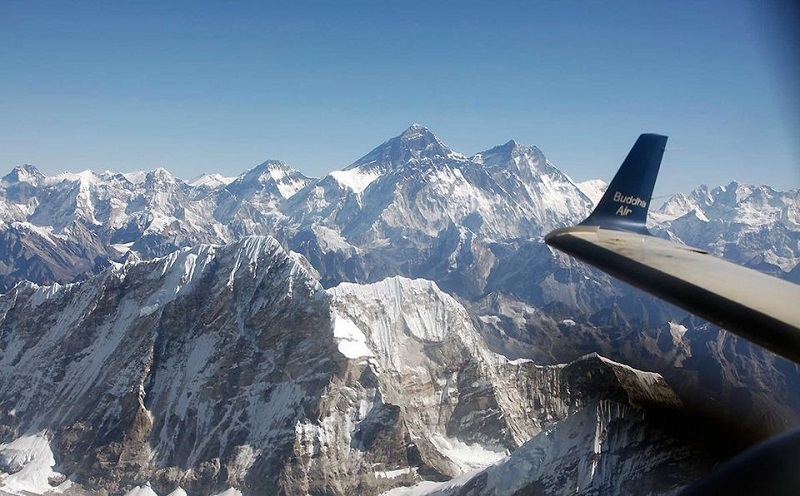
Take a Car From Nepal to Tibet
If you opt for the overland journey, you should be ready for a great ride across a 1,300-km road trip that usually takes 3 to 5 days to complete. Along the Sino-Nepal Highway , also known as the Friendship Highway, you will cross the majestic Himalayas to Gyirong Port, witness the north face of lofty Mt.Everest at Everest Base Camp , appreciate stunning holy lake Yamdrokts, and finally arrive in Lhasa to worship the Potala Palace and Jokhang Temple.
The overland route: Kathmandu → Gyirong → Tingri → EBC → Shigatse → Lhasa
√ 8 Days Kathmandu to Lhasa overland tour
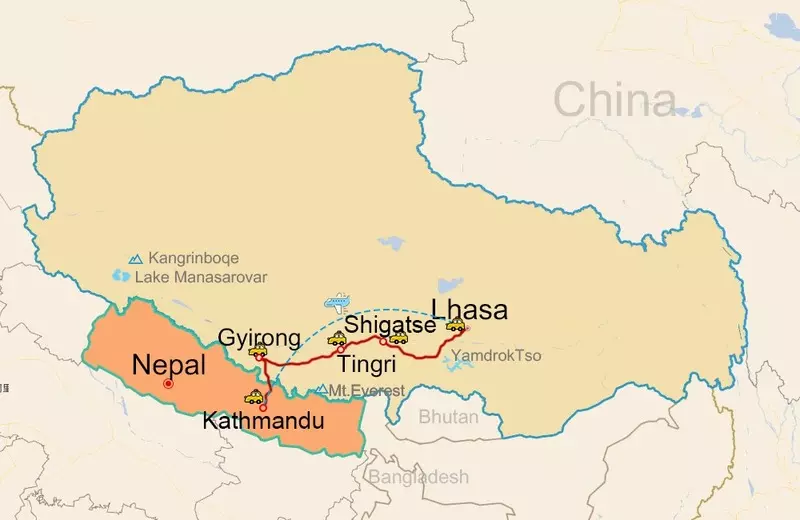
And of course, if you want to have an in-depth Tibet tour and cover Mt.Kailash in your journey , you can turn to the west after crossing the Gyirong Port then go trekking at the holiest mountain Kailash and appreciate the stunning lake Manasarovar. After your visit, get back to the Sino-Nepal Highway and travel to Lhasa. The whole tour takes about 12 days.
The overland route: Kathmandu → Gyirong → Zhongba → Darchen → Saga → EBC → Shigatse → Lhasa
Take a Train from Nepal to Tibet
So far, there is no railway linking Lhasa and Kathmandu. But the railway between Lhasa and Kathmandu is being designed by the governments of China and Nepal. It is said that the famous Qinghai-Tibet Railway will extend from Lhasa to Kathmandu. The first extension project of the Qinghai-Tibet Railway from Lhasa to Shigatse has been completed. In the near future, you might be able to take the train from Kathmandu to Lhasa.
The Necessary Permits for Entering Tibet
As a foreign traveler, you can only enter Tibet from Nepal through an organized group tour. To join an organized tour, you need to secure the necessary documents and permits like the Tibet Travel Permit and the China Group Visa .
Tibet Travel Permit
The Tibet Travel Permit is a "must-have" permit for all foreign tourists who want to enter Tibet via Nepal. It is also referred to as Tibet Entry Permit or Tibet Visa . You cannot board a flight to Tibet or pass through the borders between Nepal and Tibet if you do not have this permit. It can only be applied through a registered Tibet Travel Agency on behalf of the individual traveler. Please confirm your tour and send a scanned copy of your valid passport to your travel agency at least 10 days before your departure date.
However, if you are a journalist, diplomat, or government official, your application for Tibet Travel Permit will be handled by the Tibet Foreign Affairs Office. In other words, all the Tibet Travel agencies can't handle the permit for you.
On the other hand, if you are an Indian passport holder who wants to visit Mt. Kailash, you can secure your Tibet Travel Permit with the help of the Pilgrim Center or Foreign Affairs Office.
At present, any citizen of the 178 countries that have diplomatic ties with China can apply for Tibet Travel Permit.
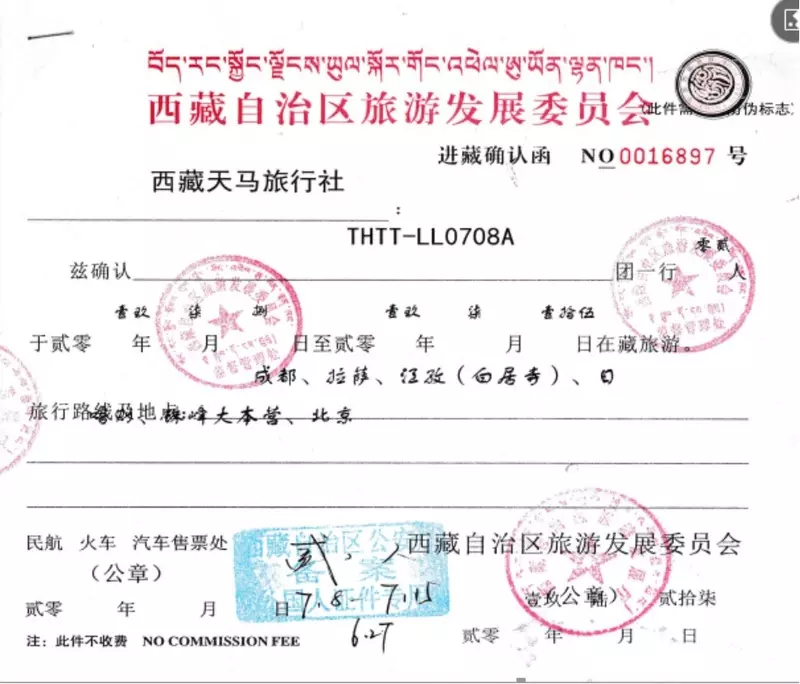
China Group Visa
Another necessary document is the China Group Visa. From Nepal to Tibet, you don't need a China Visa but a China Group Visa. Upon arrival at Kathmandu, you can apply for a China Group Visa at the People's Republic of China's Consulate by taking your invitation letter, passport, 2 passport-sized photos with a white background and the visa cost. Or you can entrust your travel agency to process it for you by spending USD20 as the service fee. The processing of this visa usually takes around 3 working days. Hence, you should leave at least 3 days in Kathmandu before your scheduled tour of Tibet. Please note, from May 2023, China Group Visa only issued per 4 participants.
How to Secure a China Group Visa?
There are three requirements to qualify for a group visa.
- You need an official China group visa invitation letter coming from the Tibet Tourism Bureau.
- There should be a minimum of four persons in your group.
- All your group members should enter and leave Tibet at the same time through the same entry point and exit point.
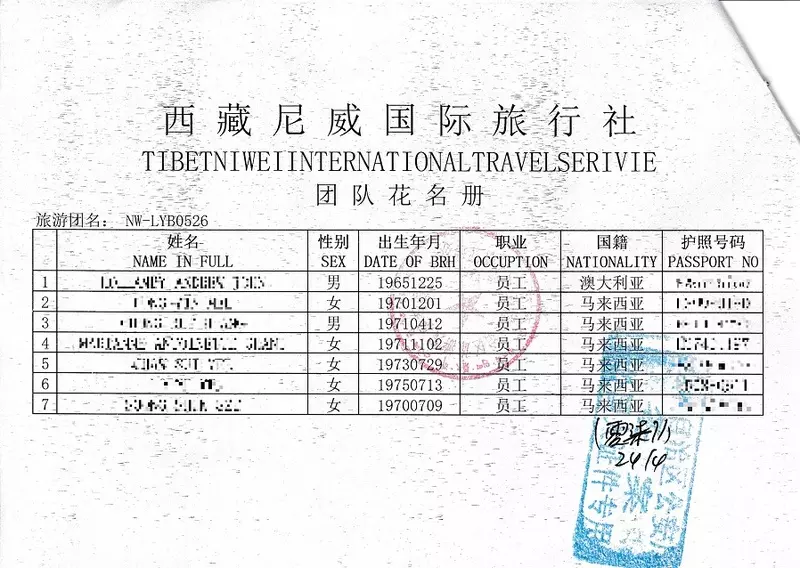
Nota Bene: We suggest you leave more than 3 working days in Kathmandu as the Chinese Embassy only accepts visa applications between 10 am to 12 pm on workdays. If you want to get your China Group Visa in 3 days, you need to submit it between 10 am and 12 pm in the morning of Mon till Wed, you can get your China Group Visa at 5 pm on Wed till Fri. Please contact our travel consultants for professional advice .
Traveling from Nepal to Tibet is always an exciting tour whether you travel by air or by land. The Nepal-Tibet flight is the fastest and most convenient way to reach Tibet from another country. You will get a bird’s eye view of Mt.Everest and the Himalayas during this flight. The overland route, on the other hand, between Nepal and Tibet is full of spectacular sceneries and surprising sites along the way. Both options are great!
As a reputable local Tibet Travel Agency, from our decades of experience and communication with thousands of clients, we recommend our customers fly from Kathmandu to Lhasa for a safer and better experience. Join us and start your memorable adventure in Nepal and Tibet now!
Related Articles
Nepal Visa Tourists can get a Nepal visa on arrival when reaching Kathmandu airport or road borders at Birganj, Sunauli, etc. $30 for a 15-day entry Nepal tourist visa.
Nepal Tibet Map Nepal and Tibet are located on the south and north side of the Himalayas. Here're practical travel maps of the world's two top tourist destinations.
China Group Visa(Tibet Group Visa) To enter Tibet from Nepal, you need a China Group visa from the Chinese Embassy in Kathmandu with your passport, an invitation letter and one headshot.
Travel from Lhasa to Kathmandu, by Land or by Flight? Traveling from Lhasa to Kathmandu by land, you will ride 1100km and enjoy scenic spots along Friendship highway. And traveling by flight is more comfortable.
Nepal to Tibet Transportation The route for Buddhist masters and scholars from Nepal to Tibet in ancient times has shifted to a famous Kathmandu to Lhasa tour for most travelers now.
Tibet and Nepal Both Tibet and Nepal are situated high up in the Himalayas. Tibet is on the northern side of the Himalayas, while Nepal is on the southern side.
Travel From Kathmandu to Everest Base Camp To Everest Base Camp in Nepal, you can fly to Lukla then trek there. To EBC in Tibet, you can fly to Lhasa then drive there or travel overland from Kathmandu.
Kathmandu to Lhasa Flight Flights from Kathmandu Tribhuvan International Airport(KTM) to Lhasa Gonggar Airport(LXA) cover a distance of 600km and take 90 mins. Check more!
Email response within 0.5~24 hours.
Typically Asked Questions from Our Clients
Asked by Susa***
I would like to visit Tibet from Nepal in July or August 2024. I will be by myself. What Document do I need and how do I go about it. I think I might fly one way and take a car on the way back to Katmandu. Thank you Susan

Dear Susan,
According to your inquiry, I recommend 7 days Lhasa Mt. Everest Kathmandu Overland group tour for you. You can take a connecting flight from Kathmandu to Lhasa via Chengdu. After the tour, we can arrange a jeep to send you back to Kathmandu.
Asked by Ali ***
Can you quote me for a max 7 night trip from Katmandu to Tibet. I can leave on Nov 4 and have to be back on Katmandu airport around noon on Nov 11.

Dear Ali****,
We can arrange a tour for you from Kathmandu to Lhasa then return to Kathmandu in November.
There's no direct flight from Kathmandu to Lhasa now. I suggest you take a flight from Kathmandu to Lhasa via Chengdu. Then you can have a 7-day Lhasa Mt. Everest Kathmandu Overland Tour to Kathmandu. You can arrive at Kathmandu airport at night on the last day.
For solo travelers, I suggest you consider our group tour. Currently, we have a group departure from Lhasa on 3 November. Would you consider adjusting your departure date to 2 November from Kathmandu? If you can't adjust the date, we can also arrange a private tour for you. Please let me know your idea.
Asked by Juli***
Hello, now I’m in Nepal until October 22. I would like to ask you a quote for the trip in Tibet, for me/us (probably we are 2 or only me) in the end of September it would be great. How I came back in Nepal after the road trip? Can I come back with bus/car as well (same way) ?Normally people felt bad on high ? Thank you for your help.
Dear Juli****,
Thank you for sending us an inquiry!
As per your request, I recommend 7 days Lhasa Mt. Everest Kathmandu Overland group tour for you. We can open one for you on 29 September if you are booking now. After your Tibet tour, we can arrange a private jeep to take you to Kathmandu from Gyirong Port, which costs USD220.
Now there is no direct flight from Kathmandu to Lhasa but connecting flights via Chengdu are available. I suggest you fly to Chengdu then to Lhasa. As the tour date is very close, I'm wondering if you have got your China visa yet.
Asked by Luan***
Hi, My husband and I are planning a trip to Nepal and Tibet. Since I have been to China in the past and would prefer not to come back, the idea is to get the Tibet permit while in Kathmandu. But a friend says that the Chinese Embassy in Nepal is 'refusing' more than 90% of the applicants. Is that true? Please let us know. We are keen to organize the whole trip through a travel agency - you, but, although there is always a chance of not getting a visa/permit, don't want to invest the money in air tickets, hotel, vacation days if the chances of not getting it are high. I look forward to hearing from you asap.
Dear Luana,
As per your request, we can arrange Nepal & Tibet tour for you on 11 October if you apply for China visa instead of China group visa in Kathmandu and if you go to Lhasa from Kathmandu by plane not by road.
If you prefer to travel to Lhasa from Kathmandu overland, you are required to apply for China group visa. However, China group visa application requires 5 applicants to present together for an interview and have their fingerprints collected. In addition, 5 applicants should leave China from the same depart port at the same time. That's why your friend says that the Chinese Embassy in Nepal is 'refusing' more than 90% of the applicants. I suggest you apply for China visa and fly to Lhasa from Kathmandu then go back to Kathmandu overland.
Asked by Jami***
Hi I am a Canadian citizen and am cycling around the world. I would like to visit Tibet in April 2023. Can I fly to Lhasa with my bicycle and then cycle to Kathmandu? Is there a requirement to be in China for 90 days before travelling to Tibet?

Dear Jamie, Thank you for sending us an inquiry! This is Beatrice from Great Tibet Tour at your service. According to the policy 2019, you can take your own bike to cycle from Lhasa to Kathmandu. But still, a tour guide and a vehicle should be equipped. And the info should be added to your Tibet travel permit. Right now, Tibet is still closing and it's very uncertain about your trip next April. There's a quarantine period lasting 7 days to enter China. China's government do not issue tourist visa at the moment and the Tibet tourism bureau requires 90 days' stay in China for issuing permits. So I'm afraid it's difficult to get there. You may contact us later, in February of 2023. If Tibet opens in April, we should be notified then.
Read More ...
Sign up for our newsletter below. It's a great way to stay in touch with us and receive great news when we have them ready for you.
- Favorites 0
- [email protected]
- Newsletter signup

Great Tibet Tour is a local tour company based in Lhasa, Tibet. It was founded in 2005 and recommended by Lonely Planet as one of the best reputed local Tibet travel agencies.
With the great responsibility, professional know-how and passion for innovation, Great Tibet Tour endeavors to provide you with enjoyable, thoughtful service, and authentic culture discovery.

Search Your KeyWord
How to travel to tibet from nepal 2024 updated.

How to travel to Tibet from Nepal?
Getting a China Group visa can be a breeze if you apply from Nepal! One can reach Tibet from Nepal by either flying to Lhasa, Tibet from Kathmandu, Nepal or by opting for an overland tour from the Nepal border Rasuwa Gadi between Kyirong town in Tibet.
If you are traveling to Tibet from Nepal, this article provides guidance.
For those intending to travel to Tibet from cities within China , please refer to this separate article.
Content Table for Travel Tibet from Nepal.
Travel to tibet from nepal., 1. plan the trip a month in advance..
To ensure a smooth trip to Tibet, it is recommended that you plan your itinerary one month ahead of time. Also, it is essential to reserve your Tibet tours beforehand to allow enough at least 20 days for us to process your China Tibet group visa and Tibet Travel Permit.
To travel to Tibet from Nepal, you will require two essential documents: the China Tibet group visa and the Tibet Travel Permit . You can rest easy knowing that we will handle the process of obtaining both documents for you .
2. How to get a China group visa from Nepal?
Our travel agency needs scans of travelers' passports and the exact dates of their entry and exit from Tibet, along with confirmation of their Tibet tour itinerary booked through us, in order to obtain the China group visa from Nepal.
3. How long will it take to apply for a China group visa?
In order to obtain the China Tibet Group visa, it is advised to spend three to four business days in Kathmandu with the assistance of our partner agency in Nepal. It is important to note that the Chinese Embassy in Nepal has scheduled closures on weekends and certain holidays annually. To ensure a hassle-free visa application process, please refer to the holiday dates for the year 2024.
4. What are the 2024 holiday dates for the China Embassy in Nepal?
- April 4th, 5th, 6th ( Ancestor Memorable Day)
- May 1st to May 5th ( International Labor Day)
- June 25th, 26th, 27th ( Dragon boating festival )
- October 1st, 2nd, 3rd, 4th, 5th, 6th, 7th, 8th ( National holiday )

Photo: China Group Visa
5. What is the cost of the China Tibet Group visa fee?
Regular visa fee / four working days.
USA: $ 204 per person
Canada: $ 104 per person
Other Countries: $ 80 per person
* Note: Service charge is included in the above visa fees.
Urgent visa fee / three working days.
USA: $ 229 per person
Canada: $ 129 per person
Other Countries: $ 105 per person
Note: Service charge is included in the above visa fees.
6. What is the latest update on the China Tibet Group Visa 2024?
- To obtain a China visa from Nepal, the minimum requirement is four individuals. However, you can rest assured that you can reach out to us via email for any further inquiries.
- By April, travelers will be able to fly from Kathmandu to Lhasa. Alternatively, there will be the option of a vehicle journey from Nepal to Tibet via the Rasuwa Kyirong border.
7. The Chinese Embassy in Nepal requires what specific details?
- Four full working days in Kathmandu.
- The Traveler must have their original passport with them.
- One photo with a white background (size example below).

Photo: Example of China Tibet Group visa photo size with a white background.
Upon arrival in Nepal, travelers have the option to pay for the China Tibet group visa fee. To arrange the visa, our affiliate agency in Nepal will visit the airport or the traveler's hotel.
8. What are the requirements for booking a Tibet tour from Nepal?
- A well scanned copy of your passport.
- The tour's entry and exit dates will need to be confirmed, along with the destinations to be visited while traveling through Tibet.
- Payment deposit of 50 US dollars per person using Paypal. [email protected]
9. What are the entry and exit dates for the Tibet Travel Permit?
P lease note that your entry and exit dates will be recorded on the Tibet Travel Permit. It is crucial to leave Tibet and other cities in China by the specified exit date. As per regulations, travelers are advised to limit their visits to only the sites listed on the Tibet Travel Permit. As soon as you arrive at Lhasa Gonggar airport or the Kyirong border with Nepal, our friendly tour guide will obtain the Tibet Travel Permit and welcome you.
10. How to Purchase flight from home to Nepal ?
Below, we suggest ways to buy your flights to Nepal and then use the Tibet Travelers agency to arrange your travel to Tibet either by land or plane. We suggest using the Kayak , Trip.com , and Fare Compare websites to find the best international flights to Nepal. You can also look for trustworthy flight websites from Google.
11. How to purchase a flight from Nepal to Tibet?
If you need assistance in obtaining flight tickets from Kathmandu, Nepal, to Lhasa, Tibet, we are here to help. Please note that in order to board a flight to Tibet, travelers are required to possess the original Tibet Travel Permit at Lhasa airport or Nepal border town if they travel by land. In order to ensure that you have the proper documentation, we will arrange for one of our tour guides to meet you at Lhasa airport or Nepal border.
12. What about the Tibet Travel Permit?
As we apply for a Travelers China Group Visa, we will simultaneously apply for a Tibet Travel Permit. During our trip, our tour guide will carry the Tibet Travel Permit with them and present it to public offices for registration at Lhasa Gonggar airport or the Nepal border town of Rasuwa between Kyirong when picking up the Travelers. The permit will also be with the Tour Guide throughout our traveling in Tibet.

Photo: The stunning Mount Kailash.
13. What are the Tibet Travel Recommend ations?
We recommend a few travel itineraries for travelers. The first Tibet travel journey is a 10-day Tibet travel that begins in Lhasa and culminates at Mount Everest base camp and Namtso Lake. The second Tibet trip we recommend is a 17-day Tibet travel journey from Lhasa that takes you to Mount Kailash , where you will trek for three days over 52km at an altitude of 5000 meters. During this tour, you will also visit the Guge Kingdoms and Mount Everest base camp.
If you're a traveler intending to visit Nepal following Tibet, we highly suggest our 8-day overland excursion from Lhasa to Kathmandu , which includes a stop at Mount Everest's North Face Base Camp.
14. How to meet your agency staff in Tibet?
Begin your journey in Tibet by meeting our amiable team of Tibet Travelers, Tibetan local Tour Guide, and local Tour Driver either at Lhasa airport or the Nepal border town.
We are eagerly waiting to greet you and display the splendor of Tibet, so please feel free to reach out to us if you have any queries or apprehensions. We would be delighted to receive your feedback. You can reach us anytime through Live Chat, DM on Instagram, or by sending us an email at [email protected] . I can't wait to help you plan your Tibet tour and tibet travel adventure!

Dec 22, 2023
- Whats Voice Call Link
Tibet Travel, Tibet Tours, Tibetan Local Tibet Travel Agency
© Copyright 2016-2024 All Rights Reserved Privacy Policy

Himalayan 360
A Leading B2B Nepal Operator
Call Expert (Raj) 24X7

Quick Questions? Email Us
How to plan tibet tour via nepal | complete guide.
If you’re looking for a once-in-a-lifetime Cultural and Spiritual adventure then plan a Tibet Tour Via Nepal. With the opening of the overland border crossing at Gyirong Port, it’s now easier than ever to explore the stunning landscapes and rich cultures of both Nepal and Tibet in one epic journey. Here you will know A Step-by-Step Guide for Tibet tour via Nepal.
Table of Contents
Step 1: Start Your Journey in Kathmandu
Kathmandu is usually the starting point of most Nepal to Tibet tours, as it offers easy access to the overland border crossing and the international airport. But before embarking on your Tibetan adventure, make sure to spend a few days exploring the vibrant city of Kathmandu . Visit its UNESCO World Heritage Sites , such as Durbar Square , Swayambhunath Stupa , and Boudhanath Stupa , and indulge in the local cuisine and vibrant culture.
Step 2: Secure Your Tibet Travel Documents and Permits
To enter Tibet, you need to have several travel documents and permits. As an international tourist, you must have a Tibet Travel Permit, which is only available through a registered tour operator . Your tour operator will use a scanned color copy of your passport to apply for the permit on your behalf, and the processing time usually takes around 15-20 days.
In addition to the Tibet Travel Permit , you also need a Chinese Visa to enter Tibet. Unlike the standard Chinese Entry Visa, you will be issued a Chinese Group Visa upon arrival in Nepal. Your tour operator’s Nepali staff will apply for the visa on your behalf, and the processing time is three working days.
There are also other permits that you need, such as the Alien’s Travel Permit and the Frontier Pass . These permits are usually obtained upon arrival in Lhasa from mainland China, but when traveling from Nepal, you need to have them issued before your trip. Your tour operator will handle the arrangements for these permits to be ready before your trip departure date.
Step 3: Choose Your Mode of Transportation
There are two ways to Tibet Tour Via Nepal: overland and by air. If you choose the overland option , you’ll travel from Kathmandu to Lhasa via the Gyirong Port. This route offers breathtaking views of the Himalayas and allows you to experience the local cultures and traditions along the way. If you opt for the air option , you’ll fly from Kathmandu to Lhasa, which is a quicker and more convenient way to reach Tibet.
Step 4: Plan Your Itinerary for Tibet Tour Via Nepal: A Guide to Flights and Overland Routes Tibet
Once you arrive in Lhasa, it’s time to start exploring the wonders of Tibet. There are numerous attractions and destinations to visit, such as the Potala Palace , Jokhang Temple , Namtso Lake , and Mount Everest Base Camp . Your tour operator will help you plan your itinerary based on your interests and preferences, and ensure that you have a safe and enjoyable trip.
Final Thoughts
Tibet Tour Via Nepal is an unforgettable adventure that offers a unique blend of culture, history, and natural beauty. By following this step-by-step guide and working with a reputable tour operator, you can make sure that your trip is well-planned and hassle-free. So pack your bags, grab your camera, and get ready for the journey of a lifetime!
Best Travel Seasons for Tibet Tour Via Nepal: A Guide to Planning Your Adventure
Tibet and Nepal are popular travel destinations for adventure and cultural experiences in Asia. However, their climates differ significantly, with Tibet having a high-altitude plateau sub-tropical climate, while Nepal has a more varied climate dependent on season and altitude.
For an optimal trip to Tibet, travelers should visit from April to June and September to October, avoiding the rainy season. This period offers clear skies, mild temperatures, and excellent trekking conditions. The peak period for travel is from June to October. During these months, temperatures remain moderate, with no rainfall.
Nepal’s peak travel season is from October to May, during the dry season. However, weather conditions differ based on altitude. December to March is not ideal for visiting higher altitudes of the Himalayan Mountains due to heavy snowfall and intense cold. The best times to visit are during the spring and autumn seasons.
Nepal’s monsoon season occurs from June to late September, making it less ideal for travel to southern low-altitude areas. However, the dry season presents an opportunity to explore the plains and jungles of Nepal and experience various adventure sports.
In conclusion , while Tibet and Nepal share a region, travelers should consider the best time to visit based on climate and preferences. By carefully planning and timing trips, visitors can fully enjoy the natural beauty and excitement of these unique destinations.
How to Travel to Tibet from Nepal: A Guide to Flights and Overland Routes
Are you planning a trip to Tibet from Nepal? There are two main ways to get there – taking a flight or traveling by road. Here, we’ll give you the lowdown on both options.
Flights from Nepal to Tibet
The fastest and easiest way to get to Tibet from Nepal is by taking a flight. The Tribhuvan International Airport in Kathmandu offers direct international flights to Lhasa, the capital of Tibet. Currently, there are only three airlines that operate flights from Kathmandu to Lhasa, and the average one-way economy fare is around US$220-US$250 per person.
The flight takes about 90 minutes and offers stunning views of the Himalayas, including Mount Everest . However, it’s important to note that you’ll need to acclimatize to the high altitude once you arrive in Lhasa, which is over 3,000 meters above sea level. Plan to spend at least two days acclimatizing and avoid caffeine, alcohol, cigarettes, and strenuous exercise during this time.
Tibet Tour Via Nepal by road
The more scenic route for Tibet Tour Via Nepal is by traveling overland by road. The G318 Friendship Highway takes you from Kathmandu to Lhasa, passing through several towns and cities along the way. The road trip includes a visit to the Everest Base Camp , the Tashilhunpo Monastery , and the Kumbum Stupa .
The overland route starts at Kathmandu and goes through the Langtang National Park and up to Rasuwa Gadhi before crossing the border at Gyirong Port. From there, you’ll travel to Gyirong Town to acclimatize to the high altitude. The entire road trip takes several days, and you’ll need to make arrangements for accommodations and meals along the way.
Insider Tips:
As the only local Tibet travel agency with offices in Kathmandu, Lhasa, and Chengdu, we offer convenient and safe transfers across the Sino-Nepal border . Our jeep service provides a tourist-friendly experience, and we can help you obtain your China Group Visa and Tibet Permit . We also recommend the best-value hotels and can assist with booking flights and other l ogistics . Contact us for more details.
Conclusion:
Both the flight and overland routes offer unique experiences and stunning views. Choose the option that fits your schedule and budget, and be sure to plan for altitude sickness if traveling by road. With careful planning and the right resources, your journey from Nepal to Tibet will be unforgettable.
Top Travel Routes for Tibet Tour Via Nepal: Enjoy Trekking, Culture, and Wildlife
If you’re looking for an adventure that offers stunning mountain views, rich cultural experiences, and unique wildlife encounters, a tour of Nepal and Tibet should be at the top of your list. From trekking to Mount Everest Base Camp (EBC) on both the Nepalese and Tibetan sides to exploring the vibrant cultures of Tibetan Buddhism and Hinduism , to encountering rare and beautiful wildlife in their natural habitats, this tour has it all.
Trek to Mount Everest Base Camp
Trekking is a popular activity in both Nepal and Tibet, with Mount Everest straddling the border between the two countries. In Nepal, the trek to EBC on the southern side starts from Lukla and takes around 13 days to complete the trek. On the Tibetan side, the trek starts at Old Tingri on the G318 and takes just four days to reach the northern EBC. In addition to trekking and helicopter options in Nepal, you can enjoy a tour vehicle, cycling, motorcycle, and trekking to EBC in Tibet.
Tibet Tour Via Nepal map
Explore the rich culture of tibet and nepal.
Religion is of high importance to the local populations of both Nepal and Tibet, but the two countries have very different religions. In Tibet, Tibetan Buddhism is the primary religion, and the unique Buddhist culture can be found throughout the plateau and in the everyday lives of the Tibetan people. In Nepal, Hinduism is the predominant religion, but Tibetan Buddhism has been a major part of the culture as well. For the best experiences of Buddhism and Hinduism in Nepal, visit the Kathmandu Valley and the sacred site of Lumbini , the birthplace of Gautama Buddha . In Tibet, explore the Jokhang Temple in Lhasa and the sacred Mount Kailash in Ngari.
Encounter Unique Wildlife in Nepal and Tibet
Despite being on the highest plateau in the world, Tibet is home to a diverse range of wildlife, including wild yaks, donkeys, antelopes, snow leopards, and pika. In Nepal, the Chitwan National Nature Preserve is one of the best places in Southern Asia for a wildlife safari , with Bengal tigers, one-horned rhinos, crocodiles, leopards, and more.
Join the Most Recommended Tibet Tour Via Nepal
If you’re ready for the adventure of a lifetime, consider joining one of our highly recommended tours:
Lhasa to Everest Base Camp Tour
Kailash yatra from kathmandu via lhasa, 13-day kailash tour from kathmandu by road, kailash mansarovar yatra tour packages 2024, join the most recommended mt.kailash tour via nepal for indian religious people.
Are you an Indian religious person looking for an unforgettable journey to Mount Kailash? Our Mt. Kailash tour via Nepal is the perfect choice for you. This tour will take you on an incredible journey to one of the most sacred sites in Hinduism, Buddhism, and Jainism. Join us on this spiritual adventure of a lifetime Through these tour packages.
- Kailash Yatra via Lhasa
- Kailash Yatra via Kerung
- Kailash Yatra via Kathmandu
- Lhasa Overnight Tour
- Kailash Mansarovar Yatra via Kathmandu
Nepal and Tibet offer some of the most intense and amazing travel experiences in Asia. From high mountains and vast prairies to dense jungles and alpine valleys, these two destinations on either side of the mighty Himalayas make for one of the best tours this blue planet has to offer. Stand at the foot of the world’s highest mountain and gaze up at its massive peak, knowing you’ve truly reached the Roof of the World. Book your Nepal to Tibet tour today!
Leave a reply … Cancel reply
Your email address will not be published. Required fields are marked *
Save my name, email, and website in this browser for the next time I comment.
Keep Reading See All
Makalu base camp trek guide | full information.
Getting a new SIM card in Nepal | Best Data Pack NTC NCELL

Travel to Tibet and Nepal: Essential Guide to Planning Your Adventure

Tibet and Nepal are some of the most popular places in the Himalayan region and no surprise that many people want to visit both at the same time. They are located nearby, and there is a choice of a short flight between them or a beautiful road connecting Lhasa and Kathmandu. In this article you will find information about documents required to travel to both Tibet and Nepal, information about the ways of traveling, when to visit and where to start your adventure.
VISA REQUIREMENTS
If you travel from tibet to nepal.

You will arrive in Tibet from China either by plane or on a train. First, most of the visitors will need to apply for a Chinese visa in their home countries. It typically takes about one week.
After you have your visa, your travel agency will arrange a special permit for you to visit Tibet . It will additionally take about 15 days.
That means you should start planning your trip 1 month in advance .
You will also need Nepalese visa when you enter Nepal (either at the overland border or in the airport). Most visitors are eligible for visa on arrival.
If you travel from Nepal to Tibet

Nepal has a very relaxed visa policy. Most of the travelers can receive their Nepalese visa upon arrival at the airport.
Read about traveling to Kathmandu, visa on arrival requirements and things to do in the capital of Nepal .
When you travel to Tibet from Nepal, you will also need a Chinese visa. It won’t be a regular visa, but a Chinese group visa . It is a single entry visa, and it is issued on a separate paper. You can receive it as early as in 3 working days with urgent service or save some money and apply for 5 days service.
While waiting for your visa, you can travel in Nepal.
Even though it only takes 3-5 days to apply for a Chinese group visa, you still need to arrange your Tibet tour in advance. Your travel agency has to apply for an invitation letter for you, as well as Tibet travel permit. It can take approximately 15 days.
If you started planning your visit very close to your travel dates, traveling through Nepal can save you some time on processing required documents. It can take only 15 days to arrange all necessary documents for your visit. We still don’t advise to wait until the last moment.
WAYS TO TRAVEL BETWEEN TIBET AND NEPAL
There are two ways to travel between Tibet and Nepal: flying and going overland. Taking a plane will get you from Kathmandu to Lhasa or from Lhasa to Kathmandu in a very short time. If you are lucky, you will even get a beautiful view of the Himalayas. However, if you want to see the Himalayas from up close, you might want to opt for an overland tour.
Below are the pros and cons of both ways of traveling.
Flight connecting Lhasa (LXA) with Kathmandu (KTM)

There is one daily flight between Lhasa and Kathmandu. Air China and Sichuan Airlines offer nonstop flights and their schedule alternates.
The flight is only 1 hour 30 minutes long. When the weather is clear, you can get an incredible view of the Himalayan mountains while flying over them on that route.
Because the weather in Himalayas changes quickly, delays and schedule changes are not uncommon. Allow some extra time when taking a plane.
Lhasa airport is one of the highest airports on the planet. It is surrounded by a mountain range. Flying from this airport or landing there is a wonderful experience on its own.
Overland Route Through Gyirong Port

The overland route between Tibet and Nepal goes through the Gyirong port border town. The road is wonderful, and the journey is pleasant.
However, there is one major factor to consider while planning an overland tour. It is much easier to travel from Lhasa to Kathmandu than the other way around because the road goes through high altitude areas, and the order is essential.
Altitude Change on the Overland Route
When traveling from Tibet, most visitors start in Lhasa at an altitude of 3,650 meters above sea level. After initial acclimatizing that takes a couple of days, you are ready to continue to higher areas. On the way to the Nepal border, you will be gradually increasing the altitude. The highest point of the road is in the Everest region, where most visitors usually stay for the night. Rongbuk monastery lies at 5,000 meters, and you will be rewarded with a fantastic view of Everest. After that, altitude decreases to about 1,800 meters by the time you reach the border.

When you travel overland from Nepal to Tibet, it is the opposite. You gain altitude very fast, and you cannot acclimatize properly for the elevation of Everest Region. You start at the Gyirong port border (1,800 meters), then ascent to Gyirong town (2,800 meters), and on the next day, you reach an altitude of 5,000 meters in the Everest Region. This route is a good option if you did some trekking in high mountain areas of Nepal. Then you will already acclimatize for altitude and can travel to Tibet.
Overland Route Through Purang/ Taklakot

One of the most adventurous ways to cross the border between Tibet and Nepal is to travel through Burang or Purang (also known as Taklakot in Nepalese). If you start traveling in Kathmandu, you will first need to take two short flights: Kathmandu to Nepalgunj, and from Nepalgunj to Simikot. From Simikot, you will take a helicopter for a short flight to the border village Hilsa. Once you cross the border, it will be a short ride to Burang.
This gateway takes you directly to the most revered places in Western Tibet – Manasarovar lake and Mount Kailash. That’s why this route is very popular among pilgrims traveling to Kailash from both Nepal and India.
This is also a great option if you love views of the mountains, and the helicopter ride is very picturesque. You will be flying over mountains, river canyon, and forests. It is best to travel during the dry season to enjoy the view and to minimize chances of flight delays.
How long is the overland route

The reasonably paced tour from Lhasa to Tibet-Nepal border takes at least 7 days. It includes the time necessary for acclimatizing to the high altitude of Tibet, and the actual travel time. Almost no one takes the shortest possible route to the border. Instead, visitors combine travel time with sightseeing in Tibet.
The typical itinerary starts in Lhasa, where you will stay for three days acclimatizing. After that, you will travel to Shigatse through Yamdrok Lake, Karola glaciers, Gyantse monastery, and Kumbum Stupa. At the end of the next day, you will reach the Everest region and stay for the night at Rongbuk monastery. On day six you will drive to the border town. In the morning of the seventh day, your Tibetan guide will take you to the Tibet-Nepal border.
Once you cross the border, you can hire one of the jeeps that are always there waiting for tourists. You can share the ride to lower the cost.
From the border, it usually takes one full day to drive to Kathmandu. However, road conditions in Nepal sometimes won’t allow traveling that fast. It is always better to have some extra time before your scheduled departure from Nepal. The situation on the road varies depending on the time of the year and the weather. We explain it in detail in the next section.
Weather consideration
The road from Lhasa in Tibet to the border is usually good. Sometimes there is construction on a road, often near the border area, but generally, there is a little delay in the travel plans. In Nepal, the landscape is different, and the road is rough. During the dry season, it takes one day to drive from the Tibet-Nepal border to Kathmandu.
During the monsoon season in July – August, the road in Nepal becomes less pleasant, as mudslides occur along the way. It can delay traveling on the road. If you travel during those months, have some extra free time and be prepared to adjust your plans.
PRIVATE VS GROUP TOUR BETWEEN TIBET AND NEPAL

All overland group tours go only in one direction: from Tibet to Nepal. Because you can acclimatize better traveling from Tibet, a lot more people travel in this direction.
For those who did some trekking in high altitude in Nepal, the option to travel overland from Nepal to Tibet is also available. In most cases, it will be a private tour (unless you are traveling as a group).
If you are planning to fly to Tibet and take any tour withing Tibet only, you will have a wide choice of both group and private tours.
Even if you are traveling from Tibet to Nepal, you might still prefer the private tour option. While the group tour visits only the highlights, you can extend your visit to Tibet for better acclimatizing or traveling to other areas. One of the great options can be extending your visit to see Mount Kailash or possibly even trek around the mountain.
SHOULD YOU VISIT TIBET OR NEPAL FIRST
You can start your trip in either Kathmandu or Lhasa. However, there are some situations, when direction matters.
Here are some of these individual cases:
- If you are planning close to your vacation dates, it might be easier to start your tour in Nepal. As explained in the visa section, it generally takes a little less time to arrange all paperwork for a visit if you start from Nepal
- If you want to travel in China as well, it is best to start your tour in China or Tibet and then go to Nepal. If you travel from Nepal, you have to apply for a Chinese group visa. This visa is typically valid for less than a month, and you cannot extend it. That’s why it is best to start a tour in China or Tibet and then travel to Nepal.
- If you want to take an overland route, it is generally much more comfortable to take an overland route from Tibet to Nepal than the other way around. The reason is easier acclimatizing and choice between private and group tours.
- If you want to spend only a day or two in Nepal, you should start your trip in Tibet. It takes at least 3 full business days to process your Chinese group visa necessary to enter Tibet. If you are staying only a short time in Nepal or your 3-4 days stay includes weekends, you should plan traveling from Tibet to Nepal.
- If you travel during long Chinese holidays, you might be better starting your tour in Tibet. During the holidays, the Chinese Embassy in Nepal doesn’t work, and you might have to wait for your group visa for more than a week. There is no way to pre-process your group visa before your arrival in Nepal. If you are not planning to stay in Nepal for long, you should start traveling from Tibet. The long Chinese holidays happen in May, beginning of October and during Chinese New Year (usually falls on the end of January- February).
TOURS CONNECTING TIBET AND NEPAL

7 DAYS GROUP TOUR FROM LHASA TO NEPAL
During this 7 days tour you will see the most beautiful places in the Himalayas. We start in Lhasa, the capital of Tibet, where we visit UNESCO World Heritage sites Potala Palace and Jokhang Temple, and two important monasteries – Sera and Drepung. After that we will drive to Shigatse through Yamdrok Lake, Karola Glaciers, Gyantse monastery and Kumbum Stupa. On the following day, we reach the world’s highest mountain Everest to spend one night by the Rongbuk monastery. Finally, the road will take us to Nepal border at Gyirong port.

NEPAL TO LHASA, TIBET – 7 DAYS TOUR
This private tour will take you from Tibet-Nepal border at Gyirong port to the heart of Tibet, it’s capital city Lhasa. On the way, we will spend one night at the world’s highest mountain Everest. After that, we will drive through Shigatse and Gyantse to Lhasa. In Lhasa, we will visit Potala Palace, Jokhang temple, Sera, and Drepung Monasteries.

LHASA TO MOUNT KAILASH AND NEPAL
The tour takes you from Lhasa across the Tibetan plateau to the Western part. On the way, we will visit all highlights in Lhasa, Gyantse and Shigatse, and spend one night by the Everest. We will walk the three-day pilgrimage trek around Mount Kailash and visit Manasarovar lake. After that, you will continue your journey to Tibet-Nepal border at Gyirong port.

MOUNT KAILASH FROM NEPAL BY FLIGHT AND HELICOPTER
This tour will take you from Kathmandu across almost the entire Nepal to the North West town of Hilsa. From Hilsa, you will take a scenic heli flight to the border with Tibet. Your first stop in Tibet will be in a Purang village, where you will stay for the day to acclimatize. From there you will continue to visit Manasarovar lake and to Mount Kailash pilgrimage kora. When we will finish the kora, you will return back to Nepal.
TOUR INQUIRY
Recent blog posts.

Traveling with a private vs group tour in Tibet

Visa Free Entry to China for Citizens of Several European Countries, Thailand, and Malaysia

Yamdrok Lake or Namtso Lake: which lake to visit in Tibet

China tourist visa requirements are simplified for US citizens making it easier to travel to Tibet

Traveling during holidays in Tibet

Everest in Tibet vs Nepal: Which Everest Base Camp You Should Visit

Alternatively, hike up to the Everest’s North Base Camp in Tibet. There are ample tour guides and agencies to help you get there. It’s recommended to hire a Tibetan-owned travel agent to help get your adventure rolling along. Be aware that many agencies know travellers prefer to hire Tibetans, which makes for a good deal of imposters.
Thank you for this comment! That is 100% true. Thank you for supporting Tibetan local agencies and guides!
Leave a Reply Cancel reply
Your email address will not be published. Required fields are marked *
- 133 Facebook
- More Networks
- [email protected]
- 86-28-85227275 / 85223672
- 86-19138970032 (6 p.m. to 9 a.m. GMT+8)
- Private Tours
- Group Tours
- Lhasa & Surrounding Tours
- Mount Everest Tours
- Mount Kailash Tours
Tibet Train Tours
Tibet Hiking Tours
- Tibet Family Tours
- All Tibet Tours
- Beijing + Tibet Tours
- Chengdu + Tibet Tours
- Shanghai + Tibet Tours
- Xian + Tibet Tours
- All China tours
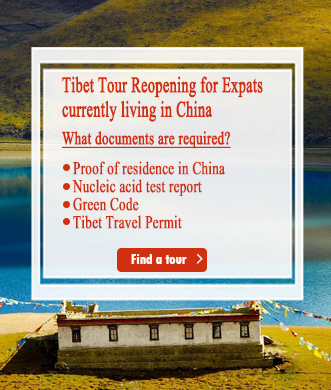
Nepal Tibet Travel
- Nepal Tibet Tours
- Visas for Nepal Tibet Travel
- Kathmandu Lhasa Overland
- How to Plan Nepal Tibet Tour
- Travel from Tibet to Nepal
- Get from Lhasa to Kathmandu
- Lhasa to Kathmandu Cycling
- Lhasa Kathmandu Railway
- China Nepal Friendship Highway
- Travel from Nepal to Tibet
- Kathmandu Lhasa Flights
- Get from Kathmandu to Lhasa
- Get from Kathmandu to Everest
- Get from Kathmandu to Kailash
- Things to Do in Lhasa
- Gyirong Port
- Get to Gyirong Port
- Gyirong Hotels& Hostel
- Nepal Tibet Border
Destinations in Tibet
Mount Everest
How to Travel from Nepal to Tibet
Traveling from Nepal to Tibet is to trace the footprints of ancient Nepalese Buddhist masters and scholars who trekked over Himalaya Mountains to spread Buddhism and other knowledge, to find out the hidden connection between these two greatest lands on Himalaya, also to enjoy the fantastic landscape that you can only see on the mysterious Roof of the World. No matter what motivates you for a Nepal Tibet tour, you currently has two ways of transportation to travel to Tibet from Nepal: by a direct 1.5 hours’ Kathmandu-Lhasa flight or overland driving journey. Find more guide below to get inspiration.
Why Travel from Nepal to Tibet
1. quickest way to get to tibet.
Bordering Tibet on the north, Nepal offers the quickest transportation to Tibet than any other country in the world. From Kathmandu, the capital of Nepal, travelers only need to drive about 90km to reach Gyirong Port on the Nepal-China border. Crossing the port, travelers can get to Mount Everest within a single day, then extend trips to Shigatse, Gyantse, Lhasa, Namtso, etc.
Useful Links: Kathmandu Lhasa Flights / Kathmandu Lhasa Overland Travel
2. No Need to Apply for A Full Chinese Visa
Traveling from Nepal to Tibet, travelers don’t have to get a normal Chinese Visa. The China Embassy in Kathmandu will issue a Tibet Group Visa which is a special single-entry visa allows foreign travelers to enter Tibet by overland trip or flight. Usually it take about 3~5 working days to obtain the group visa.
3. Plenty of Attractions along the Road
The overland route from Nepal to Lhasa, capital of Tibet, itself is a classic and popular traveling route which is full of stunning attractions, some of which are the bests in Tibet, such as Mount Everest, EBC, Sakya Monastery, Tashilhunpo Monastery, Palcho Monastery, Lhasa, Potala Palace, Jokhang Temple, etc. Most attractions are conveniently located near the driving road.
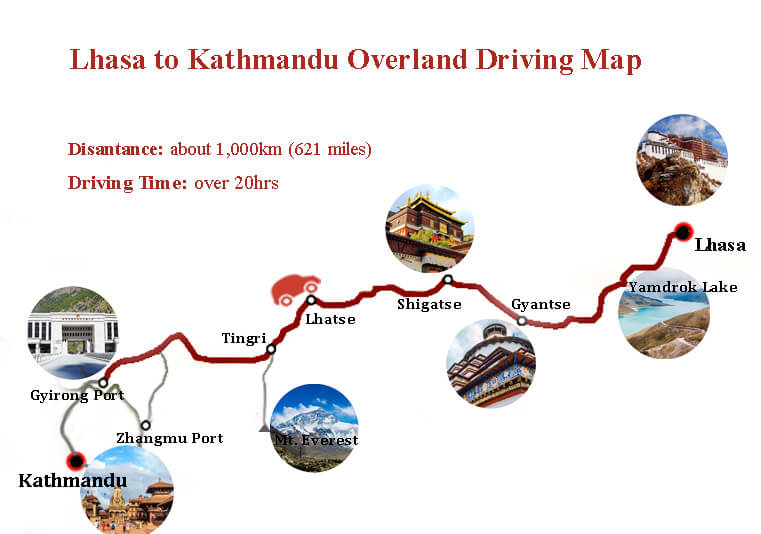
How to Plan a Travel from Nepal to Tibet
● nepal to tibet: by flight or by road.
Currently you have two options when you planning a trip from Nepal to Tibet - overland travel or flight travel. The most popular trip is the overland adventure from Kathmandu to Lhasa , via Gyirong Port, Mount Everest, Shigatse, Gyantse. There are also other overland itineraries you can take, such as Kathmandu Mount Kaillash Lhasa Overland, Kathmandu Tsetang Lhasa Overland, etc.
If you prefer flight travel, you can directly get to Lhasa from Kathmandu and miss groups of wonderful scenery along the route, since there is only one international air line between Nepal and Tibet. However, Tibet Discovery offers you flexible itinerary after arriving at Lhasa - explore Lhasa surrounding, overland traveling back to Kathmandu, or travel from Lhasa to China's other cities.
● How many days you have planned for your trip?
Generally speaking, a Nepal Tibet trip can either be short to 4 days , or long to more than 20 days . It depends on where you want to go in Tibet. The classic route Kathmandu Lhasa Overland needs at least 7 days. If you want to cover Mount Kailash in your trip, you have to plan at least 13 days. A biking trip from Kathmandu to Lhasa needs about 22 days.
● Make A Private Tour or Group Tour?
According to local laws, all foreigners are not allowed to travel in Tibet independently. Every foreign tourist has to take a private tour or join in a group tour, offered by a China travel agency. A private tour gives you more flexibility to arrange the tour length, itinerary and activities according to your personal interests. You will have your own private tour guide and driver, and enjoy the trip in a leisure pace. Traveling with a group tour, you will join other people in a fixed-departure date, and share the itinerary, vehicle and tour guide, which will greatly cut down your expense.
Contact us to customize your Nepal Tibet Tour, or find travel companion here!
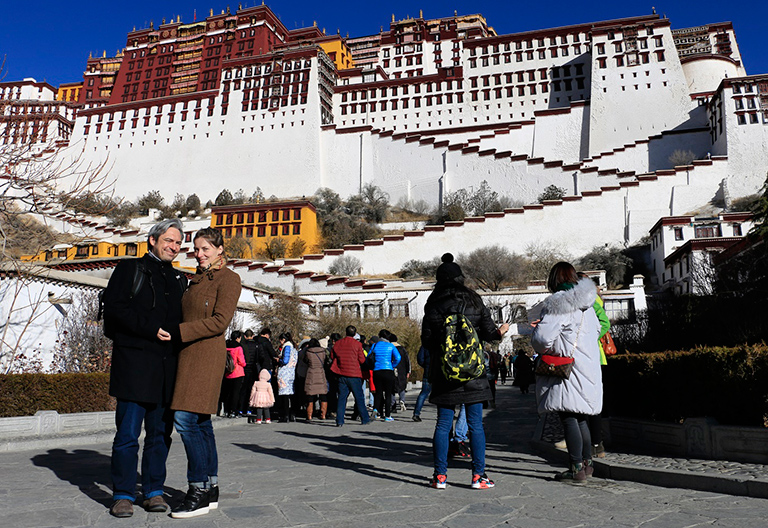
Kathmandu to Lhasa Overland via Mount Everest - Most Popular & Top Recommended
This tour is the one of our best-selling Nepal Tibet Tour Packages. It start from Kathmandu, goes northeastward to Lhasa. Highlights come along the way from beginning to the end. You will firstly have an exciting adventure on Mount Everest which is not very far away from Nepal side. Then you will travel to the Golden Triangle Destinations in Tibet - Shigatse, Gyantse and Lhasa.
Day 1~2 Nepal to Shigatse via Mount Everest
Drive from Kathmandu to Gyirong Port, and accommodate in Gyirong Town on the Day 1, then drive to visit Mount Everest on the Day 2. A highlight is Rongbuk Monastery, world’s highest-elevation monastery where can view Mt.Everest.
Day 3~4 Mount Everest to Lhasa
After visiting Everest Base Camp, drive to Shigatse City on the Day 3. The Day 4 is for you to travel from Shigatse to Lhasa and visit unique Palcho Monastery, imposing Karola Glacier and tranquil Yamdrok Lake on route.
Day 5~7 Lhasa Tour & Departure
Visit the most classic attractions in Lhasa on Day 5 and Day 6, including the grandiose Potala Palace, holy Buddhist sites Jokhang Temple, Drepung Monastery and Sera Monastery, also the exotic Barkhor Street and quiet Norbulingka, and depart from Lhasa at Day 7 by flight or train.
√ 7 Days Kathmandu to Lhasa Private Tour via Mount Everest
√ 7 Days Tibet Group Tour from Kathmandu
If you prefer a slower pace, you can extend this trip to 9 days - spending an extra night at Gyantse, and an extra visit to Sakya Monastery.
√ 9 Days Kathmandu to Lhasa Overland Tour via Everest & Tsetang
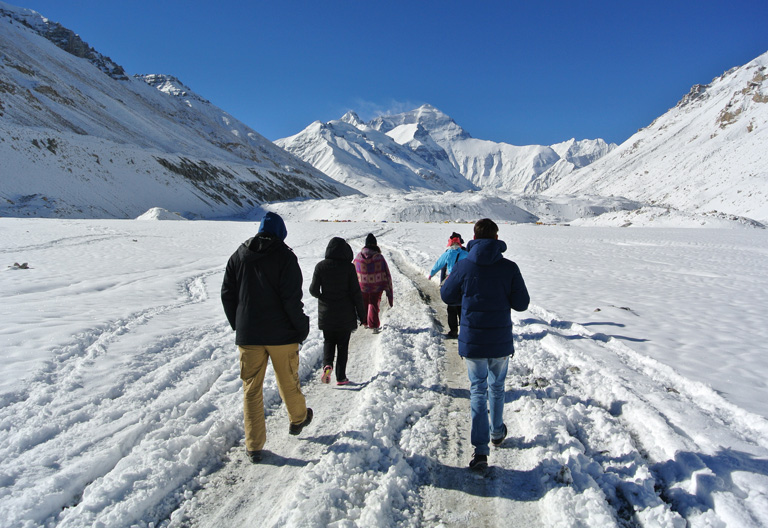
Kathmandu to Lhasa Overland via Mount Kailash - A Holy Pilgrimage Trip
This route is an in-depth Tibet tour which takes you to explore most of the best highlights of Tibet. After entering Tibet, you will firstly go to trek the holiest mountain in Asia – Mount Kailash, and visit Manasarovar Lake, then drive to National Highway 318, and travel to Lhasa via Shigatse, Gyantse and Yamdrok Lake.
Day 1~3 Kathmandu to Darchen
Mount Kailash is located in remote western Tibet, you have to spend three days on the road before getting to Darchen.
Day 4~6 Mount Kailash Trekking
In the following three days, you will trek around 50 kilometers to complete the Mount Kailash Kora.
Day 7~8 Drive from Darchen to Mount Everest
Long driving from Darchen to Mount Everest. But the landscape along the road is amazing. You may view spectacular Shishabangma and beautiful Padkuhd Tso lake from afar.
Day 9~10 Visit Mount Everest and Tour Shigatse, Drive to Lhasa
Enjoy morning sunrise in Rongbuk Monastery near the EBC in Day 9. During Day 10, go yo the Tashihunpo Monastery in Shigatse and Palcho Monastery, Gyantse Dzong later. In Day 11, drive to Lhasa via gem-like Yamdrok Lake.
Day 12~14 Lhasa Tour & Departure
Spend two days visiting the most classic attractions in Lhasa, such as Potala Palace, Jokhang Temple, etc, and depart from Lhasa at Day 14 by flight or train.
√ 14 Days Mount Kailash Tibet Highlights Tour from Kathmandu
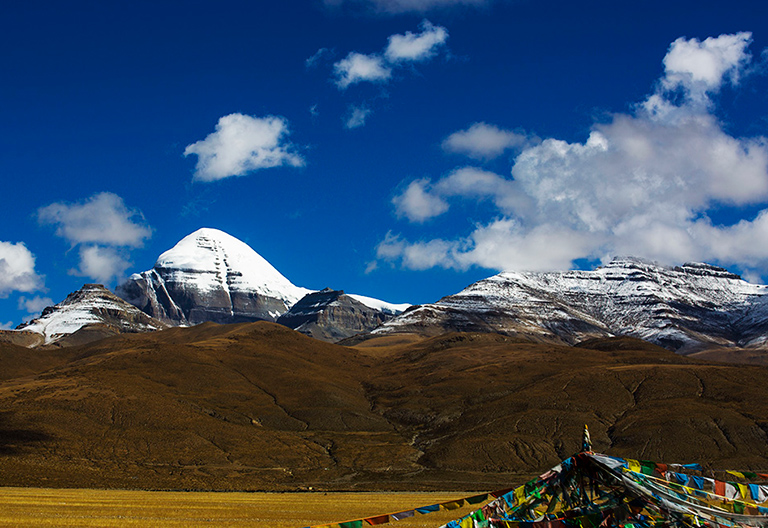
Kathmandu to Lhasa Tour by Flight
If your holiday is short, but you want to visit Nepal and Tibet both, then a Kathmandu Lhasa Tour by flight perfectly suits your plan. Usually, you can spend 3 or 4 days at each destination.
Day 1~3 Kathmandu & Surrounding Tour
Visit landmarks in Kathmandu Valley to sense its unique culture and history. Durbar Square, Swayambhunath Temple and Boudhanath Stupa are must-see spots in Kathmandu. Patan and Bhaktapur are two great cultural places too. You will take a side trip to Nagarkot to enjoy breathtaking scenery of the Himalayan.
Day 4 Fly from Kathmandu to Lhasa, Tibet
There are weekly flights between Kathmandu and Lhasa. The duration is less than 1.5 hours. Ready to be shocked by the snow-capped Himalaya peaks when flying over.
Start your sacred Tibet travel from the most precious miracle in Tibet - Potala Palace, then go to Jokhang Tempe, Barkhor Street in the first day. On next day, see the beautiful Garden palace - Norbulingka, to Drepung Monastery (“the Mother School of Dalai Lamas”) and observe how monks debate Buddhism vehemently in Sera Monastery. Last day is for packing and leaving.
√ 7 Days Kathmandu Lhasa Highlights Tour by Flight
For those who have finished tour in Nepal, Tibet Discovery also provides you well-organized Tibet tour from Nepal and nice driving journey back to Kathmandu. Basically, you need to spend over 1 week on the best highlights in Lhasa, Everest and Shigatse.
Day 1 Take a 1.5 hours’ flight from Kathmandu to Lhasa
Day 2~3 Visit most famous tourist attractions in Lhasa
Day 4~5 Transfer from Lhasa to Gyantse, Tour Gyantse & Shigatse
Day 6~7 Drive from Sakya to Mount Everest
Day 8 Drive to Gyirong Port to enter Kathmandu, Nepal
√ 8 Days Kathmandu to Lhasa with Mount Everest Adventure by Flight
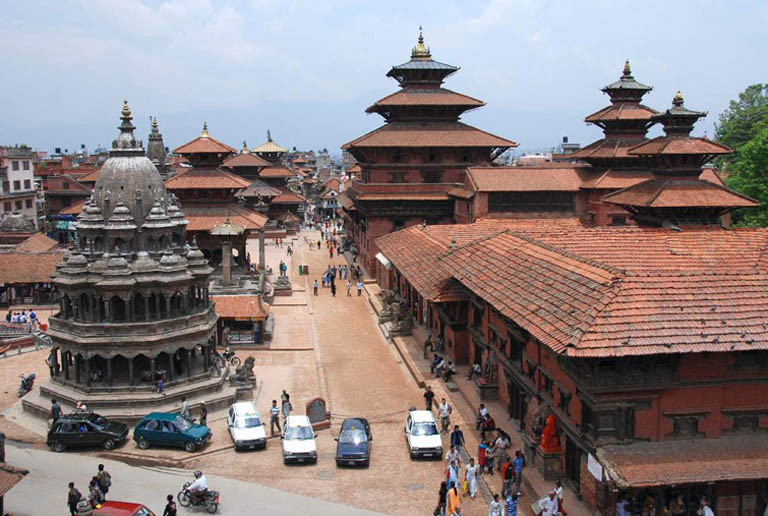
Necessary Visas & Permits for Your Nepal Tibet Tour
Before starting your travel from Nepal to Tibet, please note that you have to get several necessary travel documents with you, including the Tibet Group Visa, Tibet Entry Permit, Alien Travel Permit and Border Pass. If you want to extend your trip to Mount Kailash, you will to have an extra permit - Tibet Military Permit. Traveling with Tibet Discovery, you don't have to worry about how and where to get these permits. We will apply for all the needed permits for you.
Group Visa is a special kind of single-entry Chinese Visa for foreign travelers to enter Tibet from Nepal. Common Chinese Visa doesn’t allow foreigner to enter Tibet from Nepal. With this Group Visa, one can also extend its trip to other provinces and other cities in China. Travelers can only apply for this permit at China Embassy in Kathmandu City. Original passport is required for the application. The Group Visa requires at least 5 tourists traveling together. learn more >>
Our Helpful Advice: If you travel alone or less than 5 members, we strongly suggest that, you fly from Kathmandu to Lhasa with a layover in Chengdu. In that way, you can tour Tibet from Kathmandu without worrying about applying the Group Visa, a regular Chinese Visa just works.
Best Chengdu Tibet Tours Recommended:
√ 9 Days Chengdu Lhasa Kathmandu Overland Tour
Tibet Entry Permit
Tibet Entry Permit is foremost and compulsory for foreign passport holders to enter Tibet. Issued by Tibet Tourism Bureau, it is also called TTB permit. Without the permit, you can’t board your flight to Tibet or cross overland from Nepal, also will not be able to get other permits to continue to travel Tibet further.
Every non-Chinese passport holder, including US citizens, UK citizens, Australians, Canadians, Germans, Taiwanese, etc., has to obtain Tibet Entry Permit. It takes about 15~20 working days to obtain the Tibet Travel Permit. learn more >>
Tibet Border Pass
To pass the China-Nepal border area, travelers have to hold a Border Pass which is issued by Tibet Armed Police Border Corps in Lhasa. It can't be applied by travelers individually. One has to contact a Tibet travel agency to apply the Border Permit from the Tibet Armed Police Border Corps in Lhasa. learn more >>
Alien Travel Permit
When foreign travelers travel beyond Lhasa to other prefectures in Tibet, such as Shigatse, Shannan, Ngari, one has to have an Alien Travel Permit. The Lhasa to Kathmandu Cycling passes Shannan and Shigatse Prefectures. So the Alien Travel Permit is required. This permit can be applied after arrival in Tibet. Your tour guide will take you original passport and Chinese visa to apply for the permit. It usually takes only about 30 minutes to get the permit. learn more >>
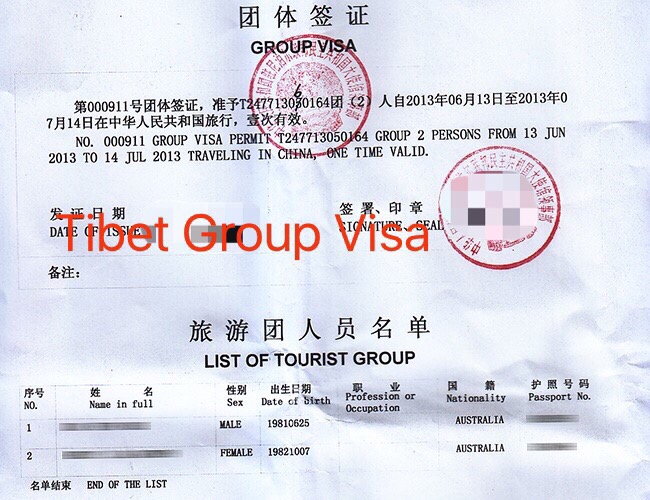
Recommended Nepal Tibet Tour Packages
Tibet Discovery Tours is specialized in finding unique experience of Tibet, and leading you to explore what interests you most. Our Private Tibet Nepal Tours will take you to explore deep into the Holy Land, with loads of options, freedom & flexibility. You can choose from the following hand-picked tour packages which have been successfully operated for many years and created loads of amazing experiences for our customers, or check more Nepal Tibet Tours >>

Kathmandu - Gyirong - Everest - Shigatse - Gyantse - Lhasa
7 Days Kathmandu to Lhasa Private Tour via Mount Everest
Highlights : Mount Everest, Tashilhunpo Monastery, Yamdrok Lake, Potala Palace
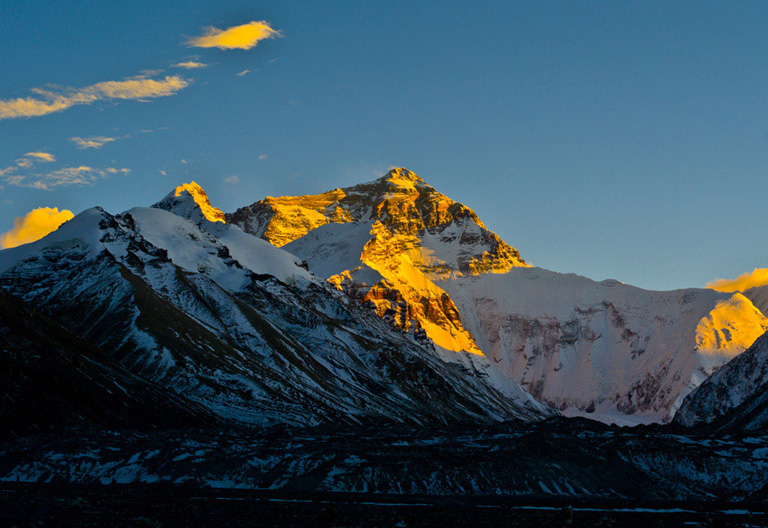
Kathmandu / Lhasa / Gyantse / Shigatse / Everest / Gyirong / Kathmandu
8 Days Kathmandu to Lhasa with Mount Everest Adventure by Flight
Highlights : Potala Palace, YamdrokLake, Tashilhunpo Monastery, Mt. Everest
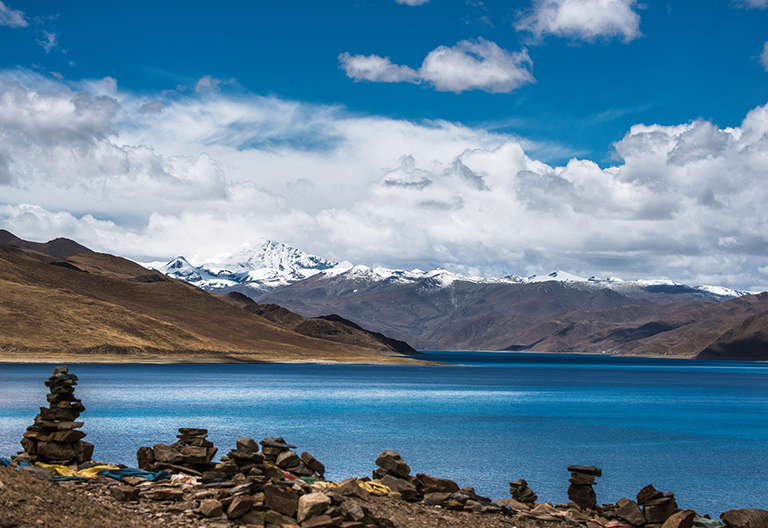
Chengdu / Lhasa / Shigatse / Gyantse / Mount Everest / Gyirong / Kathmandu
9 Days Chengdu Lhasa Kathmandu Overland Tour
Highlights : Panda Base, Potala Palace, Tashilumpo Monastery, Mt.Evrest
Prefer to tailor a trip that totally suits your budget and interests? Tell us your needs, and one of our friendly travel consultants will get back to you within 0.5~23.5 hrs.
Our specialists are always ready to help!
Have a question get answers from our travel experts soon.
- Your Question:
- Your Email:
Questions & Discussions
Following are latest questions and answers from our webusers and customers. You can learn many useful information from the discussion and cases. You can also join in the discussions or ask your own question. Our experts will help you ASAP.

"Amazing time in Lhasa"
"Excellent organization and very memorable trip"
"Fabulous trip through China and Tibet"
Tibet Tours
Tibet Group Tours
Tibet Private Tours
Lhasa City Tours
Tibet Everest Tours
Mt. Kailash Tours
China Tibet Tours
Beijing Tibet Tours
Chengdu Tibet Tours
Xining Tibet Tours
Shanghai Tibet Tours
Yunnan Tibet Tours
Xian Tibet Tours
Hong Kong Tibet Tours
Travel Advices
How to Plan Tibet tour
9 Things to Know
How to Get to Tibet
Tibet Travel Permit
Top Tibet Attractions
Best Time to Visit
High Altitude Sickness
Tibet Accommodation
Destinations Guide
Any questions, please email us at: [email protected] or call us at: +86-28-85227275 / 86-28-85223672 (Monday-Friday 9 a.m. to 6 p.m. GMT+8) 86-19138970032 (6 p.m. to 9 a.m. daily GMT+8) Copyright © 2011-2024. All rights reserved.
- Responsible Travel
- Our Service
- Payment Guide
- Testimonial
- Terms & Condition
- Privacy Policy

- Top 5 Tibet Tours
- Mt.Everest Adventures
- Cultural & Spiritual Tour
- Tibet Mt.Kailash Tours
- China Tibet Train Tours
- Tibet Trekking Adventures
- Overland Journeys
- Motorbike And Mountain Bike Tours
- Tibet Day Tours
- Tibet Winter tour
- Customise A Tour
- 4 Days Tibet Lhasa Tour Package
- 6 Days Tibet Culture Tour
- 8 Days Lhasa to Kathmandu Overland Tour
- 8 Days Tibet Everest base Camp Group Tour
- 10 Days Easy Acclimatizing Tibet Everest base Camp Tour
- 15 Days Kailash Mansarovar Tour
- Tibet Group Visa & Tibet Permits
- Tibet Travel Permit Online Application
- Tibet Group Visa vs Chinese Visa
- 5 Countries That No Require China Visa to Get Tibet Permit
- Important Tips to Apply the Tibet Group Visa
- How to get to Tibet?
- Tips to avoid high altitude sickness problem in Tibet tour
- Flights to Tibet
- 2024 Tibet Train Ticket Booking
- Hotels and Guesthouses in Tibet
- Meals and Restaurants in Tibet
- How to Plan Tibet Tour
- Health and Safety Guide
- Tibet Travel Maps
- Etiquette & Taboo in Tibet
- Tibet Attractions
- Tibet Travel Packing List
- Tibet Trekking Guide
- Tibetan Buddhism
- Tibet Weather & Climate
- Tibetan Culture & Arts
- Tibetan History
- Why Tibet Group Tours
- 2024 Tibet Festival Calendar
- Monasteries in Tibet
- Transportation in Tibet
- Clients Feedback
- Video Feedback
- Clients Travel Stories
- Why Travel With Us
- Our Community Projects
- We Are Highly Recommended By
- Our Staff Community
- Tibet Responsible Travel
- Privacy Policy
- +86-13398000993(Lhasa)
- [email protected]

- Tibet attraction
Traveling from Nepal to Tibet
The route from Nepal to Tibet is one of the most spectacular routes in the world , traveling from the stunning Kathmandu Valley in Nepal over the mighty Himalayas. By crossing the vast Tibetan plateau through Lhasa along the renowned Friendship Highway, and continuing along the famous Sichuan Tibet Highway. Finally can enter into the Mainland China and its cities like Chengdu, Sichuan Province.
The Sino- Nepal Friendship Highway is one of the most famous and commonly route used b y international travelers when traveling from Nepal to Tibet.
Table of Contents
Sino-Nepal Friendship Highway
Once you have crossed the border to Gyirong Port in Tibet, you will normally head straight to Gyirong Town, around 24 kilometers from the border. From the border itself to Lhasa, the Tibetan capital, it is a drive that covers around 836 kilometers, or around 520 miles.
The route from Gyirong to Lhasa partially follows the Sino-Nepal Friendship Highway, along the G318 National Highway, which is part of the vast highway that stretches from Shanghai in Eastern China to the Nepali Border at Zhangmu. From Gyirong Port, you will travel to Gyirong Town, around 24 kilometers to the north, where you will head east to meet up with the Friendship Highway at Nyalam, to the west of Old Tingri. From there, it is a long journey through Shigatse to Lhasa, although it is a straight and fast road.
The road from Gyirong Port to Lhasa is now one of the best roads in the region, in terms of condition. Since it has become a major route for tourists from Lhasa to get to Shigatse, Mount Everest, and on into Nepal, following the opening of the border crossing at Gyirong Port, the road has been upgraded with major renovation work, and is now an asphalt highway for its entire length.
Main Attractions Traveling From Nepal To Tibet
Mount everest regions.
The world’s highest mountain, Mount Everest lies on the border with Nepal and China, in the Tibet Autonomous Region. This stunning region of Tibet , known as the Qomolangma National Park, is one of the most stunningly beautiful parts of the plateau. There is an option on most tours across the plateau to take a slight detour from the Friendship Highway to visit the Everest Base Camp , the most popular destination in Tibet. The route from the main highway is around 100 kilometers long, and takes you to the base cap and the stunning Rongbuk Monastery, the highest Tibetan Buddhist monastery in the world.
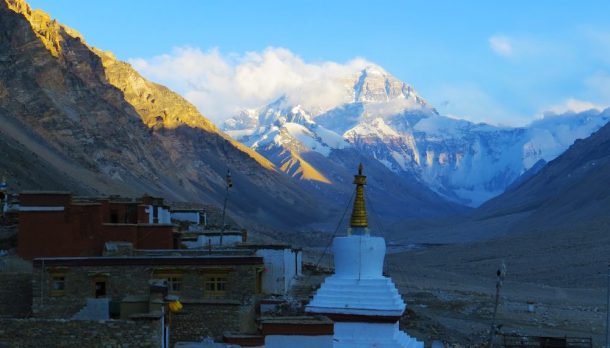
Shigatse is the second city of Tibet, and the home of the famous Tashilhunpo Monastery, the seat of the Panchen Lama, who is Tibet’s second highest incarnations after the Dalai Lama. Built in the 15 th century by the 1 st Dalai Lama, the monastery is one of the most important monasteries in Tibet, and was the center of local government in the Shigatse area for centuries. A prefecture-level city, Shigatse lies within the historical Tsang region of ancient Tibet, and is the current terminus of the Lhasa-Shigatse Railway , which will eventually extend all the way to Kathmandu in Nepal.
Yamdrok Lake
One of the Great Three Holy Lakes of Tibet, Lake Yamdrok lies nestled among the beautiful slopes of the southern Nyenchen Tanglha Mountains, to the southwest of Lhasa, around 115 kilometers by road. Believed to have been created by the Tibetan protector goddess, who threw nine talons of gold into the air to join the dozens of lakes that originally lay in the area, legend says that, if the lake should ever dry up, Tibet will no longer be habitable for the Tibetan people.
The capital of the Tibet Autonomous Region and one of the world’s most beautiful cities, Lhasa is the center of local governance in the region. Originally little more than a village, which was then known as “Rasa”, the city was built as the center of the Tibetan Empire under the reign of the 33 rd Tibetan King, Songtsen Gampo. The cultural and spiritual center of Tibet, the city’s main landmarks include the stunning Potala Palace and the sacred Jokhang Temple.
Continue from Tibet to Mainland China by Road
There are four roads that lead from Tibet to mainland China, in three different directions:
- The first, and most popular, is the Qinghai Tibet Highway, which runs from Lhasa to Xining, in the Chinese province of Qinghai, in northwest China.
- The second most popular is the Sichuan Tibet Highway, a long extension of the G318 National Highway, which runs east from Lhasa, and down to Chengdu, the capital of Sichuan Province.
- This is also part of what is known as the Yunnan Tibet Highway, the third route to China, which turns off from the Sichuan Tibet Highway at Markam, in the Chamdo Prefecture of Tibet. The road turns south into Yunnan from Markam, and runs to Kunming, the provincial capital.
- The fourth and final road from Tibet to China, the Xinjiang Tibet Highway, starts in Lhasa, and follows the Friendship Highway for part of its route, eventually heading north from Lhatse, into the Xinjiang Uyghur Autonomous Prefecture, ending at Kashgar.
Take the Train from Lhasa to Seven Cities in China
One of the most popular ways to get from Lhasa to mainland China is by train. The stunning Qinghai Tibet Railway runs from Lhasa, the capital of Tibet, all the way across the plateau to Qinghai Province to Xining, the provincial capital. Crossing the vast Tibetan plateau, and the immense Changtang Grasslands, the train leaves Tibet across the Tanggula Mountains, crossing the Tanggula Pass, the highest railway pass in the world, and then crosses Kekexili to the Kunlun Mountains to drop down to Xining.
This stunning journey is one of the most spectacular trips in the world, and offers travelers the chance to see parts of the plateau that they would otherwise not get to visit in the northeastern prefecture of Nagqu, Tibet.
It is also possible to get the train from Lhasa to one of six other gateway cities in China, including Guangzhou in southern China, Beijing and Shanghai in eastern China, Lanzhou in central China, and Chongqing and Chengdu in southwest China. With trips ranging from 22 hours to 55 hours, this is the ultimate in train travel in Asia.
Travel Documents required for Nepal Tibet China Tour
Group tourist visa.
If you are traveling to Tibet from Nepal, then you will not need to make the application for the Chinese Entry Visa with the Chinese Embassy before you travel. For visitors coming from Nepal, a Chinese Group Visa is issued by the Chinese Embassy in Kathmandu as a requirement for those crossing the border from Rasuwa Gadhi to Gyirong Port or flying from Kathmandu to Lhasa.
The visa is applied for once you arrive in Kathmandu, ready for your tour to Tibet, and takes around 3 working days to process, so you need to be in Nepal at least five working days before your expected date of travel.
The visa will be processed by our agent in Nepal, as personal applications are not permitted at the Chinese Embassy. The agent will collect your passport, and use that, and the Tibet Travel Permit, to make the application. Applications submitted on a Monday morning before 11:00 am will be available for collection by the agent on Wednesday afternoon.
Tibet Travel Permit
The most important permit you will need for traveling to Tibet, the Tibet Travel Permit is required for all international tourists to the region, and is needed to get into Tibet and travel around the area of Lhasa.
The permit can take around 20 days to process, so it is important to book your tour in advance to allow for the processing period. The processing requires a scanned copy of your passport photo and information page, and will be applied for by us once you have booked your tour. The Tibet Travel Permit cannot be applied for personally, and cannot be provided without a pre-booked tour. It is also needed to board the plane to Lhasa.
Alien’s Travel Permit
If you are traveling outside Lhasa, then you will need to have an Alien’s Travel Permit, which allows you to travel to the unopened areas of Tibet outside the capital , such as Shigatse Prefecture and Mount Everest. This is applied for by us once you have booked your tour and is required for you to cross the border into Gyirong County of Shigatse Prefecture. You will also need the Frontier Pass, which we will also apply for on your behalf, for all travelers entering Tibet from Nepal or traveling in the area of the Chinese borders with Nepal, India, and Bhutan.
- Share This Post:
Recent Posts

Exploring Tibet

The Best Tibet Tours for Every Adventurer

10 Must-Visit Destinations for Every Traveler
All categories.
- About Tibet
- book a Tibet tour
- Buddhism Practice
- Budget Tour
- China-Tibet Train
- Customized Tibet tour
- Historical Sites
- Hot Springs in Tibet
- Photography in Tibet
- Tibet Group Visa
- Tibet Motorcycle Tour
- Tibet Small Group Tours
- Tibet Tours and Tibetan Tour Guide
- Tibet Train
- Tibet Travel FAQs
- Tibet Travel Information
- Tibet Travel News
- Tibet Travel Permit Update
- Tibet Travel Prices Rises
- Tibet Trekking Tour
- Tibet weather and climate
- Tibet Wildlife animals
- Tibet Winter Tour
- Tibetan Cultural Features
- Tibetan Culture and Poeple
- Tibetan Festivals
- What to see in Tibet
Reset Password
How to Plan a Tibet Tour 2024: Expert Tips
Commonly referred to as the "roof on the world", Tibet has the world's highest "castle" — the Potala Palace and the world's tallest peak — Mount Everest (altitude 8,848 meters). Tibetan Buddhism dominates the cultural landscape, and there are many Buddhist monasteries scattered across Tibet.
Content Preview
- 1. Can I Visit Tibet Now?

2. How to Get a Tibet Permit
3. it is safe to visit tibet.
- 4. Things Not to Do
5. Best Times to Travel to Tibet
- 7. Tips for Seniors and Children
8. Tibet Travel Insurance
- 9. How to Get to Tibet?
1. Can International Travelers Visit Tibet?
Yes. But please remember , independent travel is not allowed : you will need to go on an organized tour provided by a certified travel agent who will also provide your Tibet Permit.
Send us your inquiry if you would like some provisional help with planning. To ease your concerns, You enjoy 100% refund of any payments made to China Highlights prior to 3 weeks before departure ( detail⇒ ).
Updates : Travelers from visa-free countries just need to provide us with passport photos to apply for a Tibet permit if your itinerary in Tibet is less than 15 days.
Applying for a Tibet permit is a different process from getting you r China visa . Application from individuals is not accepted: it must be done through a travel agency.
Fortunately, it is easy for us to handle all the procedures and we can 99% guarantee your Tibet permit success . With our step-by-step guidance, applications are almost always successful. The procedure is as follows:
If you are from a visa-free country, just disregard this step.
No matter whether it is a group tour or a private tour.
If you are from a visa-free country, just send your passport to us.
Normally it will be posted by express mail to your pre-Tibet stop.
Except for L (Visitor/Tourist) Visa holders, you are also required to provide proof of a place at your company/school .
For expats in China , you will need to provide a work/study certificate .
Don't worry: your travel agency (we) will give you guidance in preparing all the items.
As far as personal security goes, Tibet is a safe place with a low crime rate. Even if you walk around Tibet alone in your free time, your personal security is not expected to be threatened.
When walking in the streets of Lhasa you will find lots of police stations , and armed policemen can be seen everywhere in the streets. They are normally on duty 24/7.
As a pure land with devoted Buddhist people, wherever you go a wide smile will be there to greet you.
With an average elevation of 4,500 meters (15,000 feet) above sea level, probably your biggest concern is altitude sickness in Tibet.
It is perfectly okay for ordinary people to travel to Tibet, including seniors or kids , however, it is suggested that you consult a doctor before traveling if you have a heart problem or high blood pressure.
Oxygen cylinders will be available in the vehicle for every China Highlights customer during your stay in Tibet.
You may want to read more about staying healthy in Tibet .
4. Things Not to Do When Planning a Tibet Trip
- Don't book your tour any later than 10 days before departure to ensure we have (your travel agency has) plenty of time to apply for Tibet permits.
- Don't book flights before the Tibet permit is issued, especially during this COVID-19-affected period. You might find that a Tibet Permit is required to confirm a flight booking, but your permit cannot be obtained until 2–7 days before your tour! It is better to ask a travel agent (us) to organize your flight tickets as it is easy for them (us) to handle all these problems, as well as cancel flight tickets if there is any travel ban due to COVID-19, etc.
- Don't plan your Tibet trip for March. Tibet will be closed to foreign travelers during the Tibetan New Year period, which is usually in February/March and is based on the Tibetan calendar. During this period, it is worth considering other Tibetan regions such as Qinghai , Sichuan , and Yunnan , which have many of the cultural and scenic attractions that Tibet does without access restrictions.
- Don't arrange a tight schedule in Tibet to sure your tour arrangement is as flexible as possible. You may need more time to let your body get used to the high altitude. See How Long to Spend in Tibet
- Don't make changes to your itinerary (such as pre-Lhasa city or travel destinations in Tibet) once your Tibet Entry Permit is issued, otherwise, you will need to apply for a new one! Please do tell your travel agency (us) in advance if you want to make any changes to your Tibet plan.
The weather in Tibet is largely affected by altitude . Therefore, even in the same month, the temperature in southern (low altitude) and northern (high altitude) Tibet can be very different.
Every season has its advantages and characteristics. Exploring Tibet in different months shows you different scenery and cultural activities for different travel experiences.
Spring (April to May) is best to enjoy less-crowded attractions and a favorable rate of hotels (except for the Labor Day holiday: May 1-5). The peach blossom in Nyingchi is really worth seeing.
Summer is best for seniors and kids because the air's oxygen content is higher during this period. You can enjoy most of the sights in Tibet when nature is at its most vibrant and also experience rich festivals. Local people make their living by growing barley and raising yaks there every summer. You can take part in the work of local Tibetans . In the evening, you can cook and enjoy dinner with a local Tibetan family. While it's more crowded than other months, there are higher costs due to the higher demand for flights, trains, and hotels.
You can travel to every place in Tibet during autumn , which provides the year's best weather for hiking . The most popular trekking trails by far are the Everest Base Camp Trek and the Mount Kailash (Yatra) Trek — a famous pilgrimage route. It is also the best time to admire the breathtaking snow-capped Mount Everest when the sky is particularly blue, the air is clean and dry, and there are few clouds.
Winter is Tibetan people's leisure time and many of them choose to make a pilgrimage trip to Lhasa from their various Tibet regions. Small religious activities can be found in many corners of Lhasa. In winter, blue glaciers are an unusual and striking feature of Tibet, with ice cracks and bubbles all over the frozen lakes, the huge ice blocks appear to be a charming blue color. It is also a good time to enjoy the favorable rates of hotels. See 5-Day Tibet Winter Tour
See more on Best Times to Visit Tibet .
6. Budget for a Trip to Tibet
The budget depends on where, when, how many people, how many days, hotel class, private or group tour, transport, and other requirements you may have.
You could get the approximate price from our 8-Day Tibet Tour (based on 2 people for a private tour) for reference. The price of 8 days would be about USD 2200 per person, including private transfers in Tibet, meals, admission fees, guiding, hotels, etc.
To make the most of your budget, you are suggested to book a few months in advance to enjoy some early booking discounts or travel with more than four people to share private tour costs.
If you have a holiday in winter, travel to Tibet in December or January to enjoy the special winter rates including discounts on hotels, airfares, and entrance tickets.
7. Tips for Traveling with Seniors and Children
- Make sure any seniors and children in your group are healthy enough to visit Tibet by consulting a doctor. Seniors with cardiovascular diseases or chronic respiratory ailments are not suggested to travel to Tibet.
- Stay in Lhasa for 2 days for acclimation before touring any wider in Tibet.
- Traveling with a wheelchair is not convenient in Tibet , as most of the attractions are located on hillsides without a chairlift or elevator, which means those in wheelchairs will miss the Potala Palace and monasteries. But it is fine to visit places with flat roads in a wheelchair, such as Barkhor Street, Jokhang Temple, and Lake Yamdrok.
- Children under 4 years old are not suggested to visit high-altitude regions in Tibet, such as Everest Base Camp (5,200 m), Mount Kailash (4,700–5,600 m), or any place over 4,500 m. Lhasa (3,800 m), Lake Yamdrok (4,000 m), and Nyingchi (3,100 m) are perfect choices for them.
- Be sure your children can well express how they are feeling to identify symptoms of altitude sickness.
- Bring some snacks for your kids , as the foods in Tibet will probably not be to their liking — most of the dishes have a heavy flavor and will be quite strange to them. However, if your children are adventurous eaters, this could work out well.
- If you are a family with 2 adults and 1 kid , your family can simply sleep in one bed if there is enough space or ask for an extra bed or cot.
- If your family has 2 adults and 2 children or more, it is better to book adjoining rooms (rooms are often connected by a door). This type of room is limited in availability and not provided in every hotel, please ask our travel advisor to choose hotels for you.
During our over 20 years of experience , we have organized Tibet tours for customers from 4 to 82 years old . Please do tell us about any special requests you have , and our professional travel advisor will solve any problems for you.
You may want to read more tips and suggestions on How to Deal with Altitude Sickness .
It is wise to get travel insurance when you travel to Tibet. Here is what you need to consider when selecting your policy:
1. It is better to get "cancellation for any reason" insurance in case of a sudden closure of Tibet (although this is not frequent, it could happen at any time). Booking with China Highlights, you enjoy free cancellation up to 22 days before departure for your Tibet tour or other China tours.
2. Check if it covers an emergency medical evacuation, which could help you quickly descend or leave Tibet if you suffer severe altitude sickness.
3. If you plan to trek in Tibet, check if your policy covers trekking in Tibet.
4. Check if your travel insurance includes medical expenses for your trip to Tibet in case you need medical services in a hospital there (due to altitude sickness).
5. Other typical air travel issues should be covered, for example, a snowstorm closing down your airport before you can board your flight to Tibet, or arriving only to find your luggage is on its way to another city…
Based on what we know from our previous customers, the most popular insurance companies are InsureMyTrip and World Nomads.
9. How to Get to Tibet? — Easiest from China
Broadly speaking, there are two ways you can enter Tibet: from China's cities or from Nepal , but the easiest way by far is from the China side.
Travel from China's cities
There are direct flights from China's major cities to Lhasa in Tibet, such as from Beijing , Shanghai , Chengdu , and Chongqing . The most frequent and reliable flights to Tibet are from Chengdu, with about eight flights per day.
Trains to Tibet depart from these cities: Beijing, Shanghai, Guangzhou , Xi'an , Chongqing , Lanzhou , and Xining .
Xining is the best place to start the train journey, as it is the beginning point of the most beautiful section of the Qinghai-Tibet Railway with the shortest train journey to Lhasa (20–22 hours), compared to around 30–50 hours for further departure points.
See more details on How to Get to Tibet .
Example: the Best Way to Travel to Tibet from the U.S.
1. Book a flight from a USA city to a China city: Beijing, Shanghai, etc.
2. Spend a couple of days in your China arrival city to get over jet lag.
3. Take a flight to Chengdu , which is the best city for connecting flights to Lhasa (almost all flights to Tibet stopover in Chengdu). You could happily stay a night in Chengdu — home to China's giant pandas — and spend a day sightseeing in the city before going to Tibet.
A wonderful panda volunteer keeper program experience would be worth a day there.
4. Take a morning flight from Chengdu to Lhasa (2½ hours) so that you can have plenty of time for acclimation in the afternoon before you sleep to avoid altitude sickness effects as much as possible.
On your return journey, you could experience the Qinghai-Tibet Railway from Lhasa to Xining with beautiful scenery along the way , and then take a flight from Xining to a large city in China for the flight home.
Traveling out of Tibet by train will help you successfully get train tickets. Lhasa-Xining train tickets are five times easier to buy than Xining-Lhasa tickets! This also means you can save a lot on the ticket booking fee.
Tips: Taking a flight into Tibet is better than a train because a good sleep in a hotel in Lhasa is much more helpful to altitude acclimation than spending a night on the train.
Most passengers find it more difficult to fall asleep on the train, and tiredness makes altitude sickness more uncomfortable.
You may need information about How to deal with altitude sickness in Tibet
Travel from the Nepal Side
There are two ways into Tibet from Nepal: by flight and by road .
You should first consider issues of a China visa and Tibet Entry Permit , no matter whether you'll go by flight or road. Procedures are different from traveling from a Chinese mainland city to Tibet.
Y ou must apply for a China visa and Tibet permits in Nepal via a travel agent . Any China visa issued in your resident country will be invalid for Tibet travel. You will need to stay in Kathmandu for at least 3 working days to wait for the visa and permit.
By road, you can travel from Kathmandu to Lhasa via the Gyirong border (possibly with a convenient side tour to Mount Everest).
For more, see How to Travel from Nepal to Tibet .
- 8-Day Beijing–Xi'an–Shanghai Private Tour
- 11-Day China Classic Tour
- 14-Day China Natural Wonders Discovery
- 3-Week Must-See Places China Tour Including Holy Tibet
- How to Plan Your First Trip to China 2024/2025 — 7 Easy Steps
- 15 Best Places to Visit in China (2024)
- How to Plan a 10-Day Itinerary in China (Best 5 Options)
- 2-Week China Itineraries: Where to Go & Routes (2024)
- China Weather in January 2024: Enjoy Less-Crowded Traveling
- China Weather in February 2024: Places to Go, Costs, and Crowds
- China Weather in March 2024: Destinations, Crowds, and Costs
- China Weather in April 2024: Where to Go (Smart Pre-Season Pick)
- China Weather in May 2024: Where to Go, Crowds, and Costs
- China Weather in June 2024: How to Benefit from the Rainy Season
- China Weather in July 2024: How to Avoid Heat and Crowds
- China Weather in August 2024: Weather Tips & Where to Go
- China Weather in September 2024: Weather Tips & Where to Go
- China Weather in October 2024: Where to Go, Crowds, and Costs
- China Weather in November 2024: Places to Go & Crowds
- China Weather in December 2024: Places to Go and Crowds
Get Inspired with Some Popular Itineraries
More travel ideas and inspiration, sign up to our newsletter.
Be the first to receive exciting updates, exclusive promotions, and valuable travel tips from our team of experts.
Why China Highlights
Where can we take you today.
- Southeast Asia
- Japan, South Korea
- India, Nepal, Bhutan, and Sri lanka
- Central Asia
- Middle East
- African Safari

- Travel Agents
- Loyalty & Referral Program
- Privacy Policy

Address: Building 6, Chuangyi Business Park, 70 Qilidian Road, Guilin, Guangxi, 541004, China


Borders Of Adventure
Leading Culture and Adventure Travel Blog by Becki Enright. Looking at the world with a different angle to change perceptions of misunderstood places, for the best in travel.
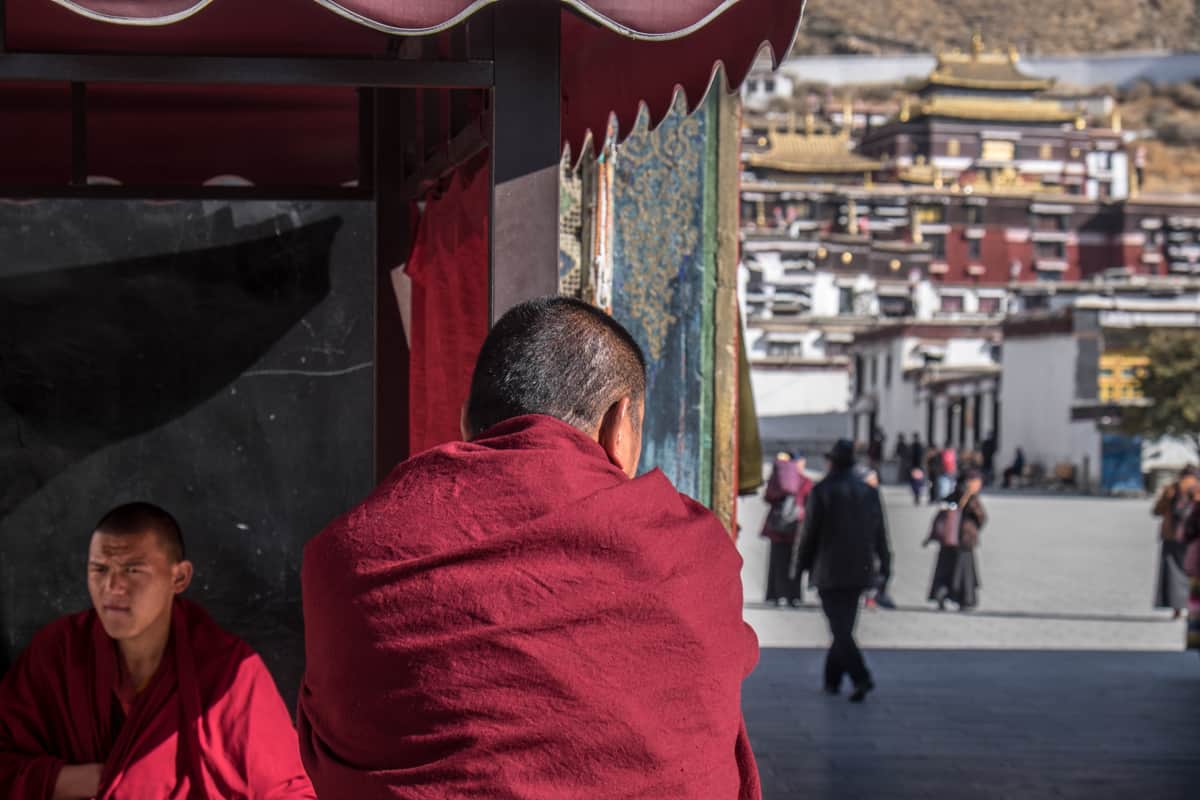
Misunderstood Destinations , Tibet
This is How to Travel Tibet – The Reality of the Roof of the World
Disclaimer: This post contains affiliate links to handpicked partners, including tours, gear and booking sites. If you click through or buy something via one of them, I may receive a small commission. This is at no extra cost to you and allows this site to keep running.
How to travel Tibet and experience its ancient culture. Everything you need to know about how to enter, getting around, and the truth in visiting.
To be able to travel to Tibet is both a privilege and a different kind of experience that requires some degree of more profound observation. What was once closed off to outsiders and one of the most isolated cultures globally is now an Autonomous Region of China. Therefore, it is more tricky to traverse since you can’t travel there independently.
While China heavily manages Tibet tourism, visiting means helping to keep Tibetan culture alive and experiencing those pockets of Tibetan Buddhism so profoundly entrenched in the form of spiritualism you won’t witness anywhere else.
Your visit is about using your freedom to return home to tell the world about it.
You won’t forget your time in Tibet easily, but it is a place where some pre-romanticised ideas shatter, and you leave with more questions and emotions than when you first arrived. It’s a mix of fascinating otherworldly spiritualism in mountainside monasteries and palaces and nunneries and temples. It’s the sadness at seeing a long history eroded that conflicts with such remarkable beauty.
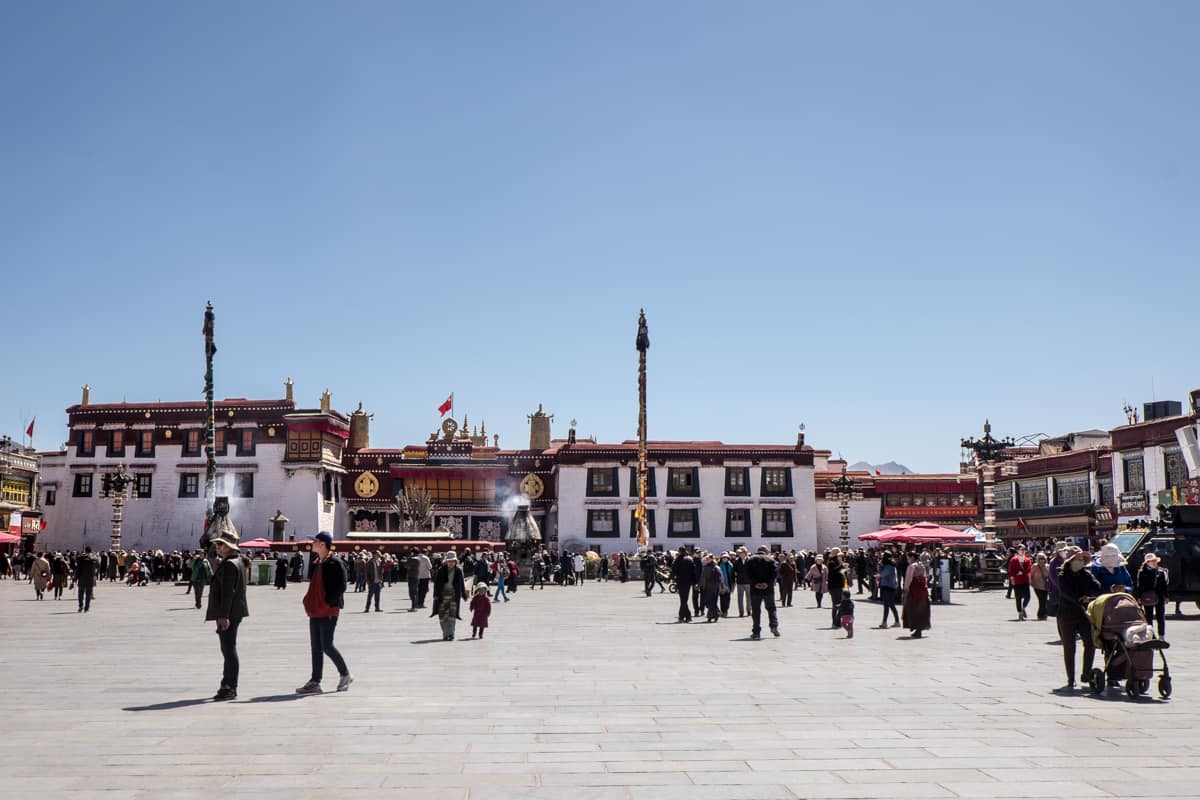
Tibet Today
Why you should travel to tibet, the reality of tibet travel, getting a group visa for tibet, travel tibet from china, travel tibet from nepal, getting around tibet, the best time to visit tibet, how much does it cost to travel to tibet, is tibet safe to travel, responsible travel in tibet, rombuk and everest base camp tibet, kyirong border town to nepal, essentials and extras, avoiding altitude sickness in tibet, travel to tibet guide – pin it.
What remains of old and sacred Tibet – left untouched after China’s occupation in 1950 that turned Tibet into what is now known as the Tibet Autonomous Region – is a testament to its mysterious and spiritual history and the retelling of it.
Today, seeing Tibet is about getting lost in an ancient culture that dates back to nearly 1,500 years, set within lake-filled valleys and rocky plateaus. To set foot inside some of the world’s oldest monasteries and temples, flanked by the endless peaks and ridges of the Himalayas that naturally hug Tibet in protection, with mighty Everest watching over.
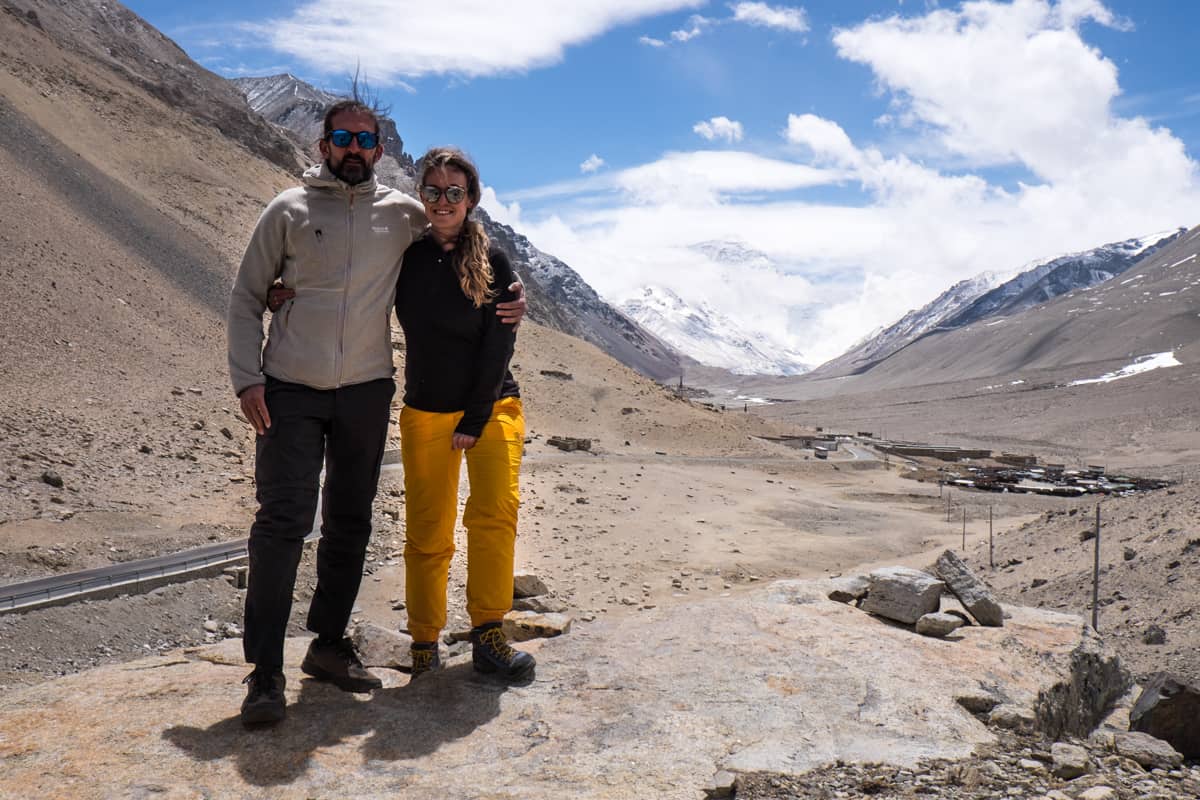
The view of Mount Everest near Everest Base Camp, Tibet
It’s about understanding that while there are plenty of things to see in Tibet, swaths of its original wonder no longer exist. Patches of a far-reaching space we should not take for granted as visitors here when so much has already been lost.
Tibet is best experienced via an overland tour and one covering a lot of ground. On the two-week High Road to Tibet trip with G Adventures , I flew from Kathmandu to Lhasa, spent four days in the Tibetan capital before moving on to Gyantse, Shigatse, Rombuk and Everest Base Camp Tibet for the final highlight. An overnight stay in the border town of Kyirong was the last stop before the long and scenic drive back to Kathmandu.
Choosing exactly how to travel in Tibet and embarking on this particular trip goes hand in hand with travelling responsibly and supporting Tibetans in keeping their culture and traditions alive.
Here’s how to make the most out of your Tibet visit, alongside logistics and how best to experience and support the ancient Tibetan culture and its people.
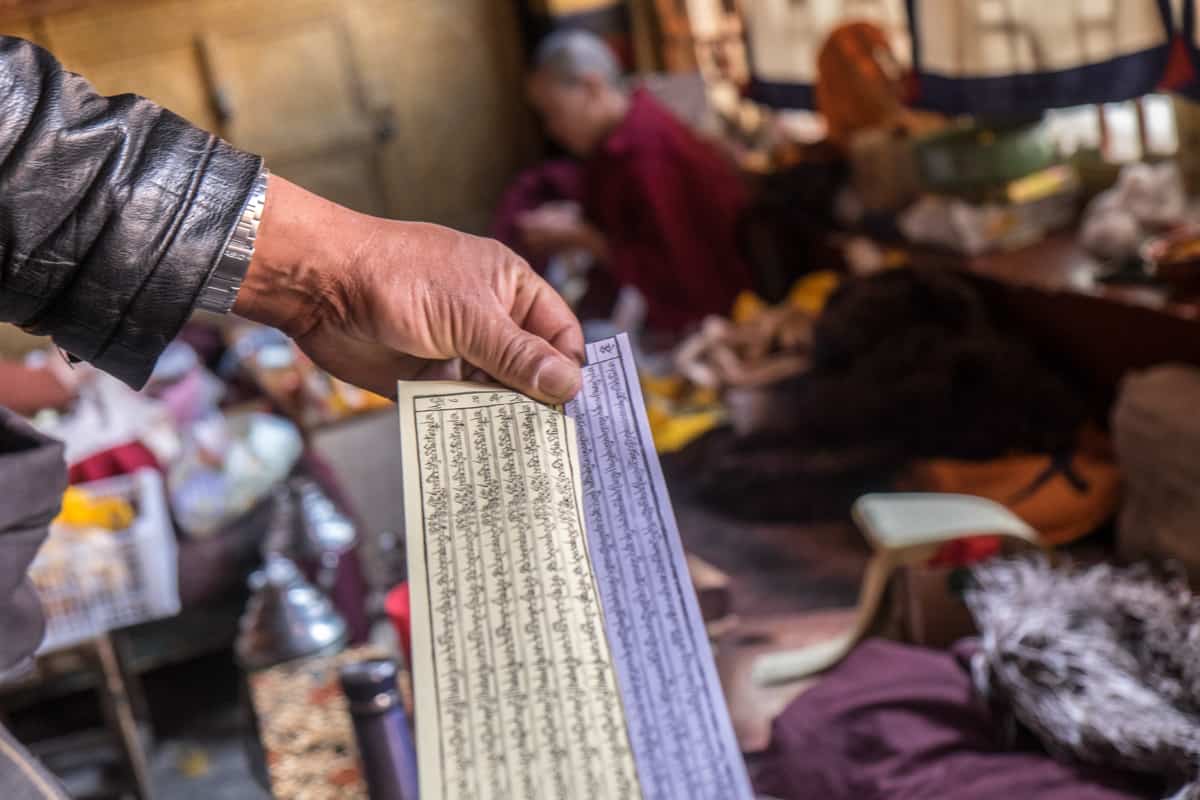
Is it Ethical to Travel Tibet?
The question of whether it is ethical to visit Tibet is a justified one, but without an easy answer and one that you should make from a personal but informed choice.

On the one hand, the Dalai Lama encourages travel there to see the country first-hand and bring those stories home. That’s what I wanted to do. Your presence is a chance for Tibetans to know of the outside world and know that people can witness their beliefs and then return home and tell people about their incredible culture.
On the other hand, your visa money doesn’t go to any form of Tibetan organisation. I struggled with that. Since Tibet is now under Chinese rule, the rights to travel in Tibet and who can enter the country is determined by China. Tibetan religious sites that have been left intact are for tourism dollars, and therefore it’s hard (although possible) to keep all your expenditure in the hands of Tibetan enterprise.
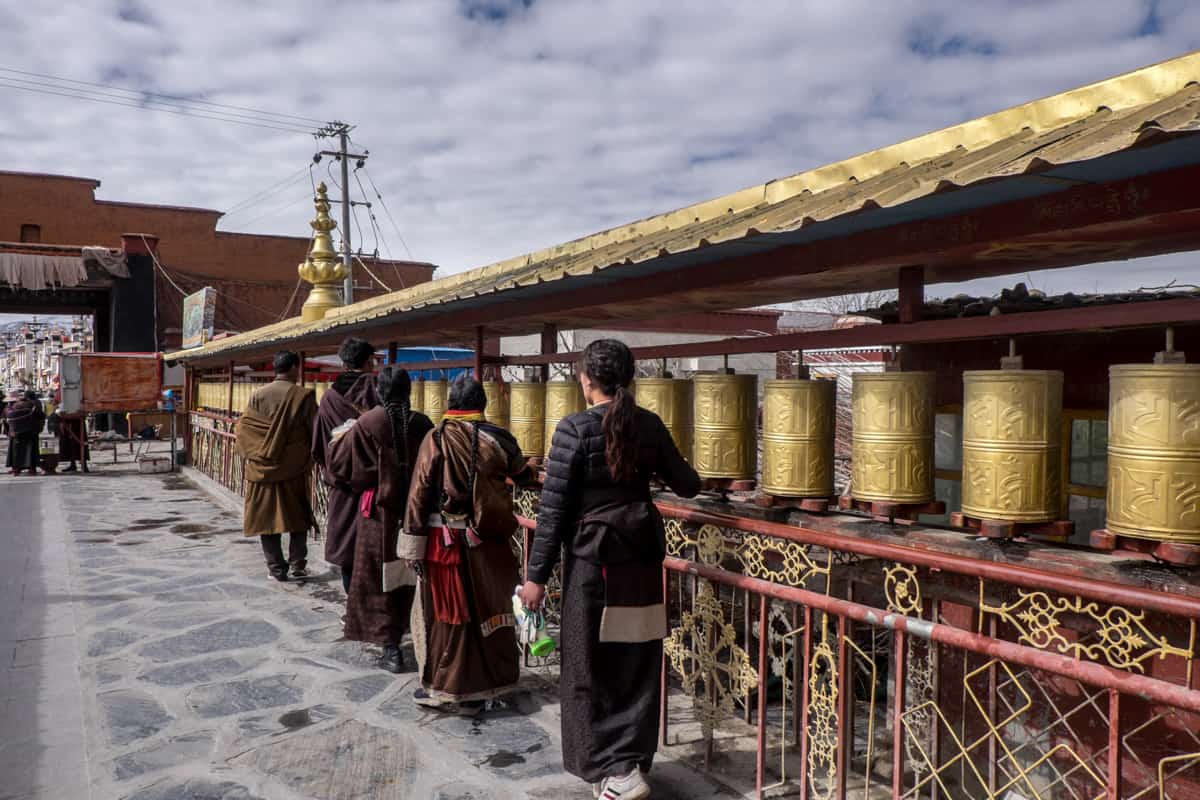
You’ve made your decision to go and experience this destination steeped in intrigue, but what is it really like to go to Tibet?
You will hear from your guides as you make your way through the region that thousands of Tibetan sites were destroyed during the Cultural Revolution after the Tibet Autonomous Region of China was formed 60 years ago. It is patchy information since the history of the country or mention of the Dalai Lama cannot be spoken of in detail or publicly, even if it is evident to you as a visitor. It would be best if you did your background research at home before visiting.
What remains are the Tibet sites considered most important and sacred, which you enjoy throughout your journey across the country.
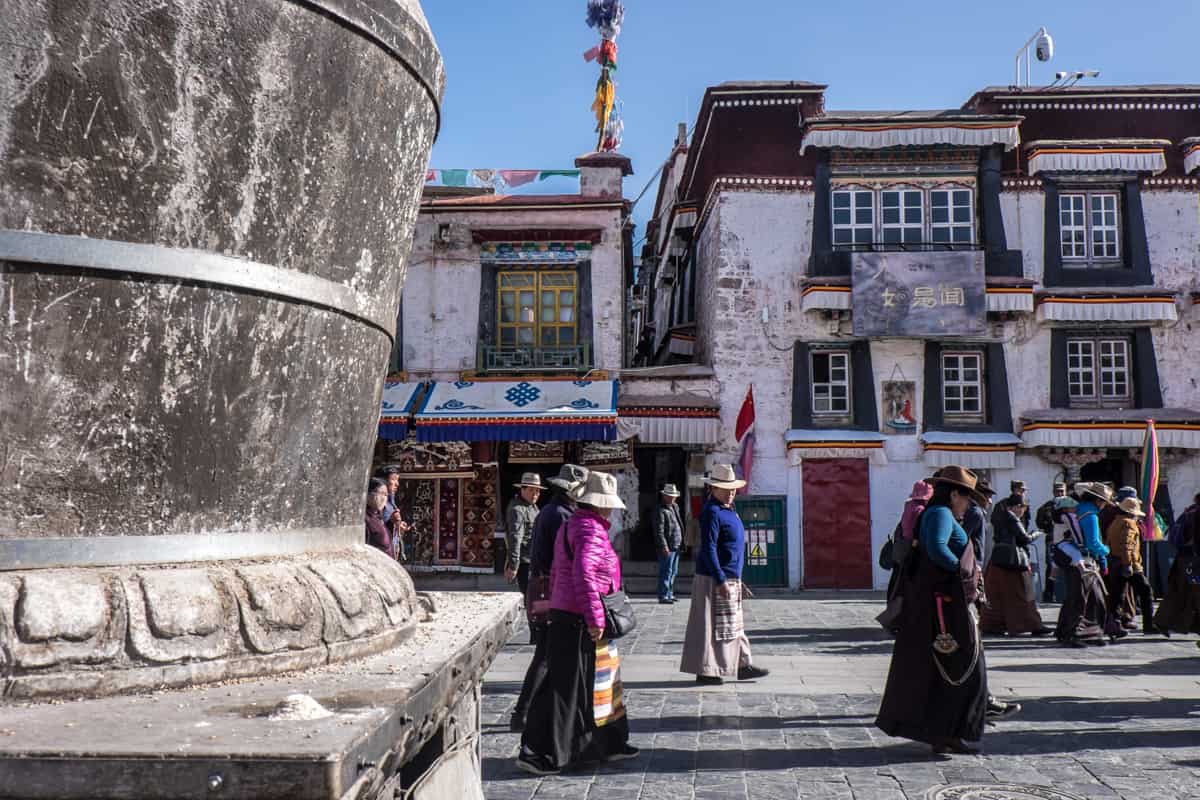
Chinese surveillance and military presence is something you too may notice, including CCTV cameras and plain-clothed guards that often appear close to tourism groups when visiting significant sites. These monitoring systems are not something to be afraid of, and you quickly get used to them as a part of travelling here.
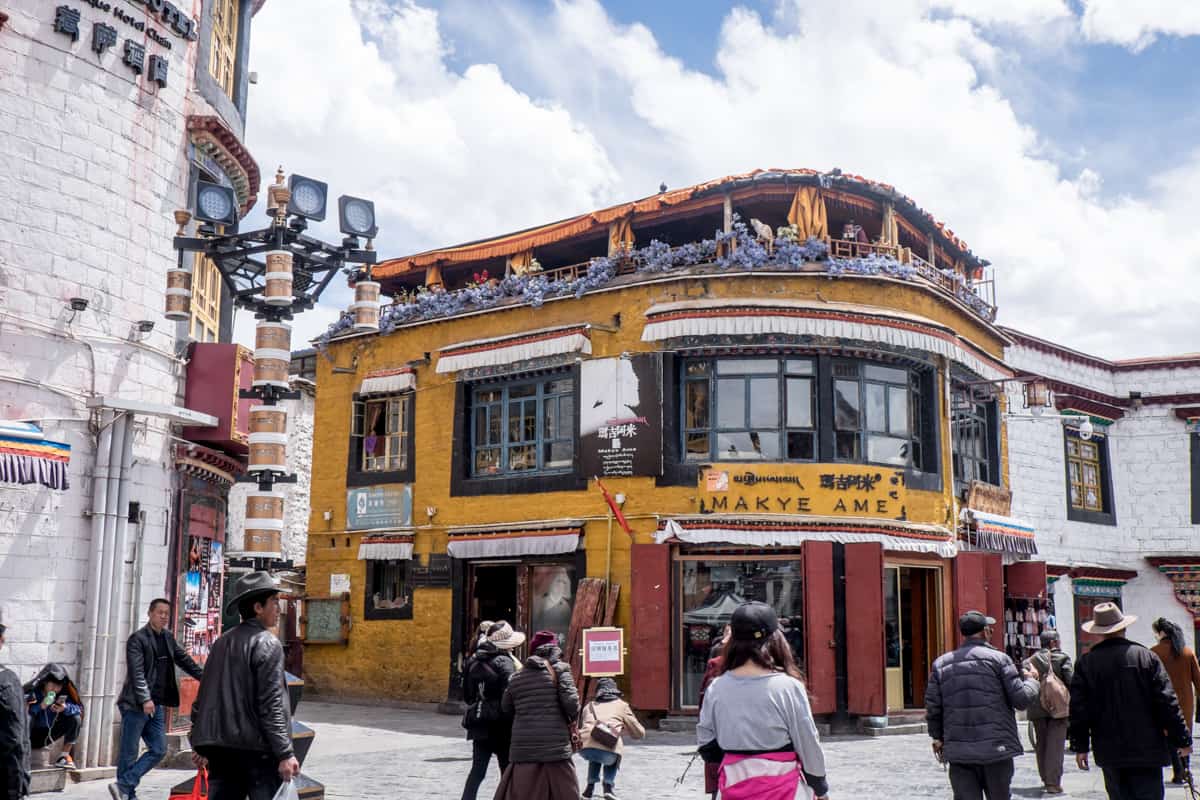
For example, when some excited Tibetan ladies wanted their photo with me, it was a form of interaction that created some level of paranoia. So I kindly shut down the situation more quickly than I would generally. It’s better for everyone and the reality of where you choose to travel and adhering to rules.
The organisation of tourism in Tibet also means that your itinerary is pre-approved and cannot be altered. This means that speed restrictions and police checkpoints along the journey (according to your trip schedule) are a requirement for your group. However, the simple reality is that often your Tibetan guide shows the relevant documents and all passports, which makes the process quicker and easier.
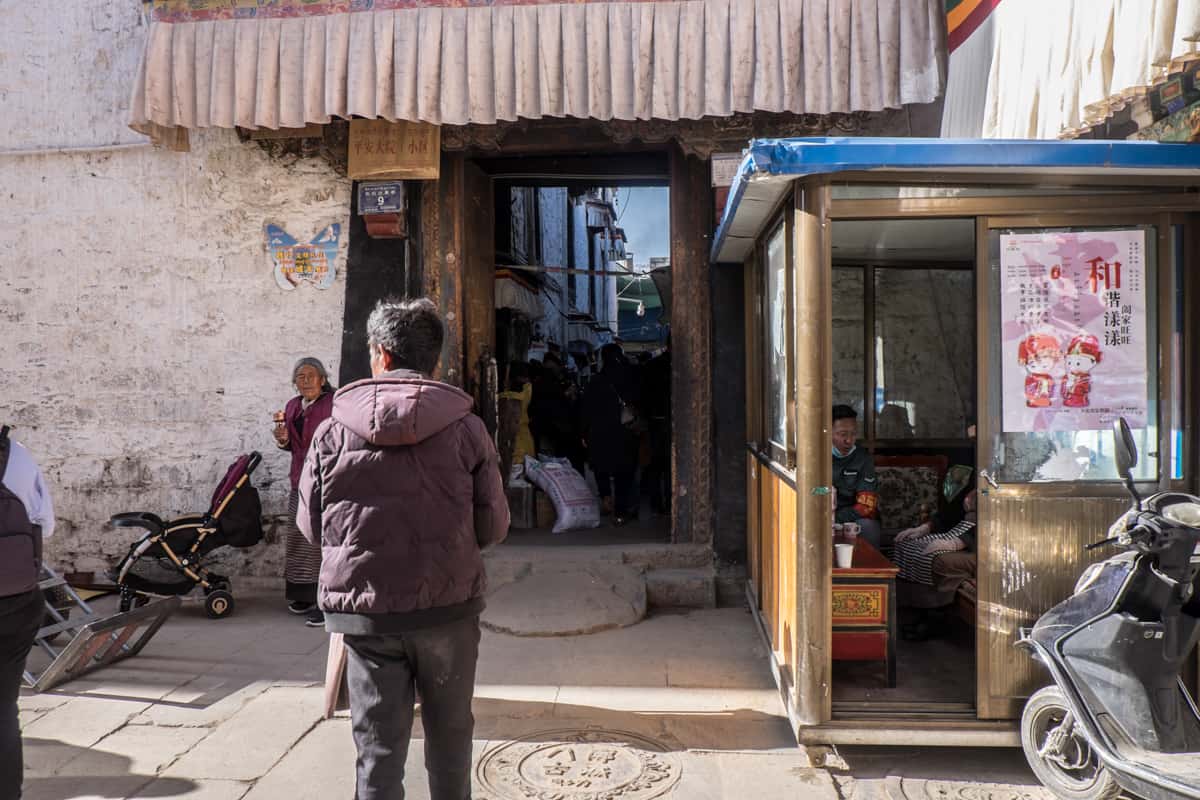
A typical checkpoint in Lhasa, Tibet
It also means adhering to specific rules and regulations at particular sites of enormous significance. The only time you will encounter inner-city police checkpoints is in Lhasa at the Jokhang temple. Given its large-scale importance, the temple has been the leading site of protest, and it’s standard procedure for the square outside of the temple to be guarded and for the army and plain-clothed officers to be present on the Barkhor sacred Kora path.
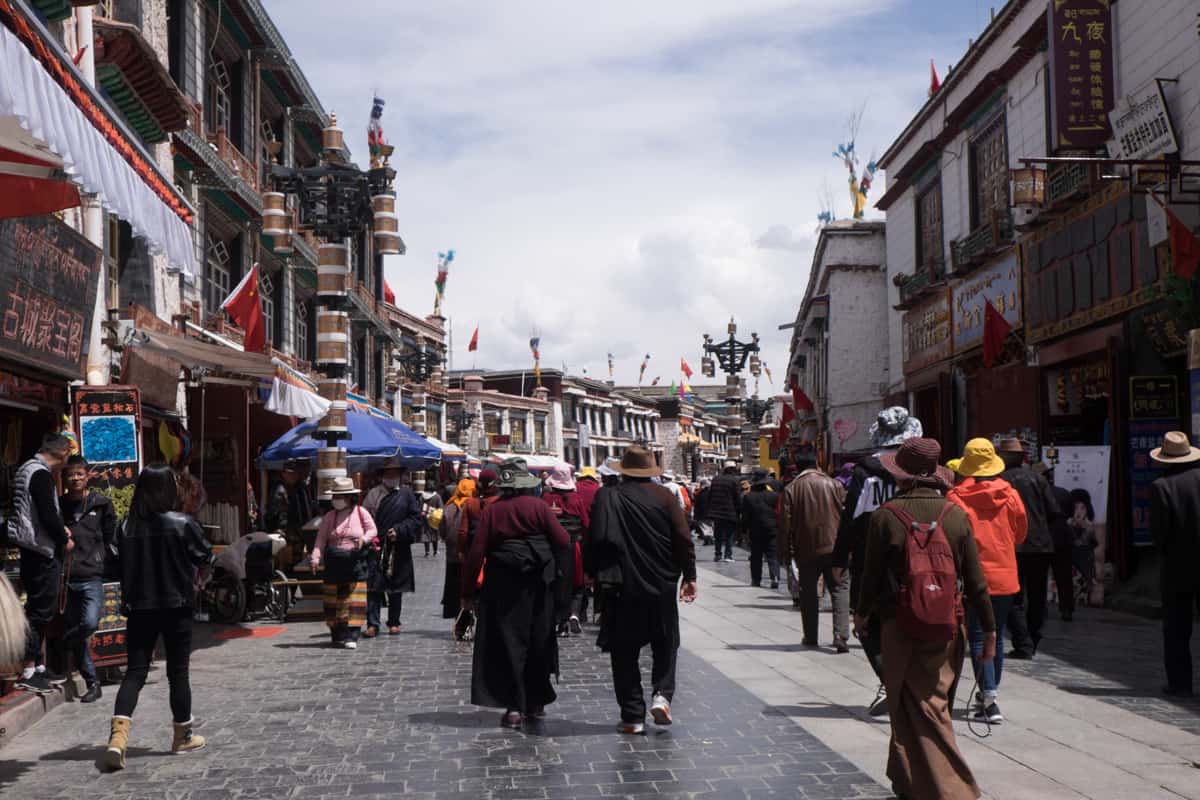
Walking the circular, sacred Kora path in Lhasa
If exploring alone in your free time, you simply show your passport and state where you are staying and your Nationality (the standard questions). We never encountered any issues going through, and we visited more than once to enjoy the incredible atmosphere of the Kora.
You can also only enter Potala Palace in your group and with your local guide, and you need to bring your passport for the restricted 50-minute viewing slot. Why such tight measures? Potala Palace is a pillar of Tibetan culture and remained the Dalai Lama’s primary residence until the 14 th (current) Dalai Lama fled to India in 1959 . The Dalai Lama is a strong point of contention, which you will realise on many levels throughout your trip.
There’s a lot to soak in, where you’ll be spiritually moved and emotionally stirred in equal measures.
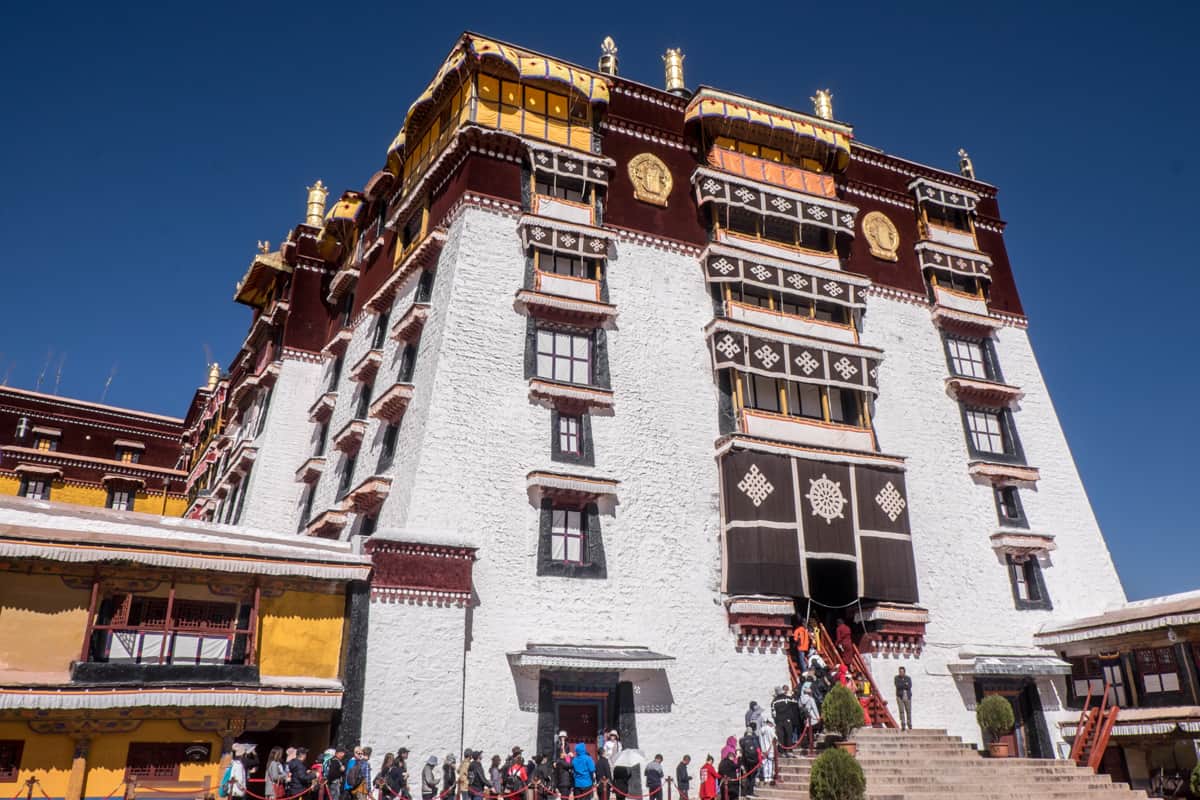
The queue at the entrance to Potata Palace, where visits are restricted to a 50-minute viewing slot
How to Visit Tibet
You cannot travel independently in Tibet and can only do so with a private guide as part of a small group . Therefore a third-party organiser must obtain a group visa for Tibet before entry.
Three days before our scheduled flight to Tibet, our group met in Kathmandu to submit details for the group visa processing.
Each of us had a four-page form to fill out, which is very much like any visa form. It asks for passport details, where else you have travelled on your particular passport in the last few months, points of contact and for a detailed breakdown of your day to day itinerary. Our G Adventures CEO (Chief Experience Officer) helped us with this process, ensuring we all had the exact itinerary and dates listed in a clear format.
Images for Tibet Visa
The images needed for the Tibet visa was tricky since nearly every person in our group had to get their passport photos redone that same evening. We were all briefed via trip notes beforehand regarding not having ears covered, needing a white background, no obvious make-up or any piercings. Even if there was a little hair covering a part of an ear, the photo had to be retaken. So much so that the women in the group were clipping every strand of their hair back.
Again, we did this as a group, ensuring we had a photographer at the passport store in Kathmandu who was briefed about our specific image request.
Application of Visa
Our Nepali CEO took our forms, photos and passports to the relevant agency and embassy for processing. It was an agonising wait to know if we could get into Tibet or not (with an itinerary in Nepal for two days to fill the time). It was a horrible feeling not having our passports.
It was a gut-wrenching wait at the airport with just over one hour until our flight from Kathmandu to Lhasa, waiting for the group visa to turn up via a China embassy worker who delivers the paper via motorcycle. Our cheers were the signal that the adventure was just beginning.
Browse dates and book a Tibet trip here.
How to Get to Tibet – Arrival and Getting Around
There are three ways to travel Tibet – via a flight to and from Lhasa or by overland via train or private vehicle.
Those who join groups in China fly mainly from Beijing or other cities on the Lhasa flight circuit. Taking a train to Tibet is doable only from China via one of the following cities – Beijing, Chengdu, Guangzhou, Shanghai, Chongqing, Lanzhou and Xining- and is subject to your particular itinerary and booking.
I chose to travel to Tibet from Nepal, soaring over the Himalayas via a flight from Kathmandu to Lhasa. This flight route also allowed for the grand adventure of being able to overland in Tibet and travel back to Kathmandu in a loop that took around ten days.
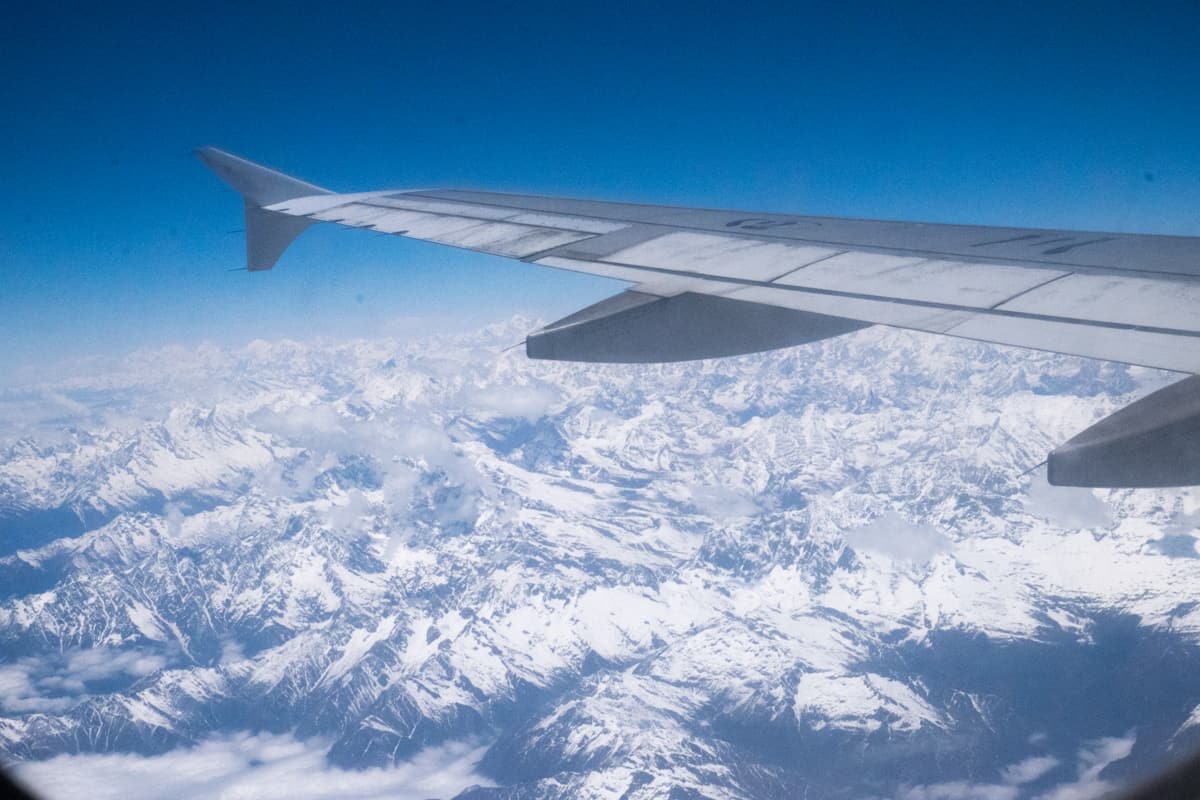
I picked this particular tour because of its Nepal start and endpoint, as I did not want to travel from China for my ethical reasons about where I spend my money. Nepal is also a country close to my heart, where I encourage people to visit and contribute to the local economy.
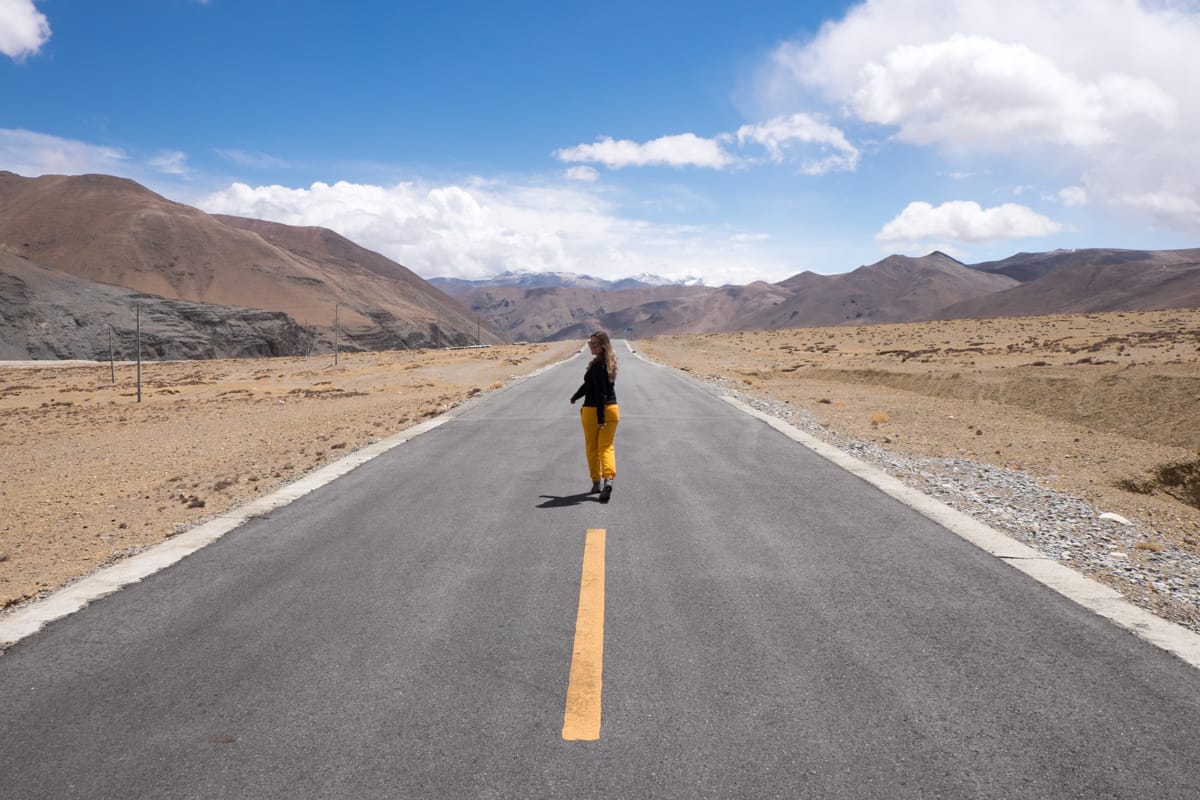
As per the group visa and organisation rules, you can only travel around Tibet with an organised guide and private vehicle and driver.
Solo travel and the use of public transport are not permitted for foreign travellers. We rode the local bus in Lhasa for a few stops, but we were with our guide.
This private guide and vehicle also apply since you must arrive at designated police checkpoints in your route by certain dates and specific times. At times you will be asked to get out and present your passport one by one in your group before continuing with the next leg of the journey.
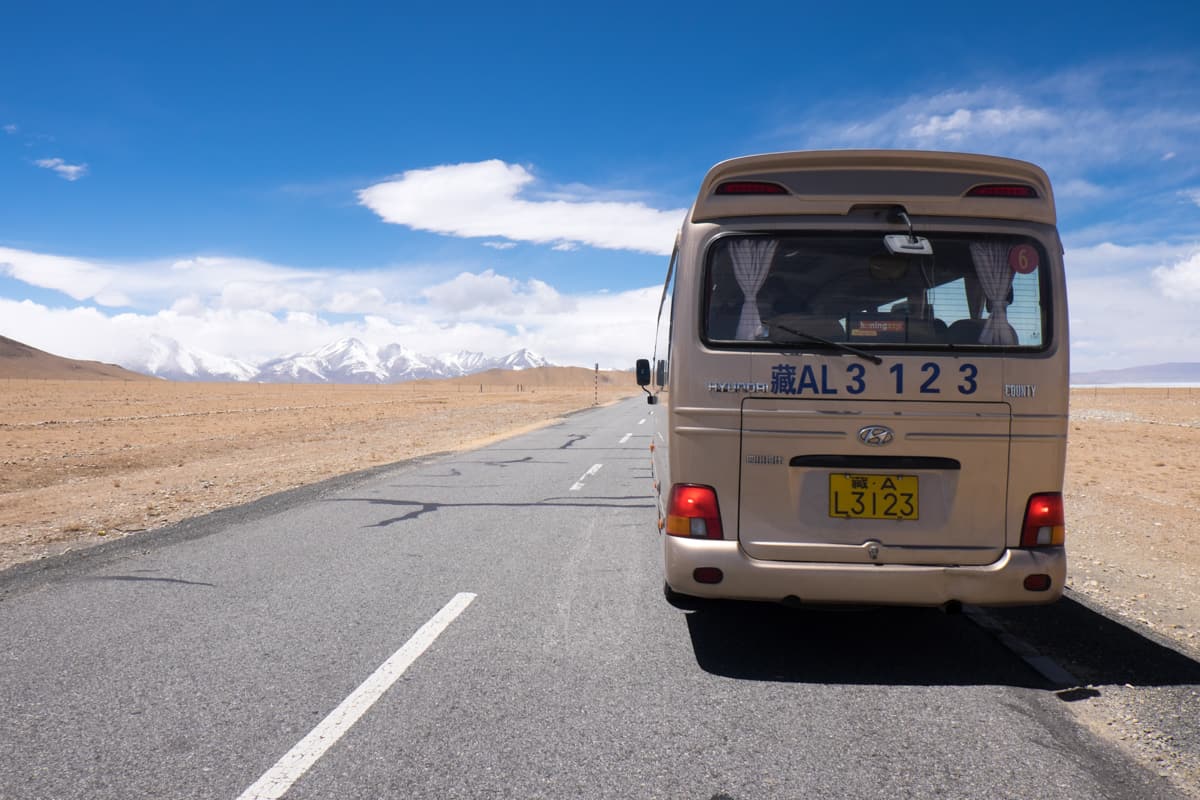
The season typically starts in mid-April and runs until October, covering the spring, summer and autumn months in Tibet. The height of summer can be stifling, which is why it’s best to try and get on one of the first tours in April or the last remaining in October .
Tibet isn’t closed for tourism because of the weather, more so for the New Year’s Losar Festival in late February or early March and is closed during political dates such as the anniversary of Chinese occupation at the end of March.
One thing that can’t be changed is Tibet’s incredible scenery. The dominant background of the Himalayan strip of peaks is one of the best things about this trip.
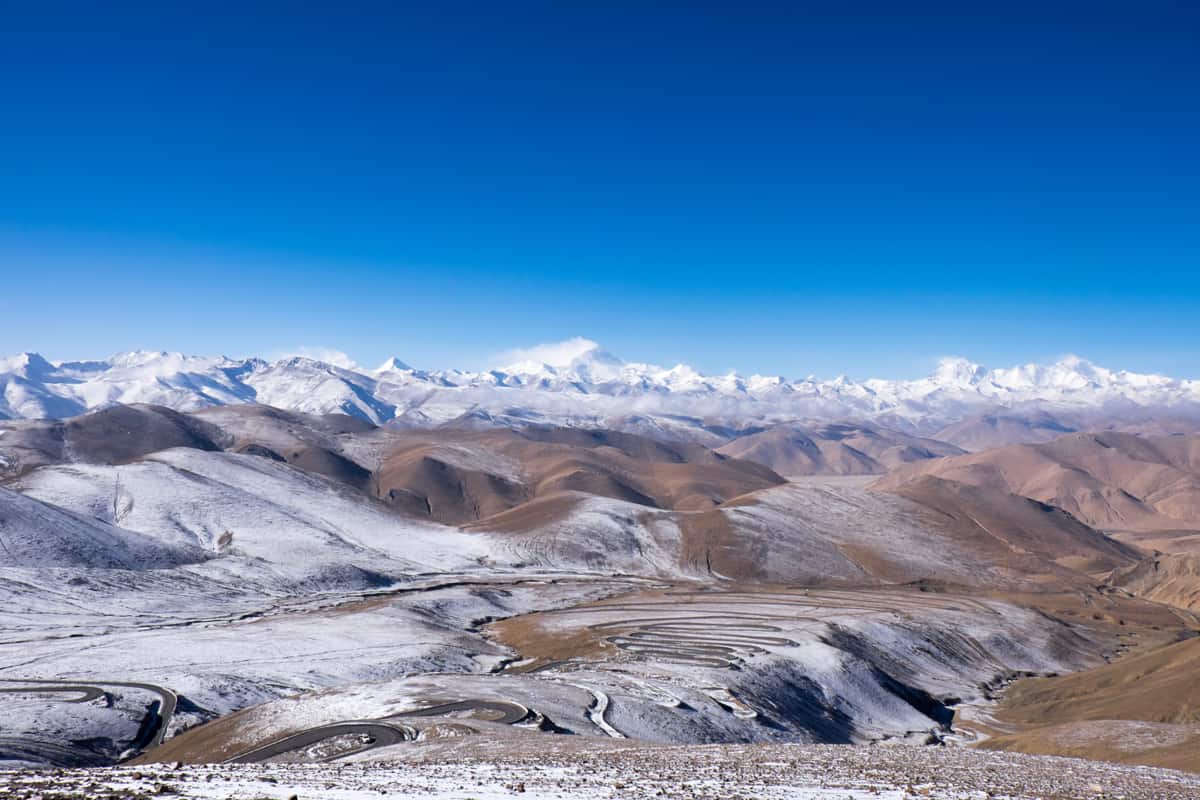
With all these elements in mind, regarding group travel and a group visa, a private guide and vehicle, alongside organised activity, visiting Tibet isn’t a budget experience.
However, with prices ranging from €2,200 – €2,800 (dependent on what time of the year you go), Tibet is a once in a lifetime opportunity.
The cost also encompasses all elements of facilitation from visa organisation, the flight and point-to-point travel.
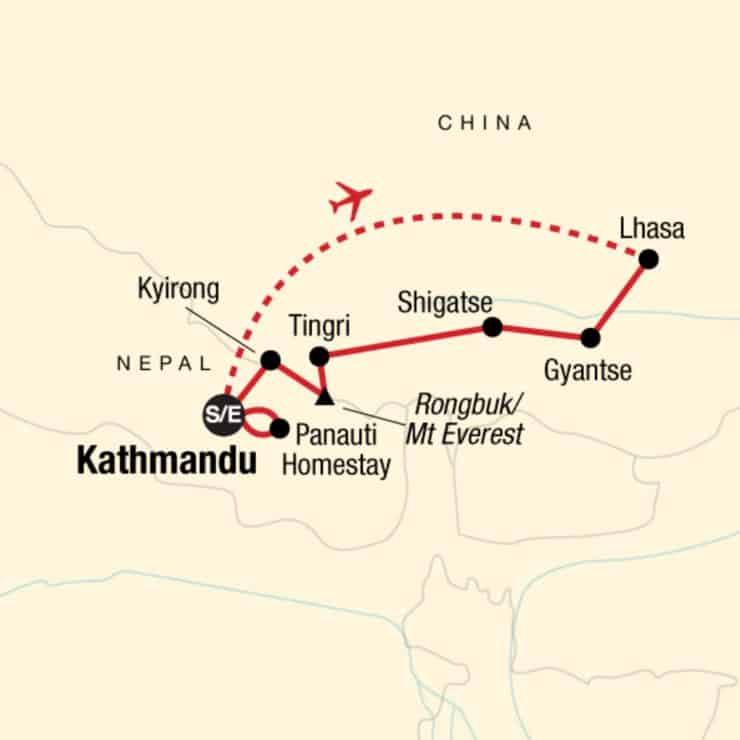
The extra costs aside from the tour cost itself were:
- Cost of the Nepal visa ($30 for 15 days, $40 for multiple entries if staying for more days before or after your trip)
- American and Brazilian: 195 USD per person
- Canadian and Romanian: 150 USD per person
- Israeli: 104 USD per person
- All other nationalities: 114 USD per person
- Food and drink costs (Approximately €400 for two weeks)
- Money for extras such as souvenirs and some entry prices for extra excursions or activities
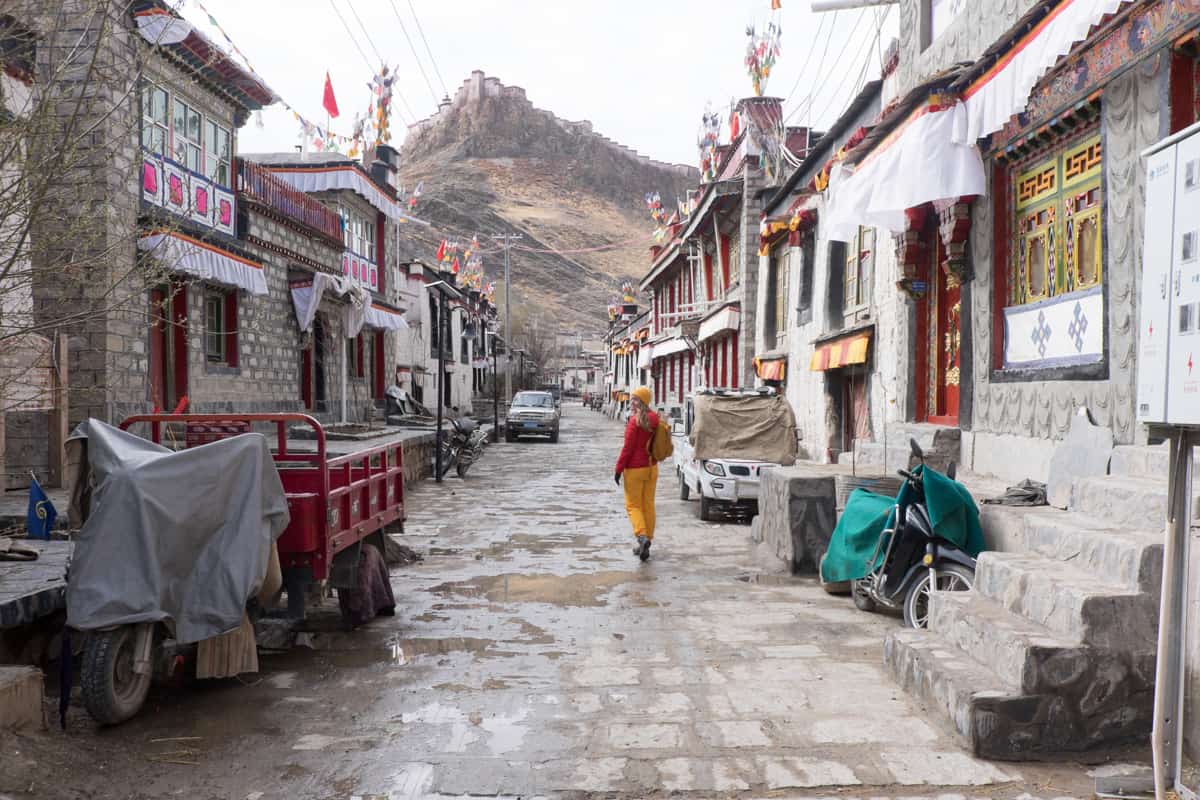
A traditional Tibetan village street in Gyantse
Safety in Tibet is a common question and a precursor to the decision to travel here. While you may hear about acts of political demonstration in the media, this is not something you are ever likely to see since the country is closed during critical political dates and anniversaries.
However, it pays to be aware of where you are and what could get you and Tibetans into trouble. This means:
Not taking or carrying any form of Tibet guidebook, related literature or any political materials into the country . The scanners at Lhasa airport scan laboriously for books.
Not carrying or having in your possession any images of the Dalai Lama while in Tibet. Possession of Dalai Lama pictures is illegal here, with severe consequences for Tibetans.
Respecting that your Tibetan guides cannot engage in any kind of political discussion, whether about the Chinese occupation of Tibet or the Dalai Lama’s current situation. They will tell you who people are in the pictures, cultural references and historical references about Tibetan Buddhism, but do not further push them.
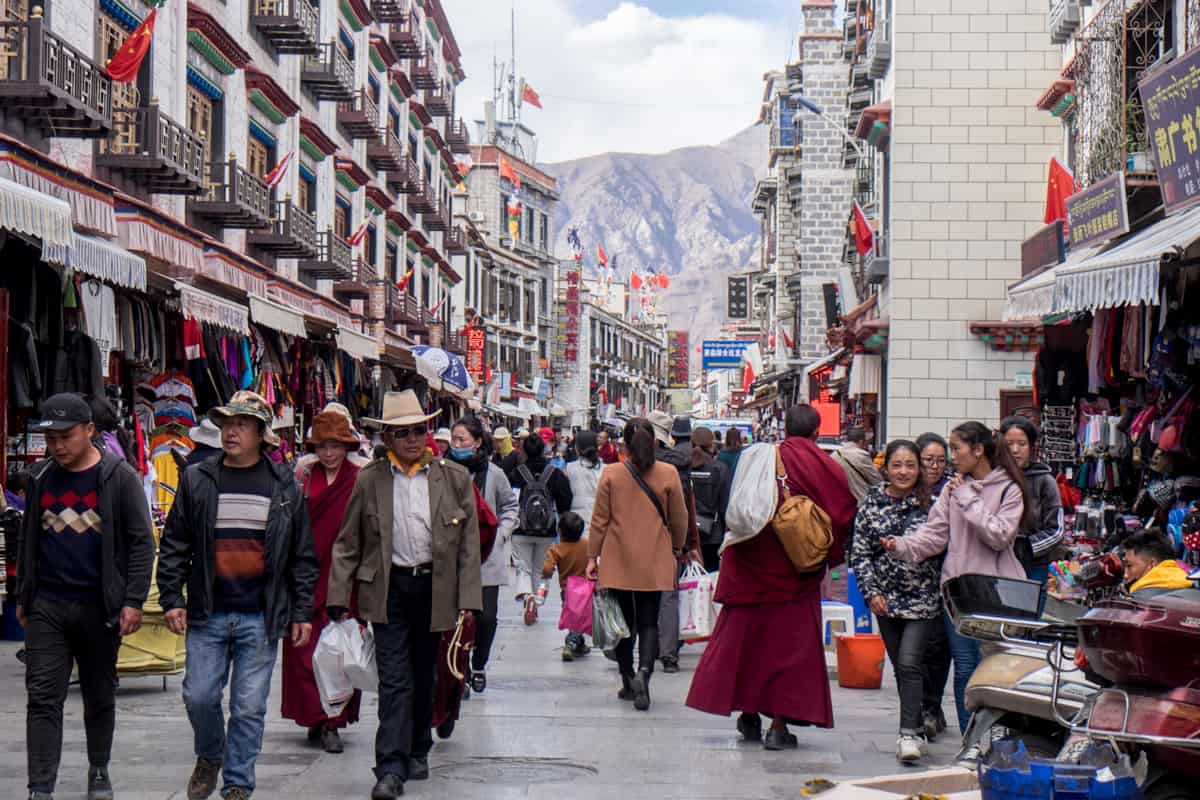
The bustling, busy streets of Lhasa
D o not engage in any kind of political discussion with any Tibetans you meet. All tourism movement is monitored, even if you think at any given moment that it is not, and such debate has far worse consequences for Tibetans.
Do not take any photos of police, army or other military personnel or set-up. If you see anything while taking pictures of sites, buildings, and street views, lower your camera, wait, or move on.
Keep to your itinerary and times. The guide has to ensure the group (and vehicle) reports at designated police checkpoints on the set days of your city departure and new city arrival and by a specified time.
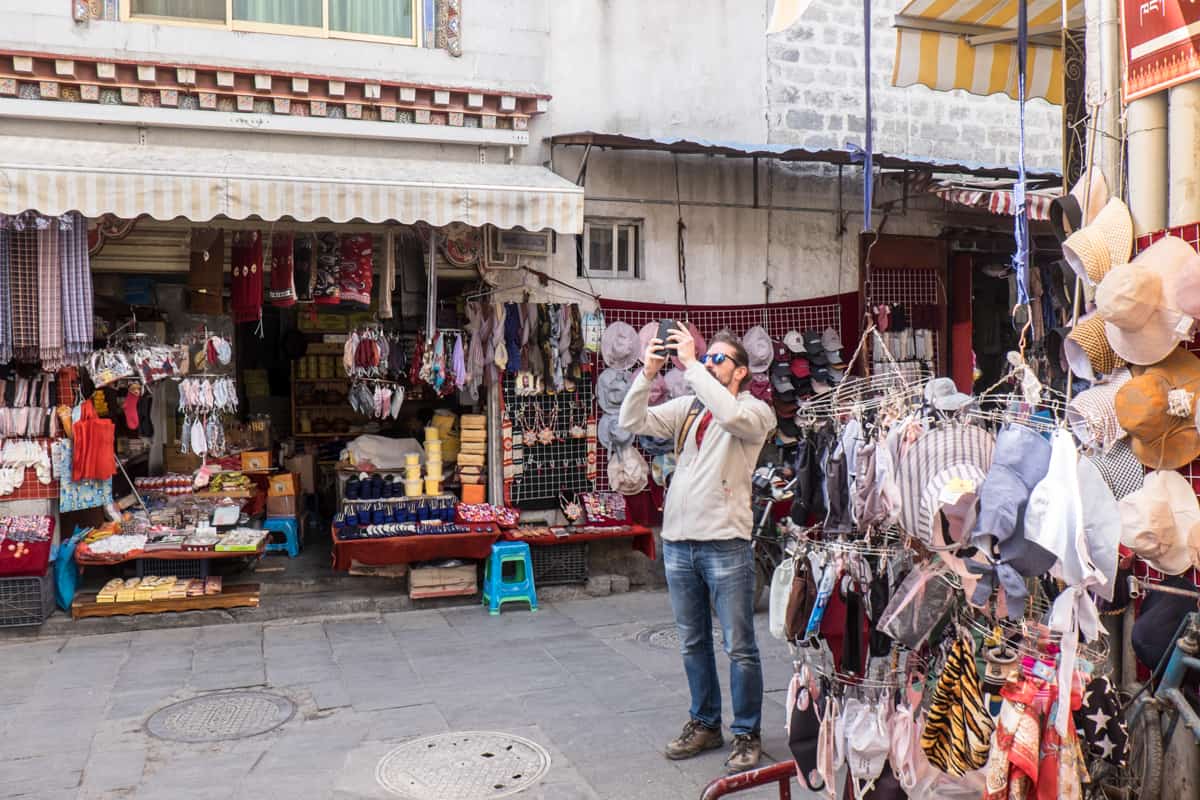
One of the main things I liked about this particular Tibet tour is that (where possible) we stayed in Tibetan owned accommodations, ate at Tibetan owned restaurants and were informed of where to shop at Tibetan owned stores and souvenir stalls.
It’s hard to distinguish what is in between the labyrinth of superficial Chinese town structures, so having someone point you in the right direction was a welcome gesture.
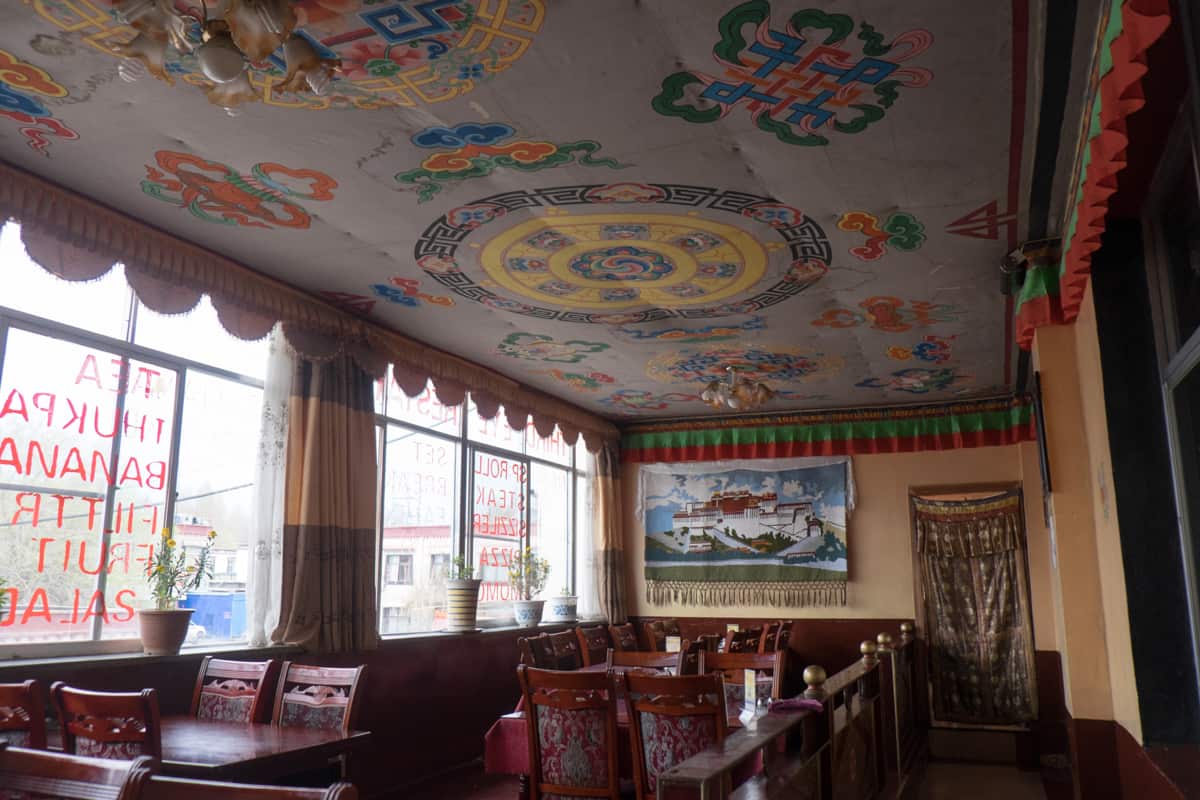
One of the few Tibetan owned restaurants.
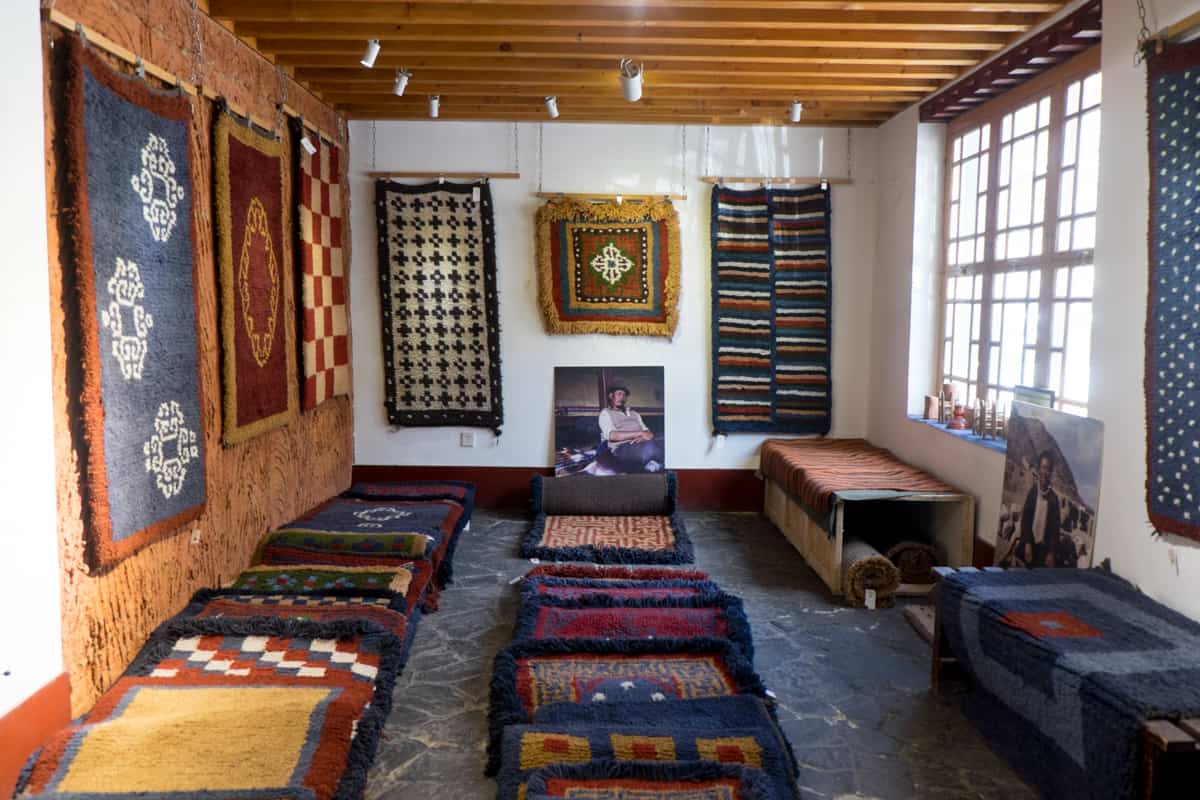
A Tibetan owned shop in Lhasa
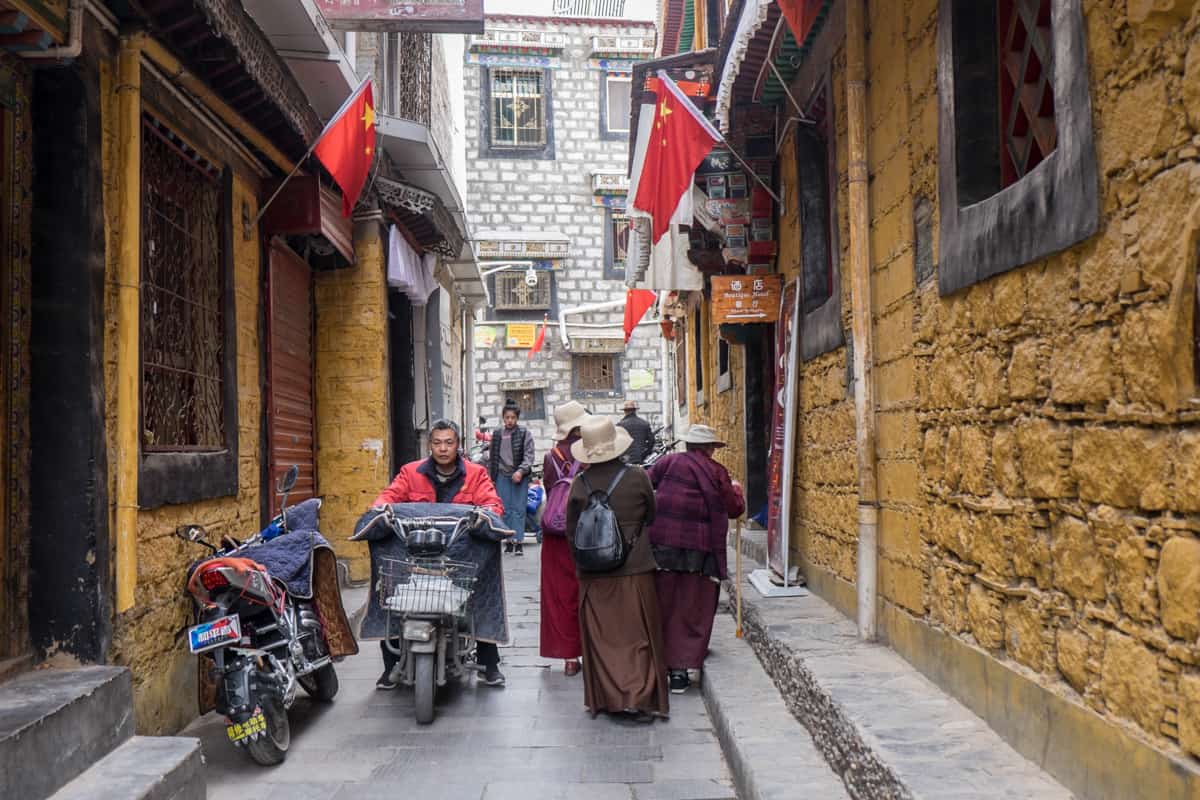
Tibet street scenes, where buildings display Chinese flags
In a destination where Chinese control affects all aspects and layers of daily life, where your tourism money goes, and what and whom it supports, is especially important.
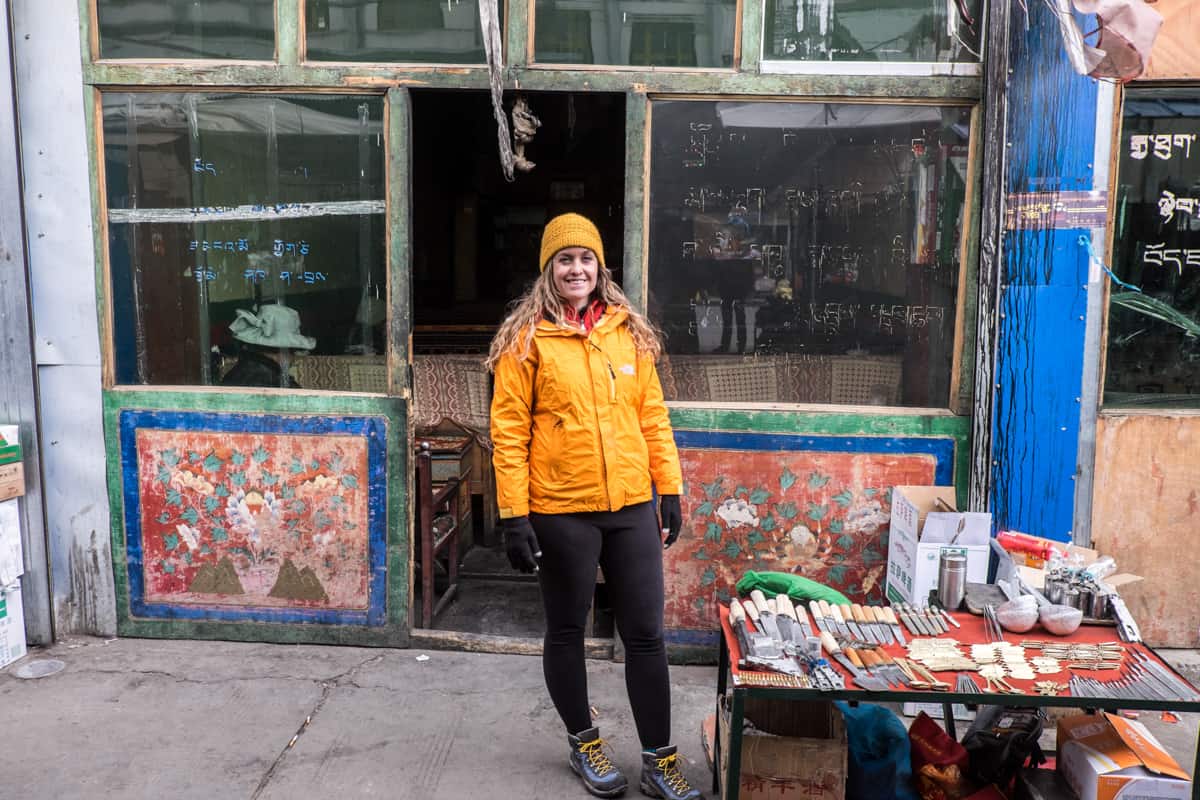
Outside a Tibetan teahouse in Gyantse
The nature of an overland trip in Tibet means many roadside stops for viewpoints and toilet stops. Therefore, forms of tourism enterprise have sprung up in key spots, and while buying food and souvenirs is fine, don’t engage in the practice of photography with the Tibetan Mastiff dogs. Chained and poorly treated, this tourism gimmick is far removed from any level of positive animal welfare and participating in it encourages its continuation.
Where to Visit in Tibet?
Due to strict control by the Chinese government, your trip is organised and scheduled, especially since the driver, guide and the group need to be at police checkpoints along the journey by a specific time. However, with approximately ten days on the ground, you get to cover a lot of Tibet and see the country’s major highlights and differences across cities and landscapes. You also have plenty of free time for extra exploration in each city.
Elevation 3658m
A focal point and centrepiece for Tibetan Buddhists and pilgrims who come here from through Tibet and further afield, Lhasa is more than just the new capital of the Tibetan Autonomous Region.
Johkang Temple (the oldest part was built in the 600s and enlarged over the centuries) and the circular Barkhor Street surrounding it is the most sacred area and the beating heart of Tibetan Buddhism of Tibet. Barkhor is one of the primary pilgrim circuits, where Tibetans come to walk in prayer clockwise around the Kora (sacred) path. It is believed that every Tibetan should visit and pray and at Johkang at least once in their lifetime.
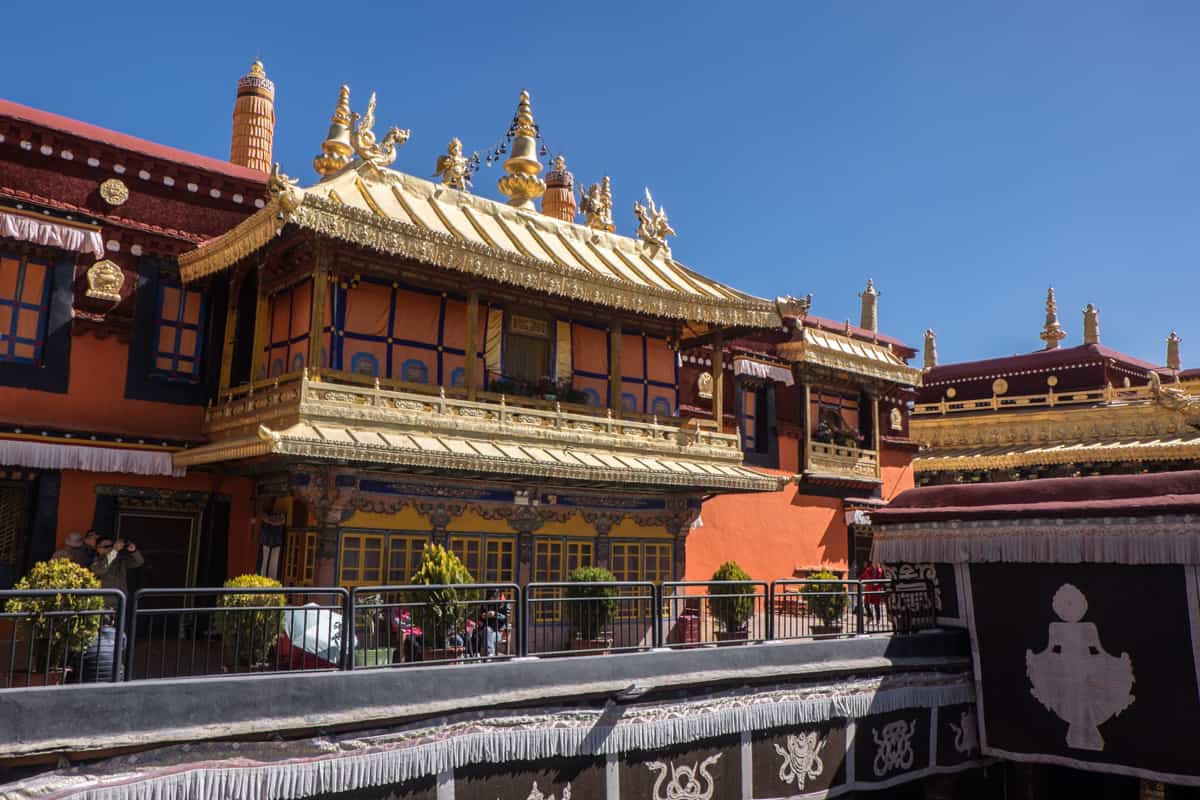
Inside the Jokhang Temple in Lhasa
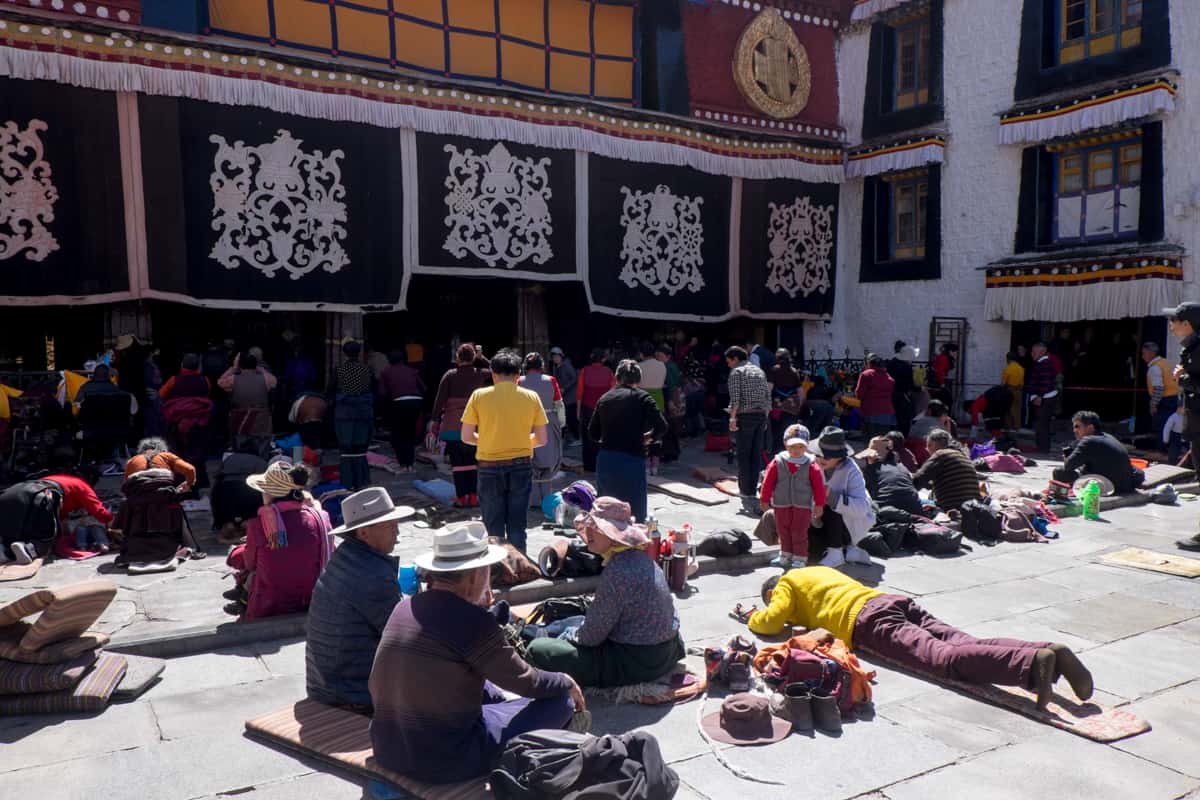
Praying Tibetans on the floor outside the main entrance of the Jokhang Temple
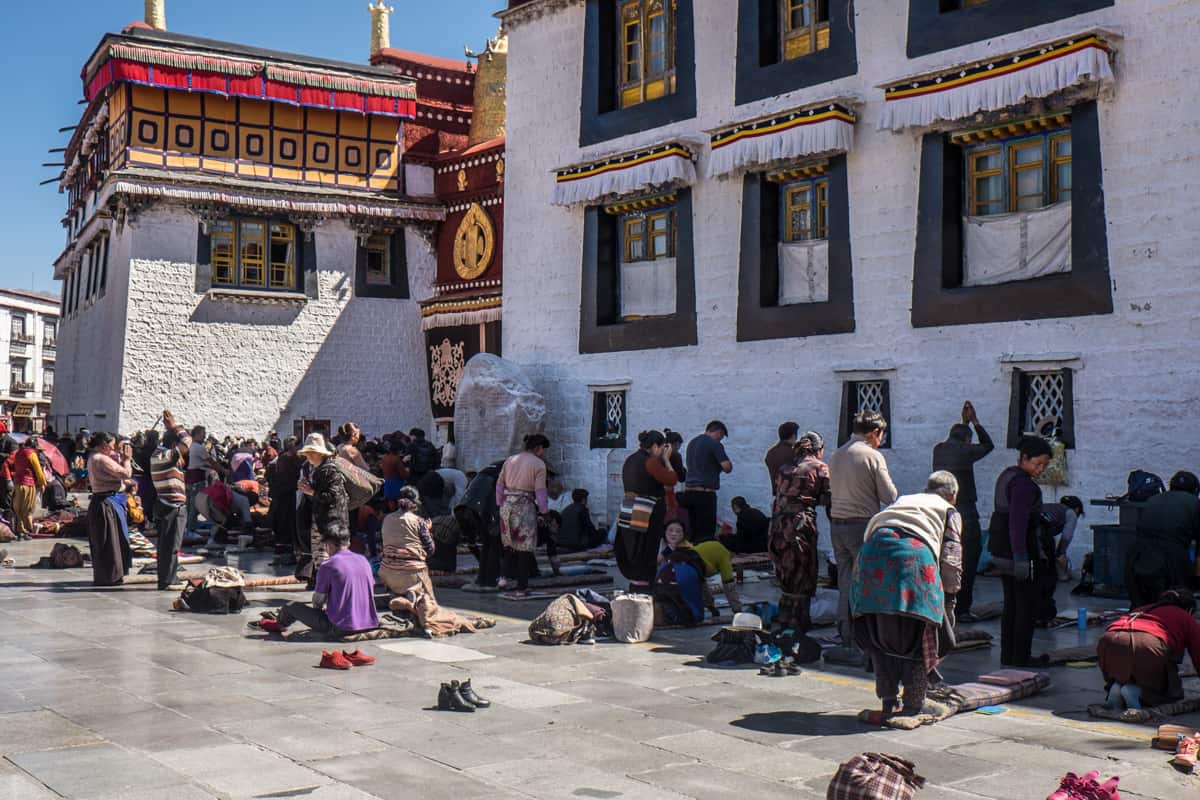
The Sera Monastery is one of the last remaining three core monasteries in the country (together with Drepung Monastery and Ganden Monastery) and one of the two great monasteries of the Gelugpa order. It is better known as the place to see the monks debating – a mesmerising hum of fast-paced chatter and hand-clapping echoes that every visitor should experience. While the number of monks has been reduced significantly (by the hundreds), you can still encounter a grand sense of spiritualism here.
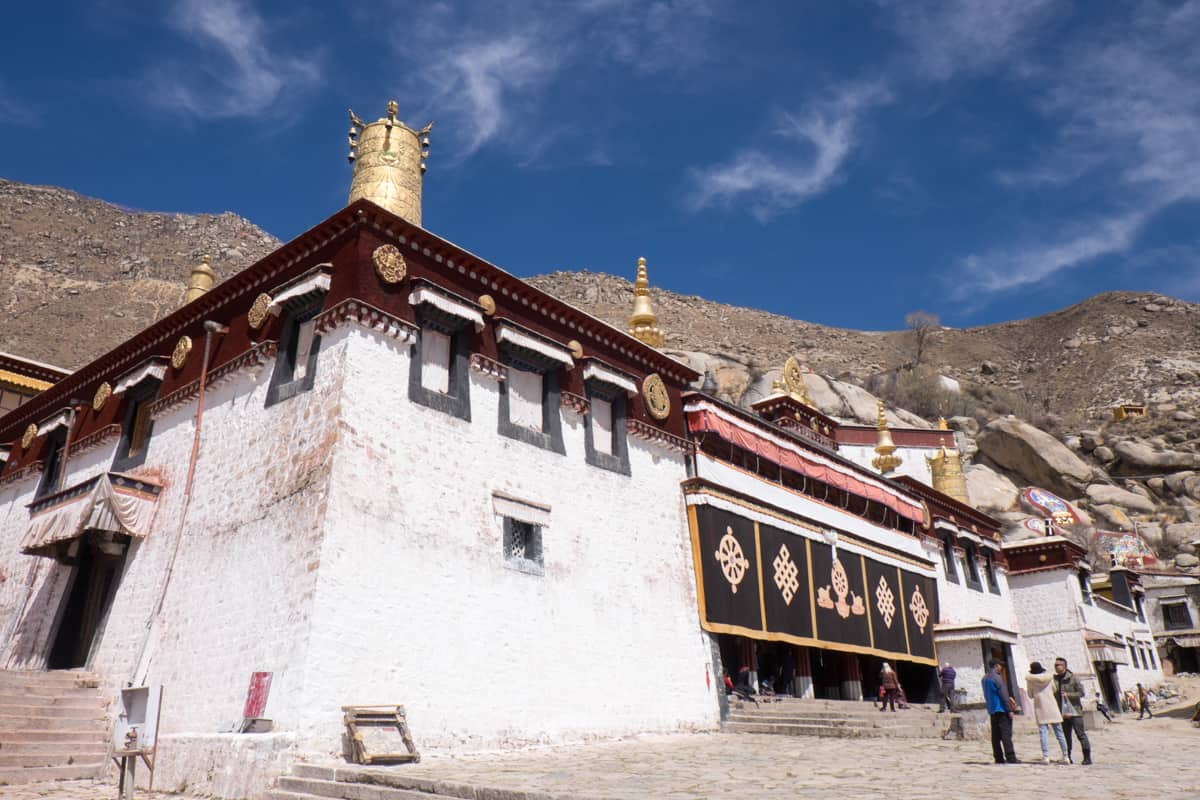
Sera Monastery in Lhasa
Potala Palace is Tibet’s icon – the looming, 1000 roomed structure that sits on the hillside presiding over the capital is now a UNESCO World Heritage Site and museum. It’s a symbol of power, the old administrative centre and the seat of government of spiritual Tibet, built during the reign of the 5 th Dalai Lama in 1645.
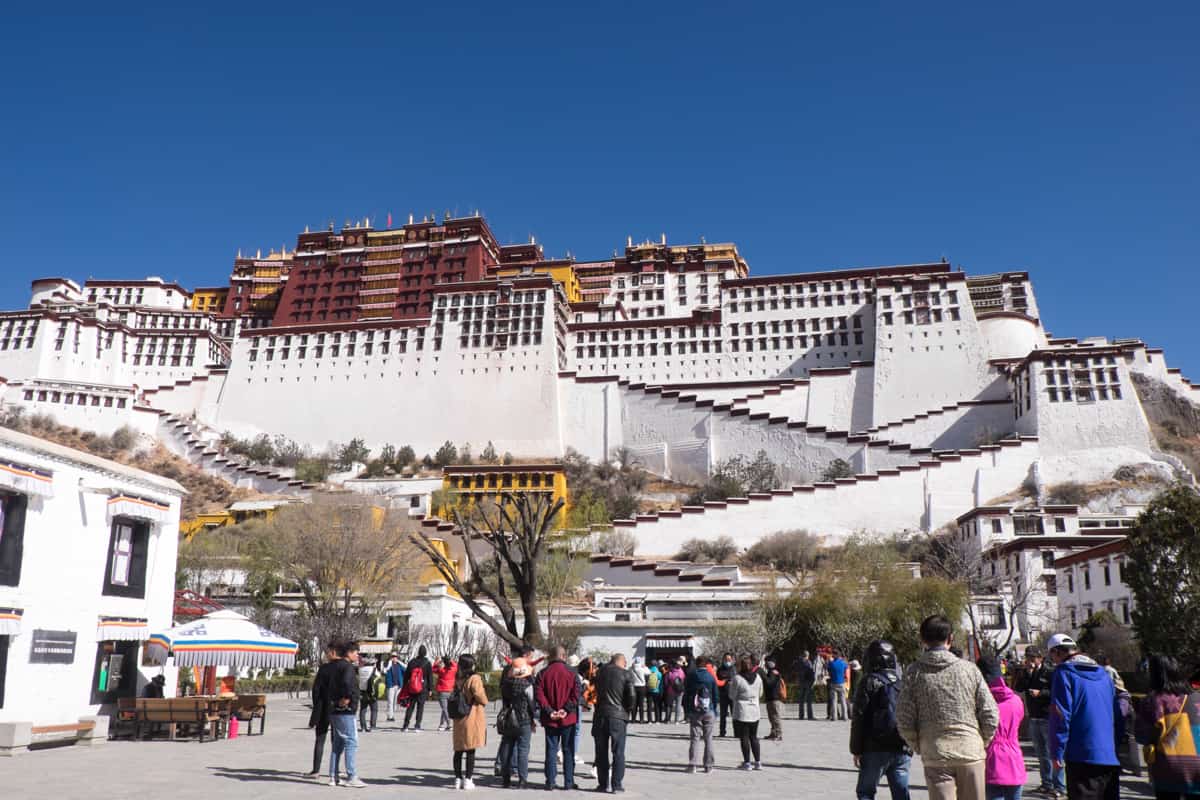
The 1000-roomed Potala Palace in Lhasa, Tibet
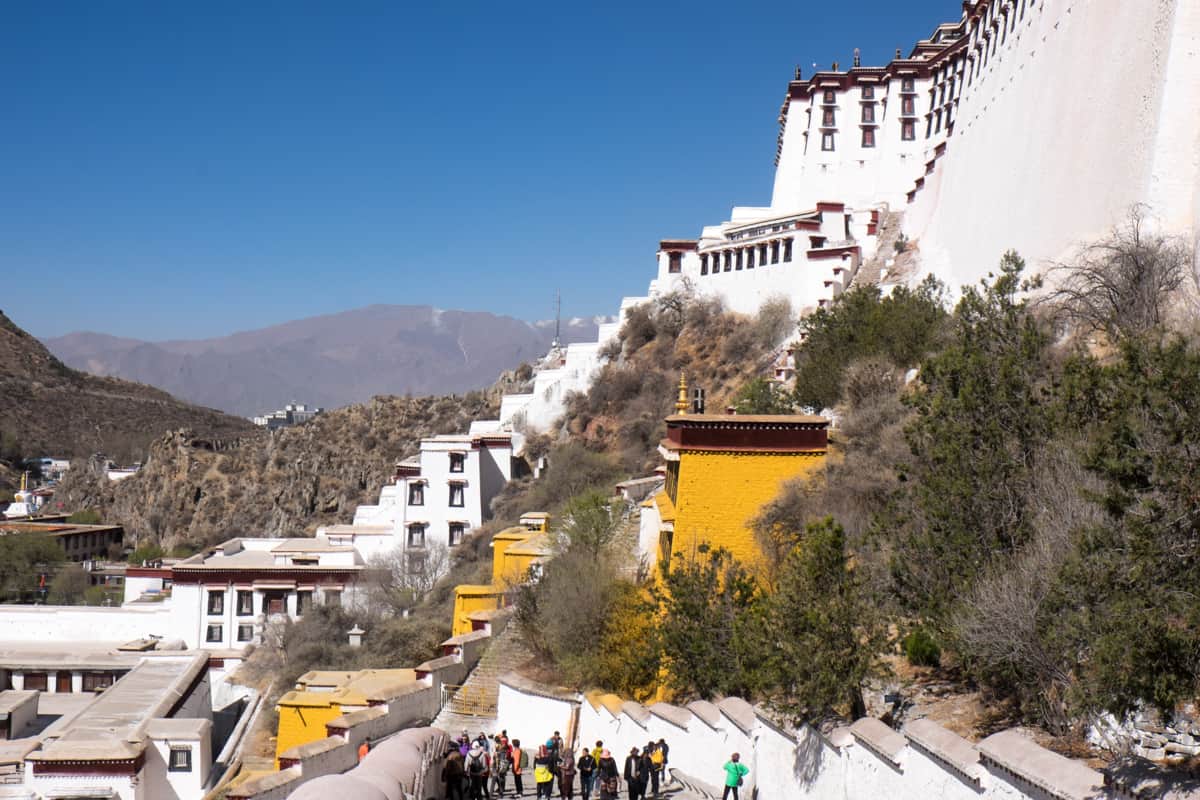
Norbulingka (Summer Palace of the Dalai Lama) was founded by the 7 th Dalai Lama in 1755 and is where the 14 th Dalai Lama made his escape in 1959. It’s known for having the most extensive human-made garden in Tibet, and so its grounds are great for visiting also.
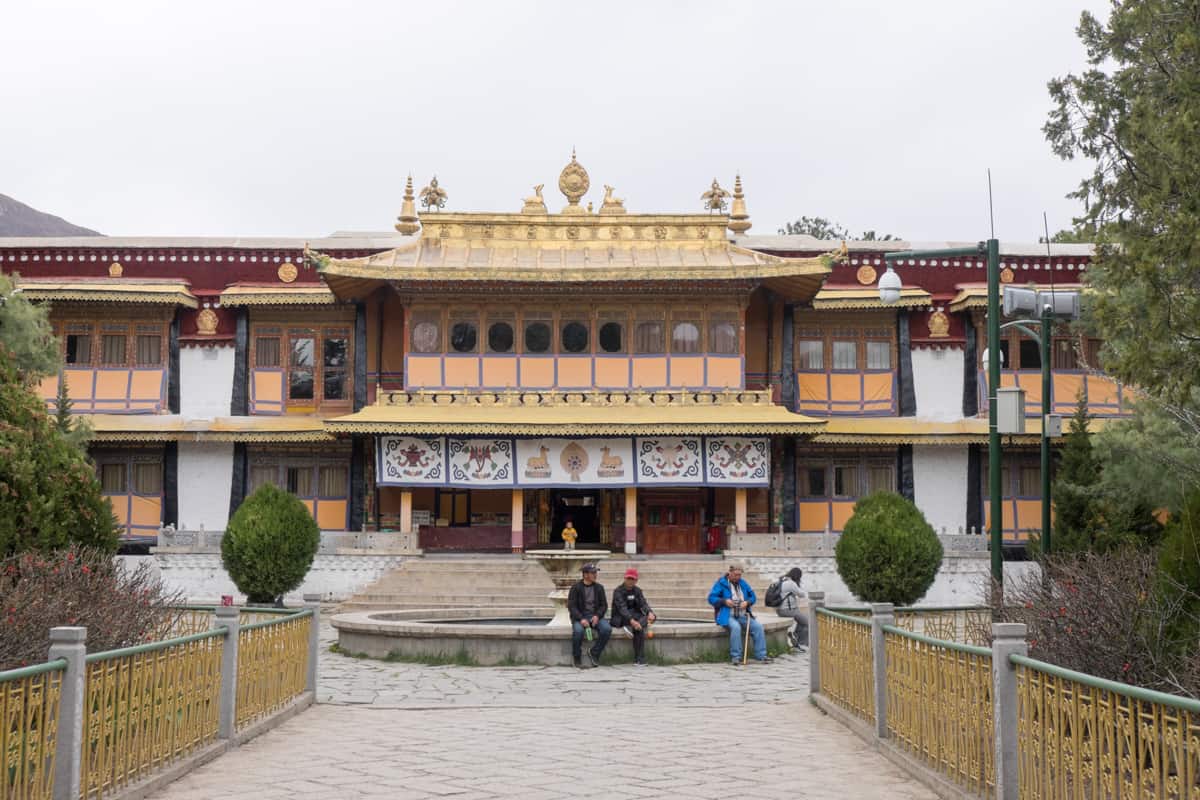
Norbulingka Summer Palace in Lhasa
We were also encouraged to visit Ani Tsamlchung Nunnery to support the nuns. Although the monks get paid a form of salary now, the Chinese government does not support the nuns. Therefore, the $6 ticket cost helps to maintain the nunnery, as does the funds made from supporting their handicraft store and teahouse, the latter of which is a truly local experience.
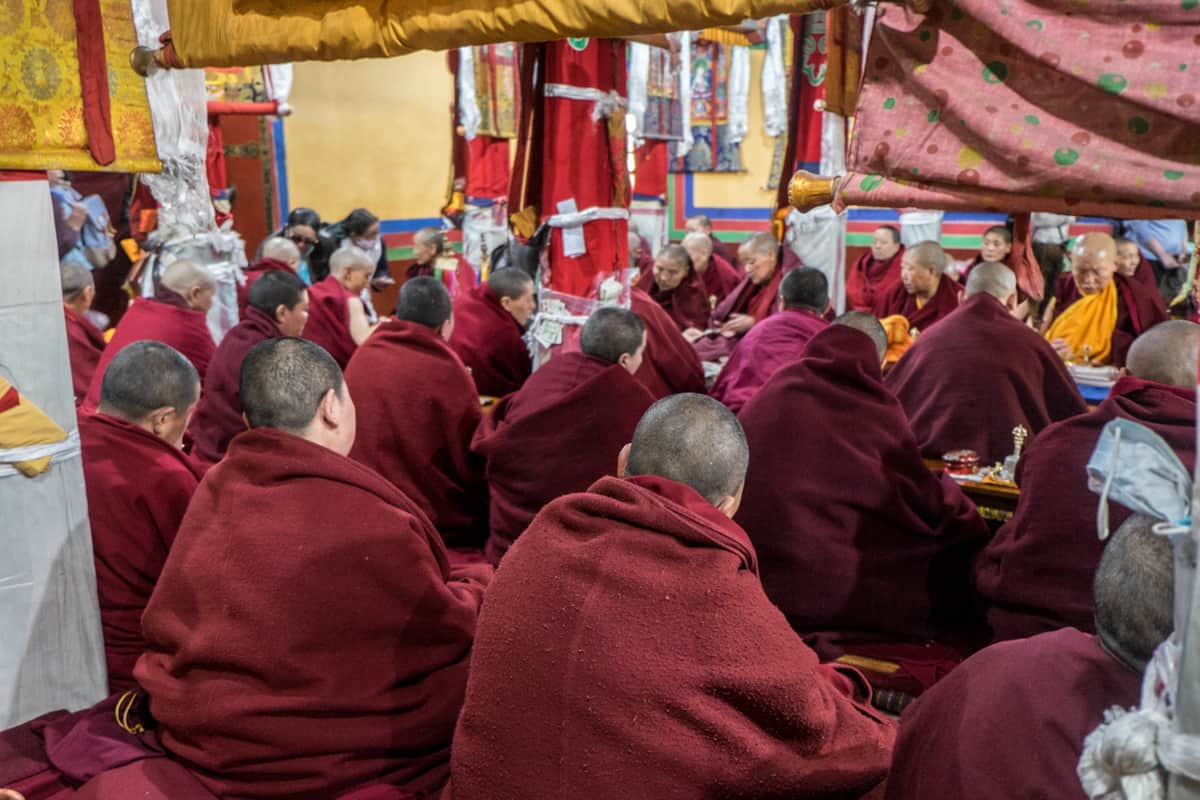
Tibetan Nuns in morning chant at Ani Tsankhung Nunnery in Lhasa
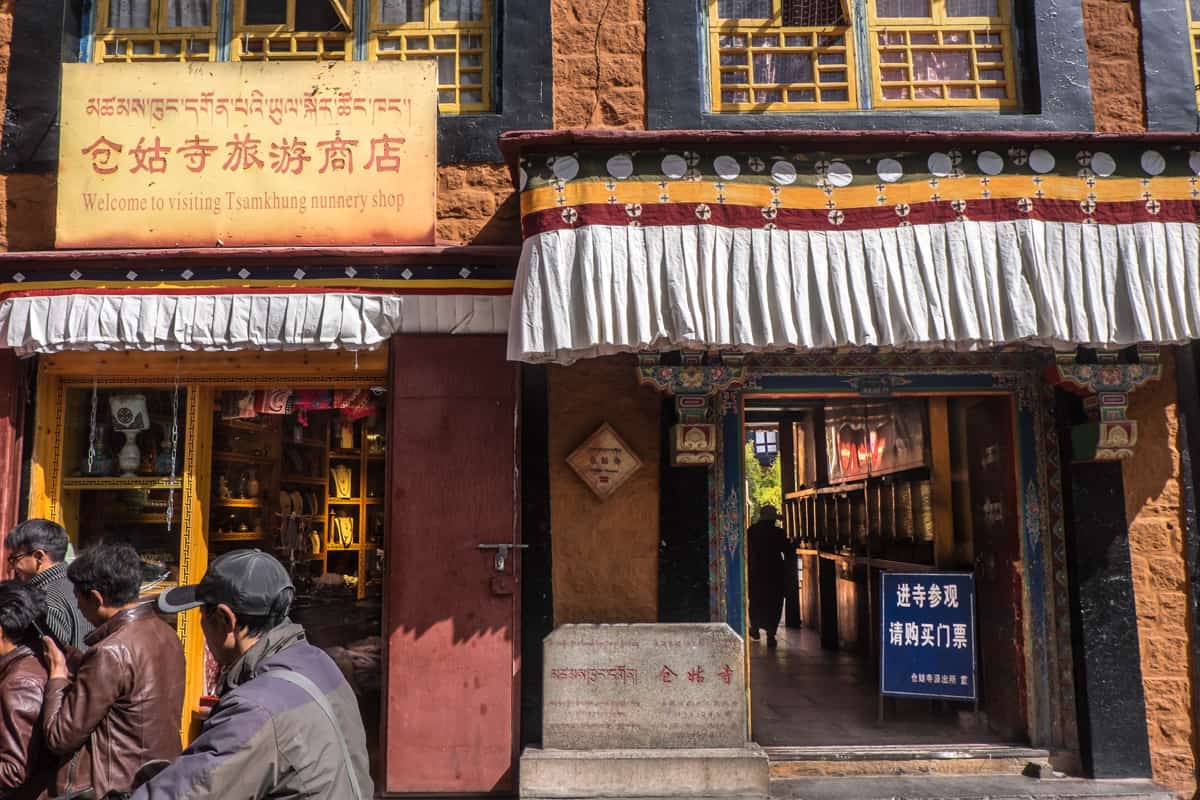
Elevation 4000m
Gyantse used to be Tibet’s third-largest town. While its administrative status has diminished, it remains one of the last cities not wholly overtaken by Chinese influence and mass structure.
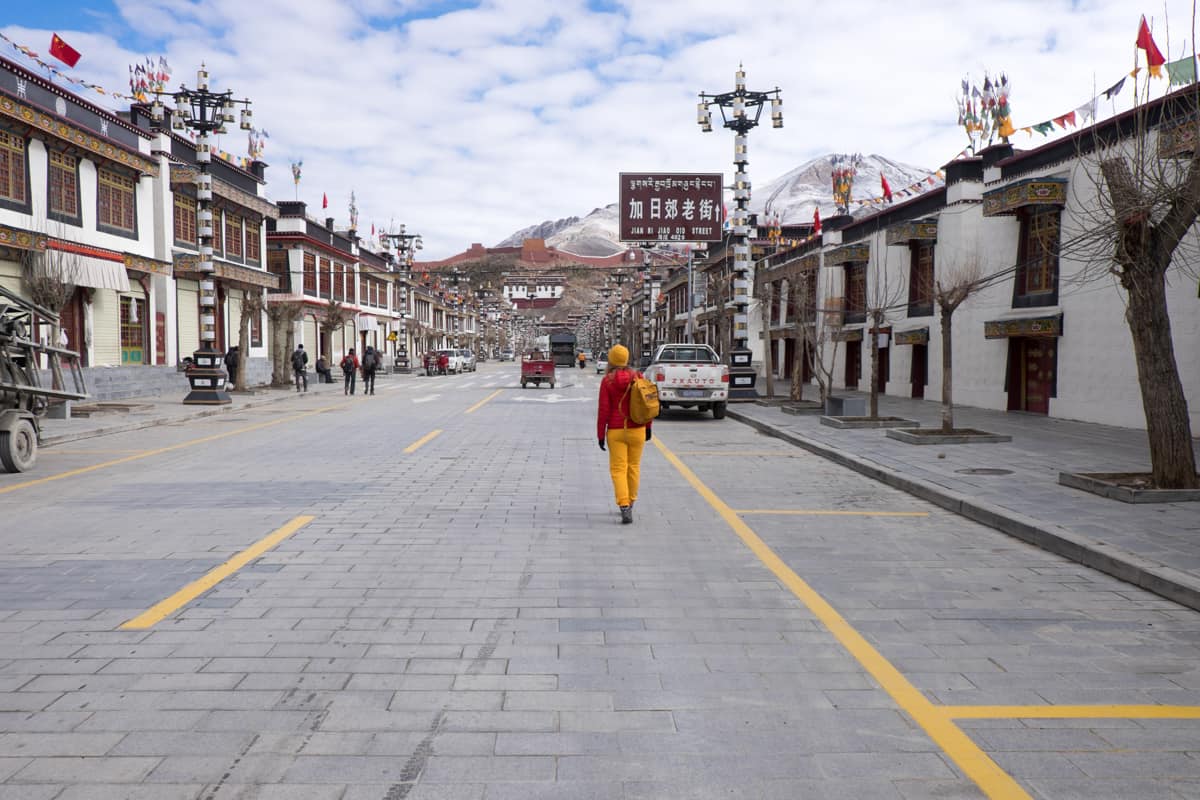
Gyantse, Tibet
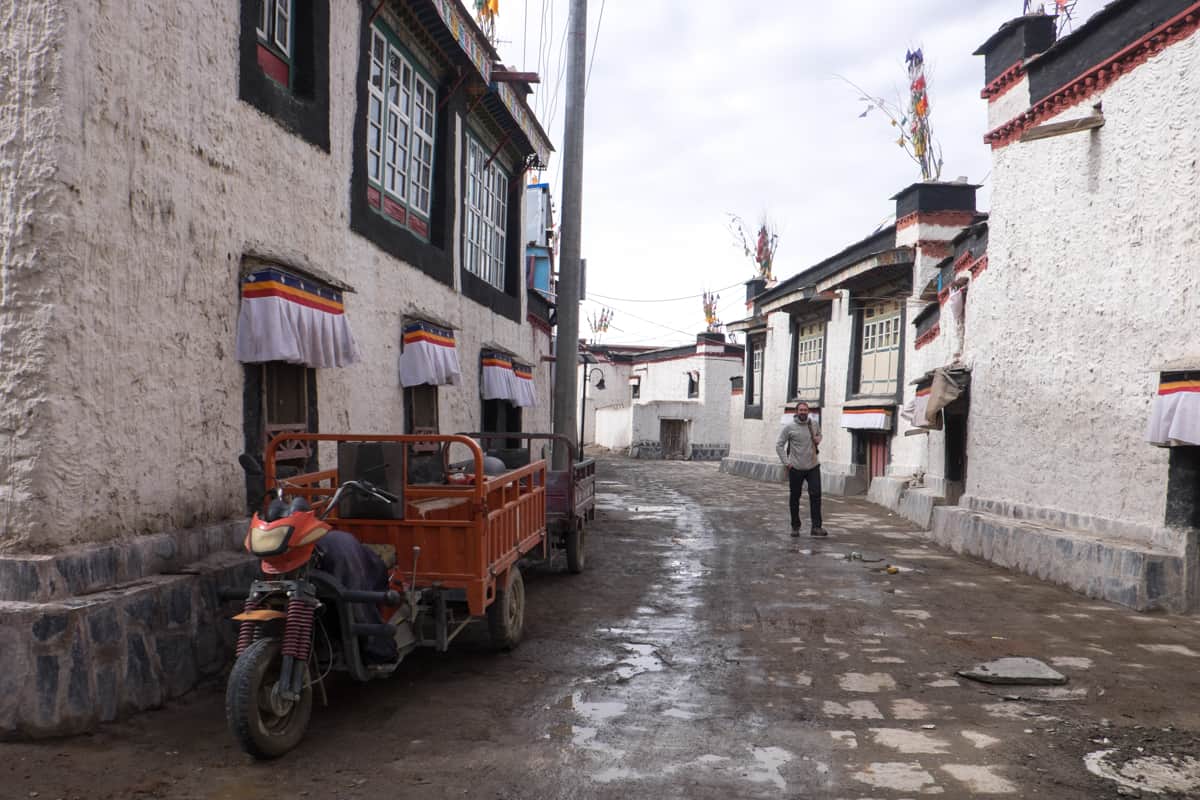
Gyantse village streets
It takes 9 hours to get here from Lhasa, with spectacular viewpoints to make a stop, including the Kambalaat High Pass at 4794m where you can view Mt. Nojin Kangatan (7191m) and drive part of the parameter of Lake Yamdork.
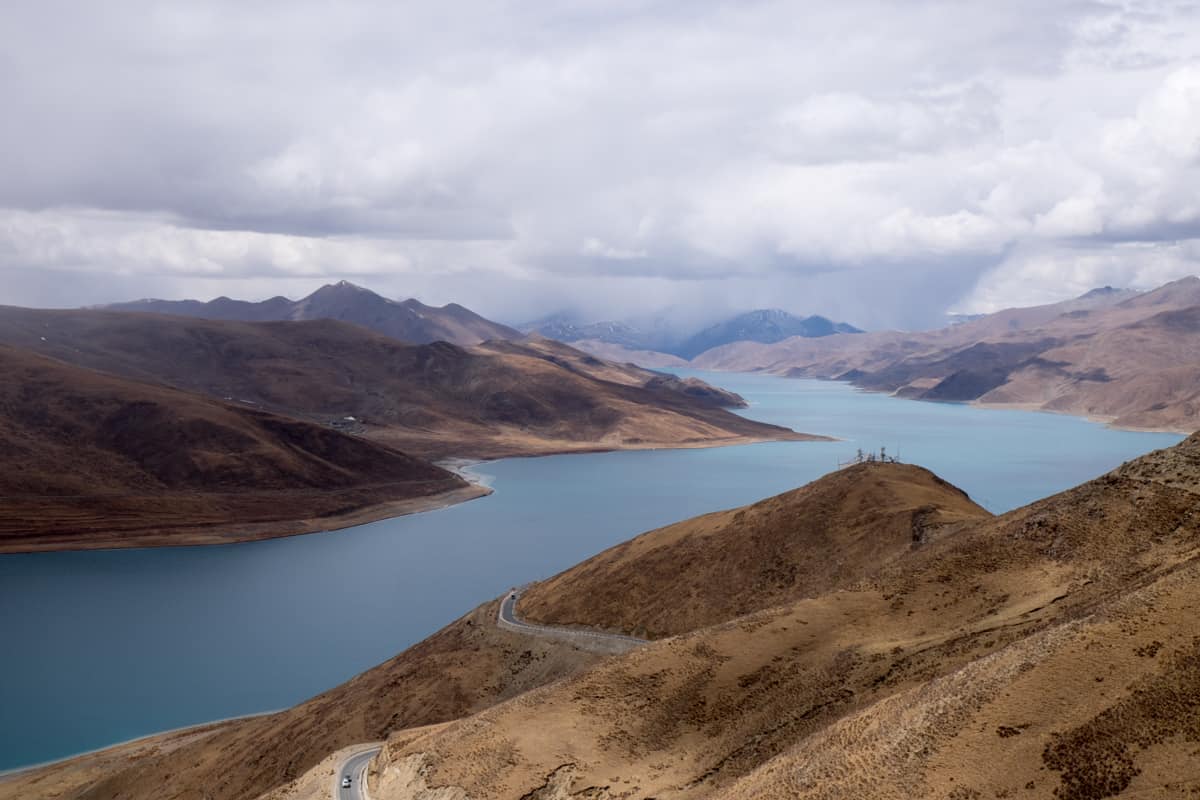
Views over Lake Yamdork, Tibet
Here we visited the Palcho Monastery , which you breathlessly climb for 20 minutes for a broad panoramic view of the surrounding village, fortress and mountain ranges. This moment of calm looking out over such a surreal canvas is a time to reflect on where you are.
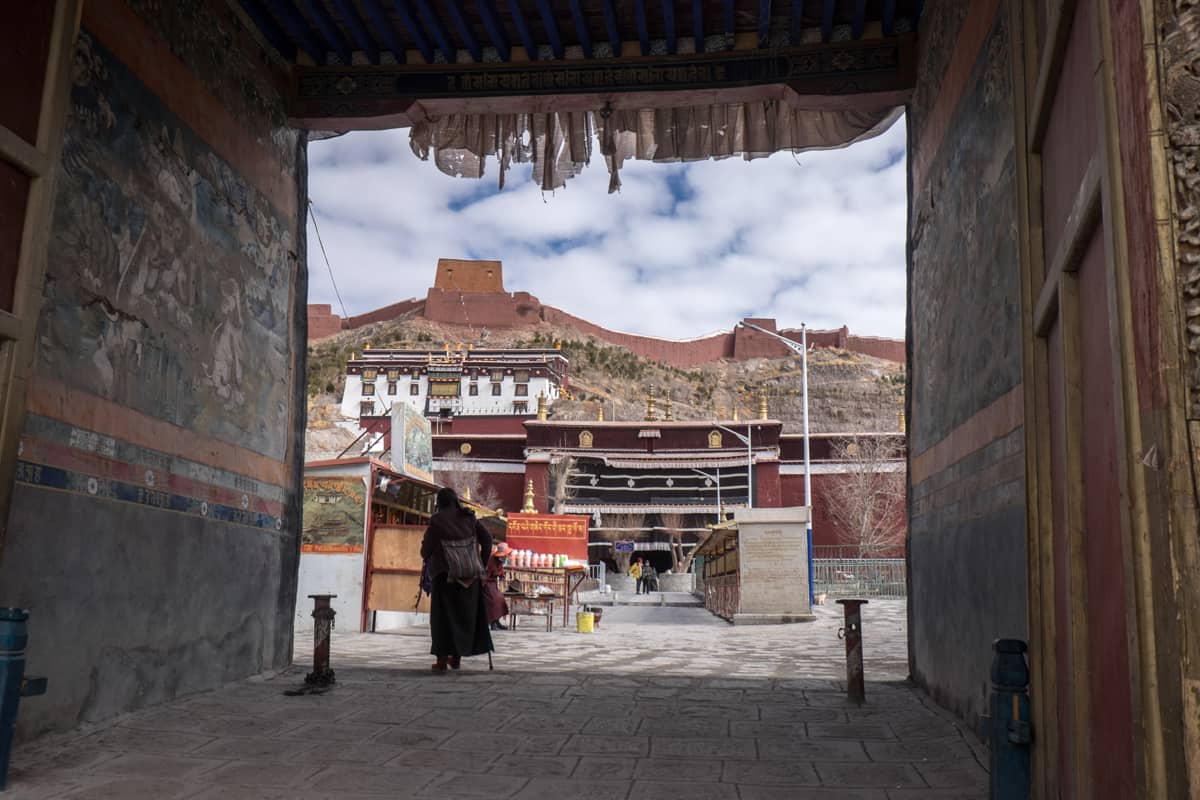
Entrance to the Palcho Monastery in Gyantse
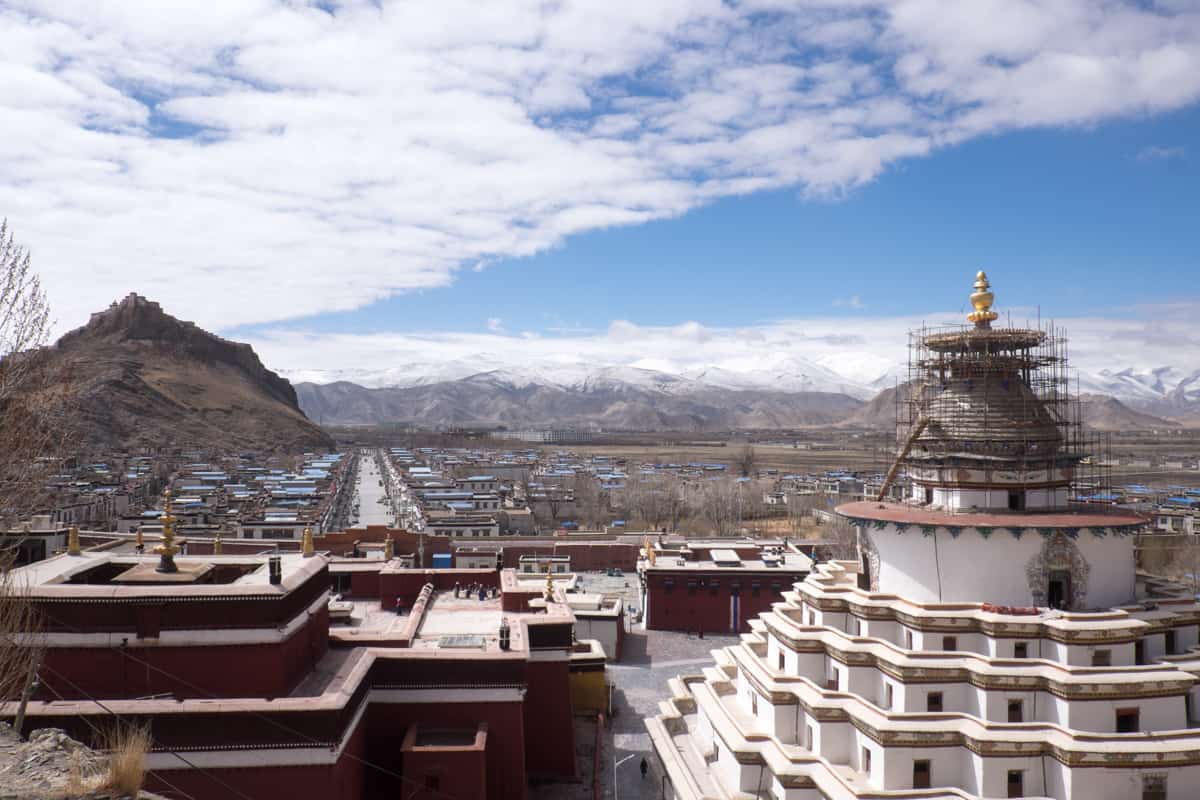
The sweeping views from the top of the Palcho Monastery
Elevation 4,300m
Tibet’s second-largest city of Shigatse is a two-hour drive from Gyantse.
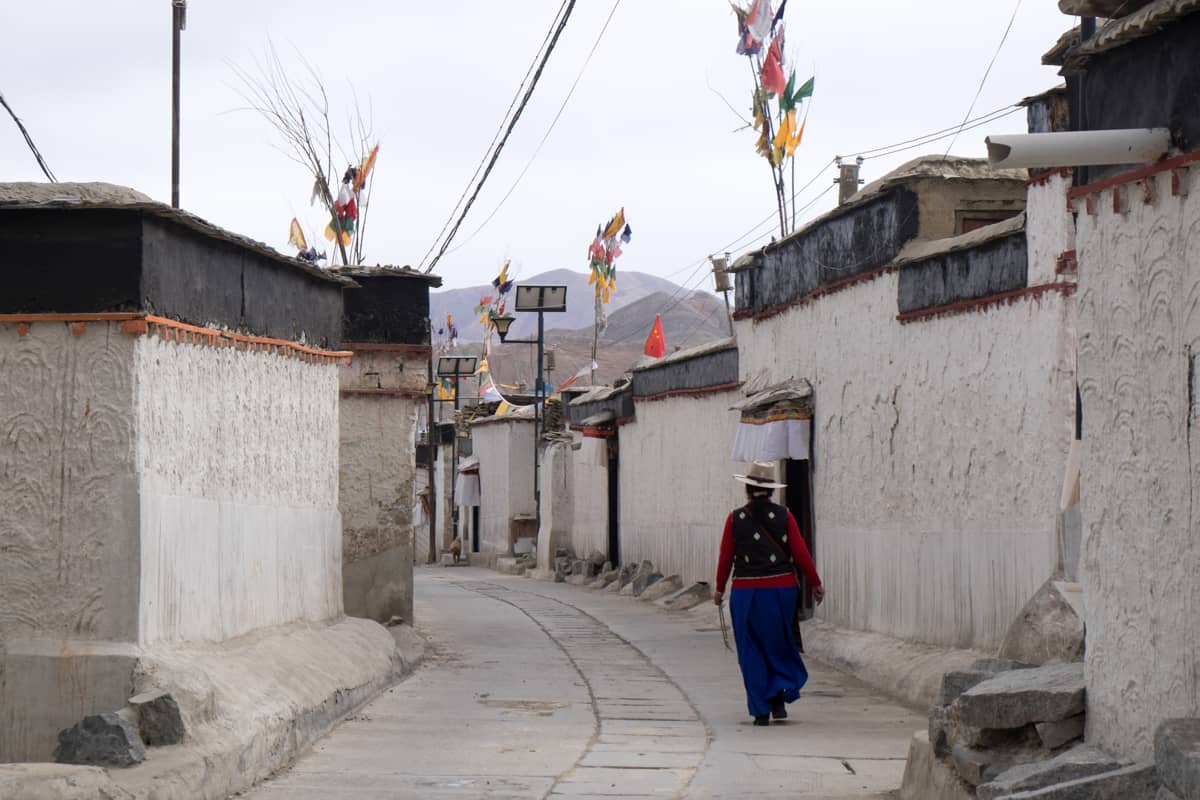
A Tibetan woman in a traditional village in Shigatse
Better known as the Panchen Lama’s traditional seat (the second highest order of the Dalai Lama), Shigatse is on the map because its home to Tibet’s best-preserved Monastery Tashilompo Monastery where once, 4700 monks lived.
It’s considered by pilgrims to be the second Potala Palace and is visited daily by hundreds of people here to see the 26m high Buddha made from 278kgs of gold.
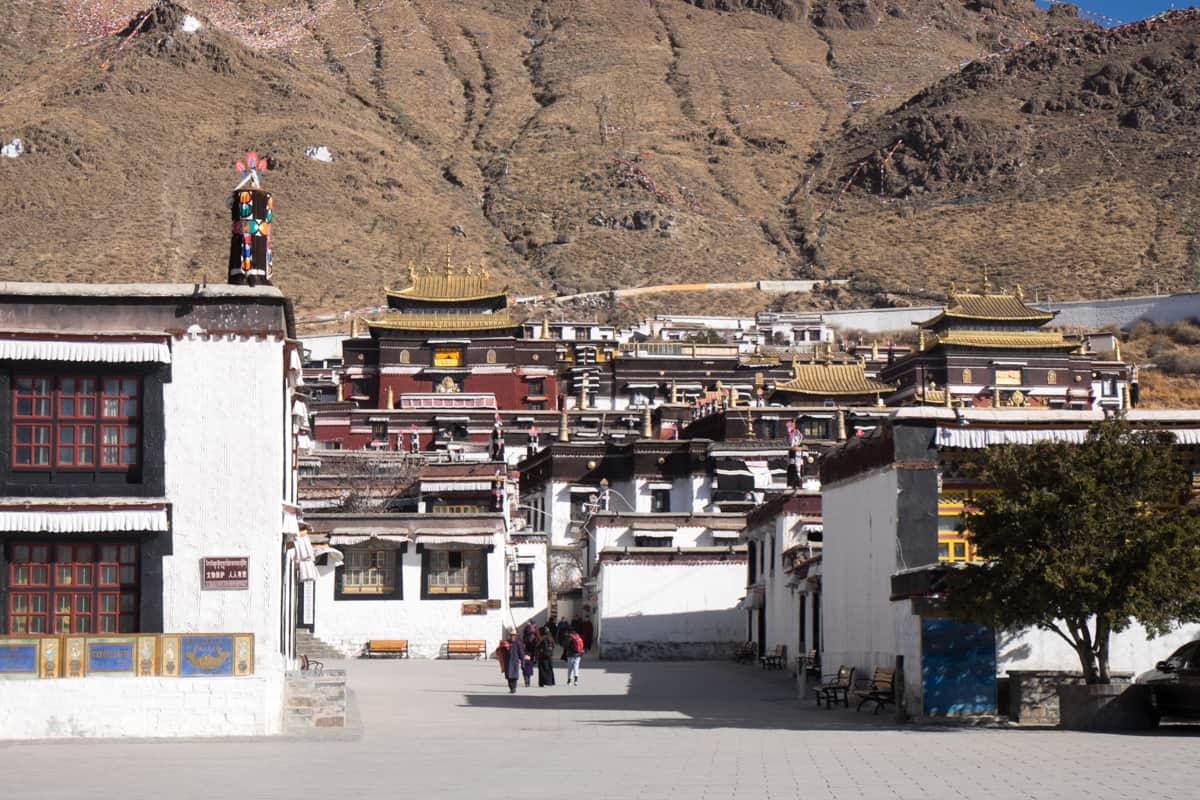
The Tashi Lhunpo Monastery in Shigatse Tibet
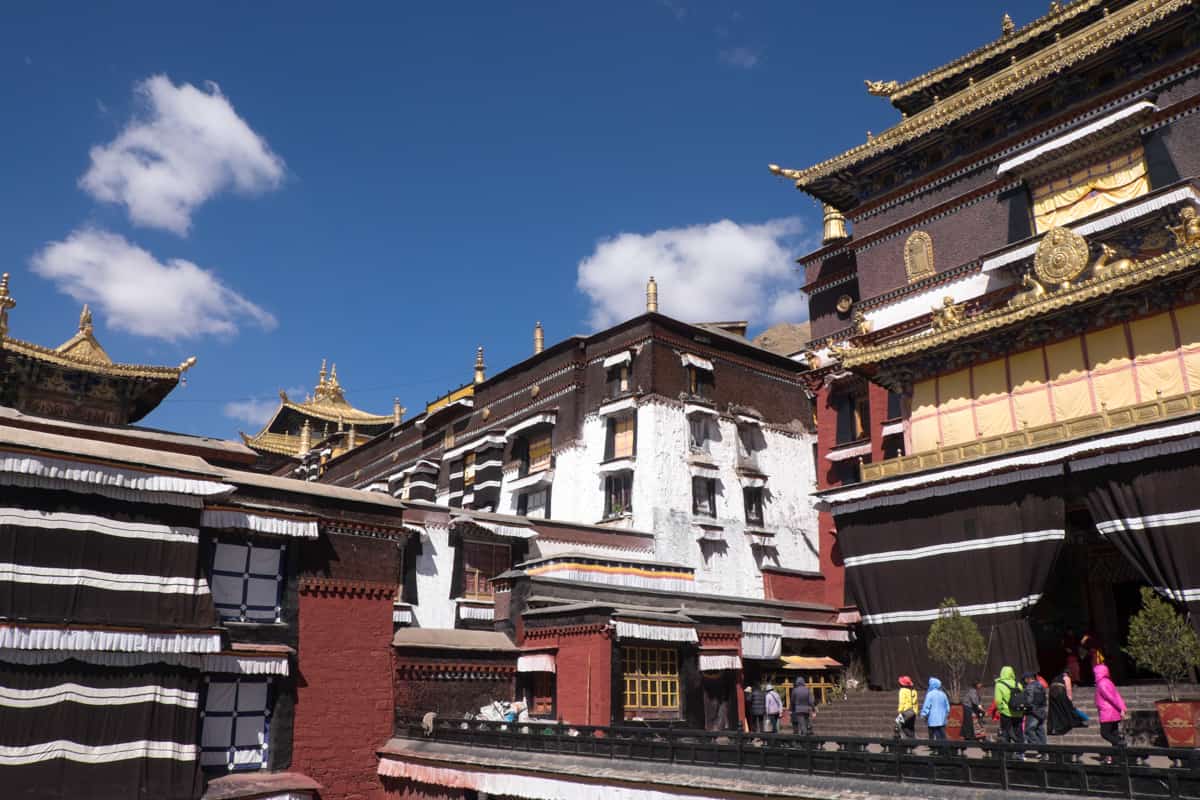
A short drive from Shigatse, our time in neighbouring Shegar was a sleepover point at 4,300m, ready for the nine-hour drive to Everest Base camp the following day.
Elevation 4980m
On the way to the Everest Base Camp area, you get to visit the Gyatso Pass at 5248m – the highest pint you will be on the trip. Another accolade to rack up here is to say you’ve used the highest toilets on earth.
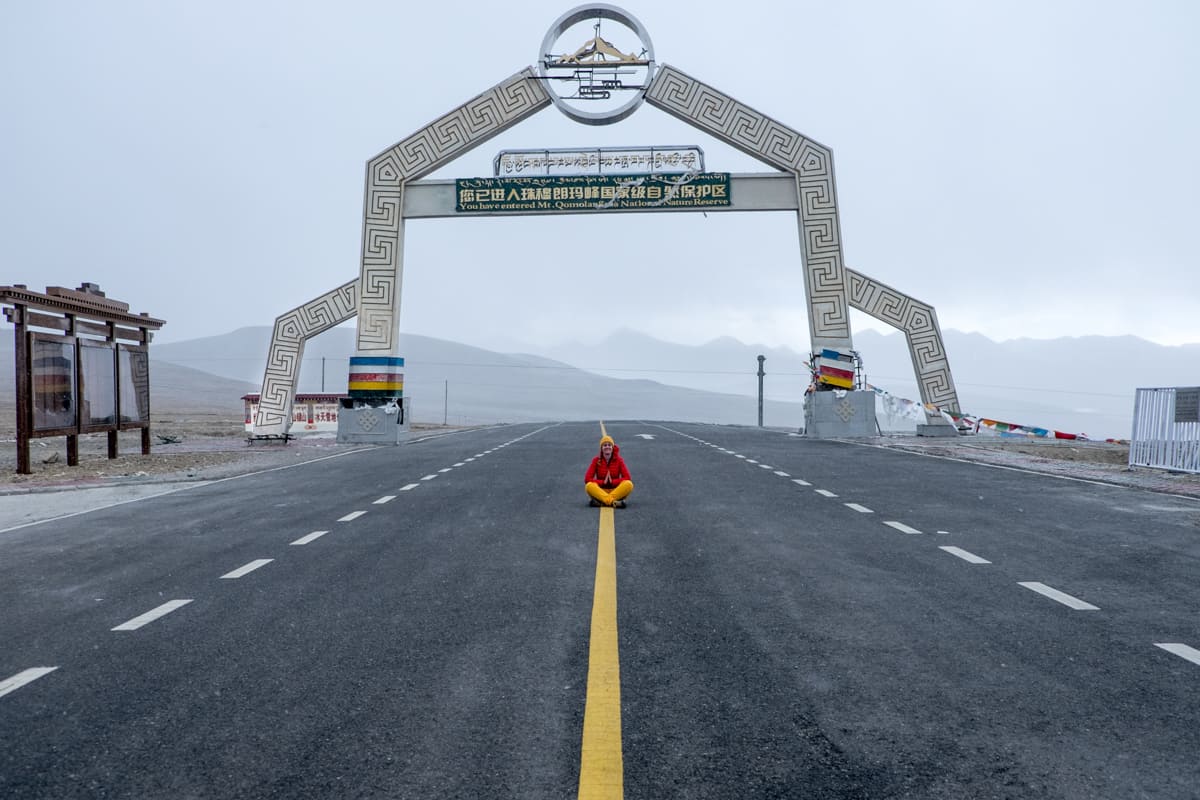
The Gyatso Pass – the highest road in Tibet
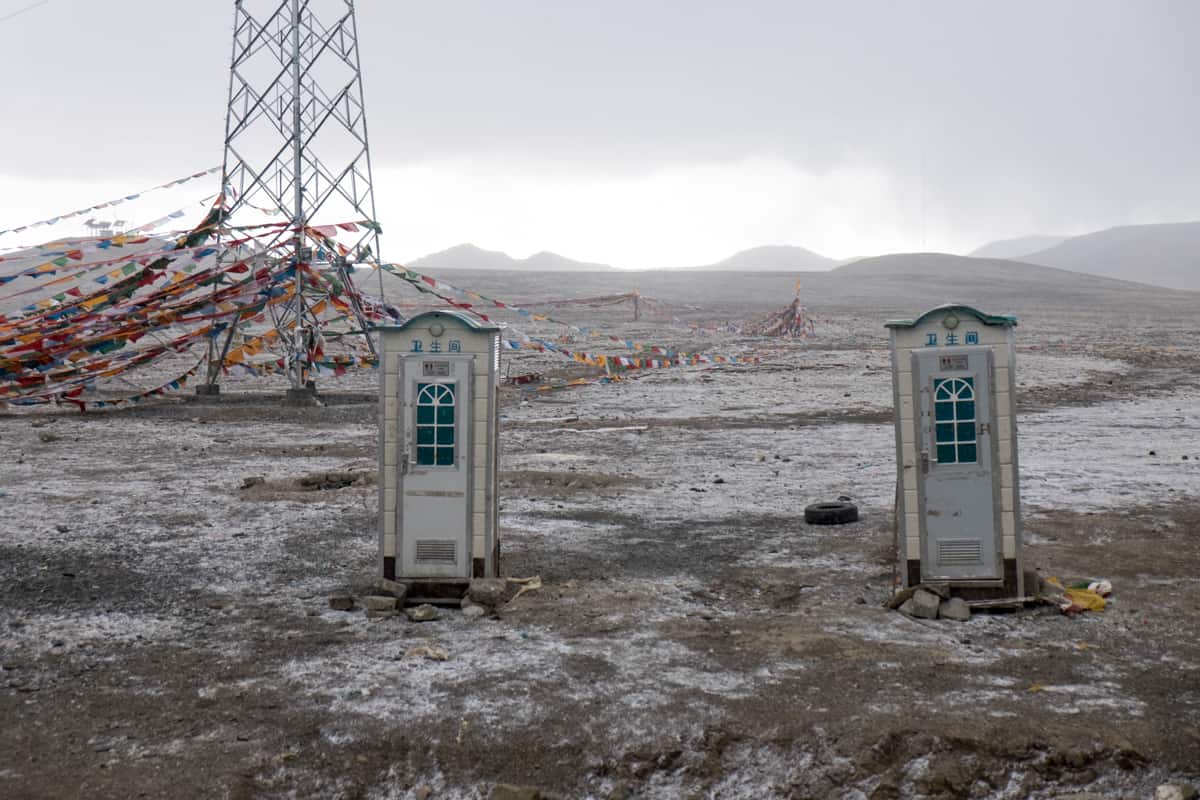
The toilets on the Gyatso pass in Tibet are the highest toilets on earth!
The drive to the Rombuk Monastery was an endless stream of white-capped mountain scenery, with everybody in the vehicle full of excitement with every glimpse of Everest as we rounded corners and valley walls.
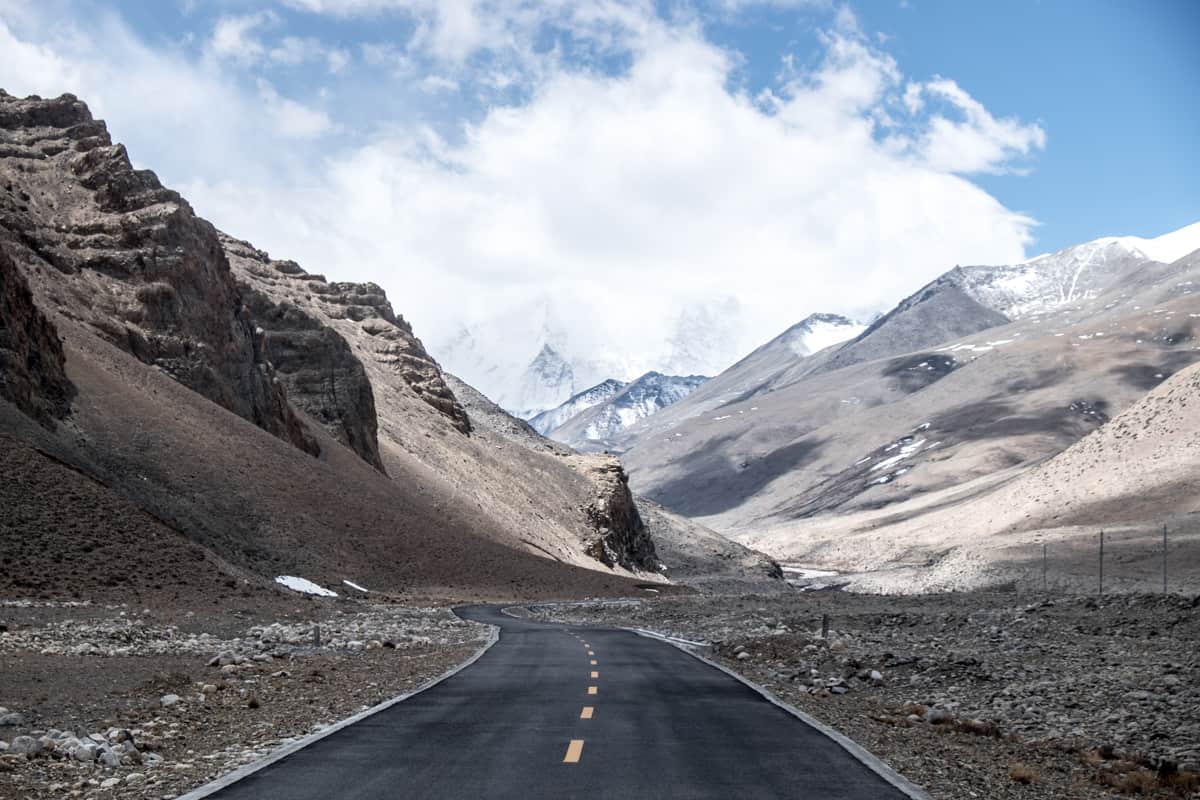
View of Mount Everest in Tibet
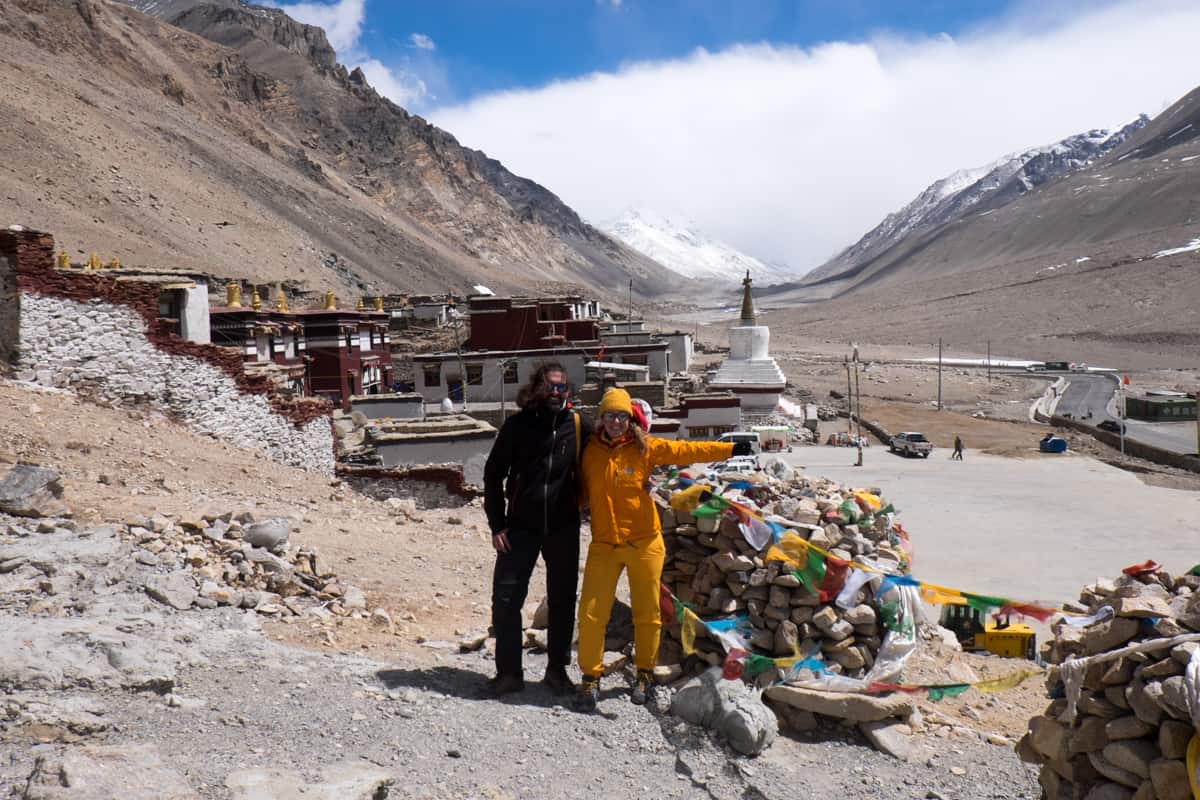
Rombuk Monastary view to Tibet Everest Base Camp
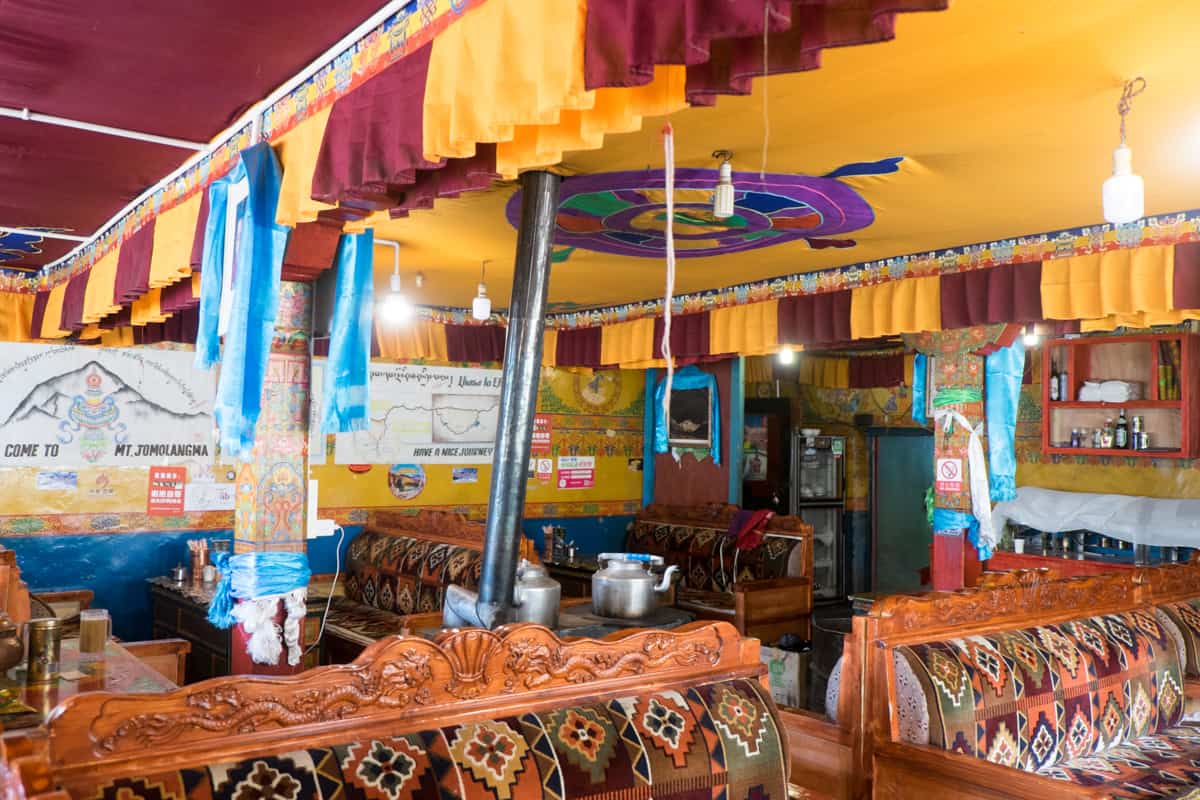
Inside Rombuk Monastary at Tibet Everest Base Camp
The Monastery stay is basic but comfortable, with a chance to walk to the Base Camp checkpoint and climb a small view for an elevated viewpoint. On the other side of Everest is where my first mountain adventure completing the Everest Base Camp Trek, began in Nepal seven years ago. Everest Base Camp on the Tibet side might have been moved back by 7km, but nothing beats the view we had of the world’s highest mountain.
READ MORE: Everest Base Camp Trek, Nepal – Reaching the Top of the World
Overnight it had snowed, so we were able to take another walk towards Everest as it stood glowing with a golden morning halo.
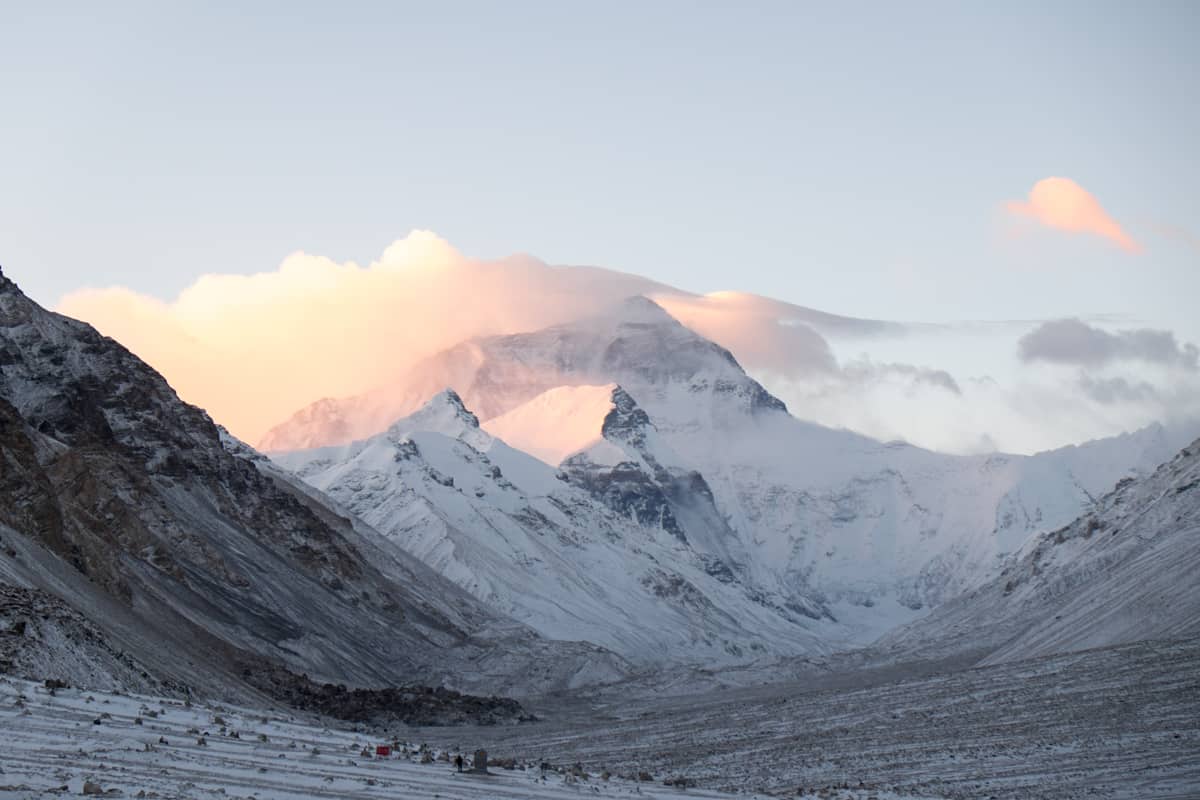
Leaving Mount Everest behind, we took back to the road for a 9-hour drive to the Nepal-Tibet border town of Kyirong. While there is not much to see here, it is where we had our last Tibetan dinner and a good night’s rest before the 10-hour drive back to Kathmandu.
What to Pack for Tibet
- Layers including merino wool thermals , t-shirts, fleece, windproof or tri-climate jacket and a waterproof jacket. I layered as swapped and changed. One minute it’s sunny, and you work up a sweat walking around. The next, you will be jumping out of the car to snap away at the valley ridges and mountain scenes where it’s cold, windy, raining or even snowing. Every day is a surprise.
- You will need modest clothing covering shoulders and knees for when you enter monasteries, temples and other religious areas. Casual long-sleeve travel tops are acceptable, or best tops with cardigans or light-sport jackets.
- Jeans and hiking trousers ( Mammut are my go-to brand for fit and comfort). Wear your most comfy pants for long journeys, my favourite being my roomy, yellow climbing pants.
- Gloves and a hat for those cold, windy and sometimes snowy conditions at high heights
- Trekking shoes (better when walking outside in more adverse weather conditions and walking at Everest Base camp) and sneakers / comfortable walking shoes for general city wandering. My top picks are the Asolo hikers and the tougher Salewa MTN Trainer Mid GTX range. I have Vivobarefoot for everyday walking .
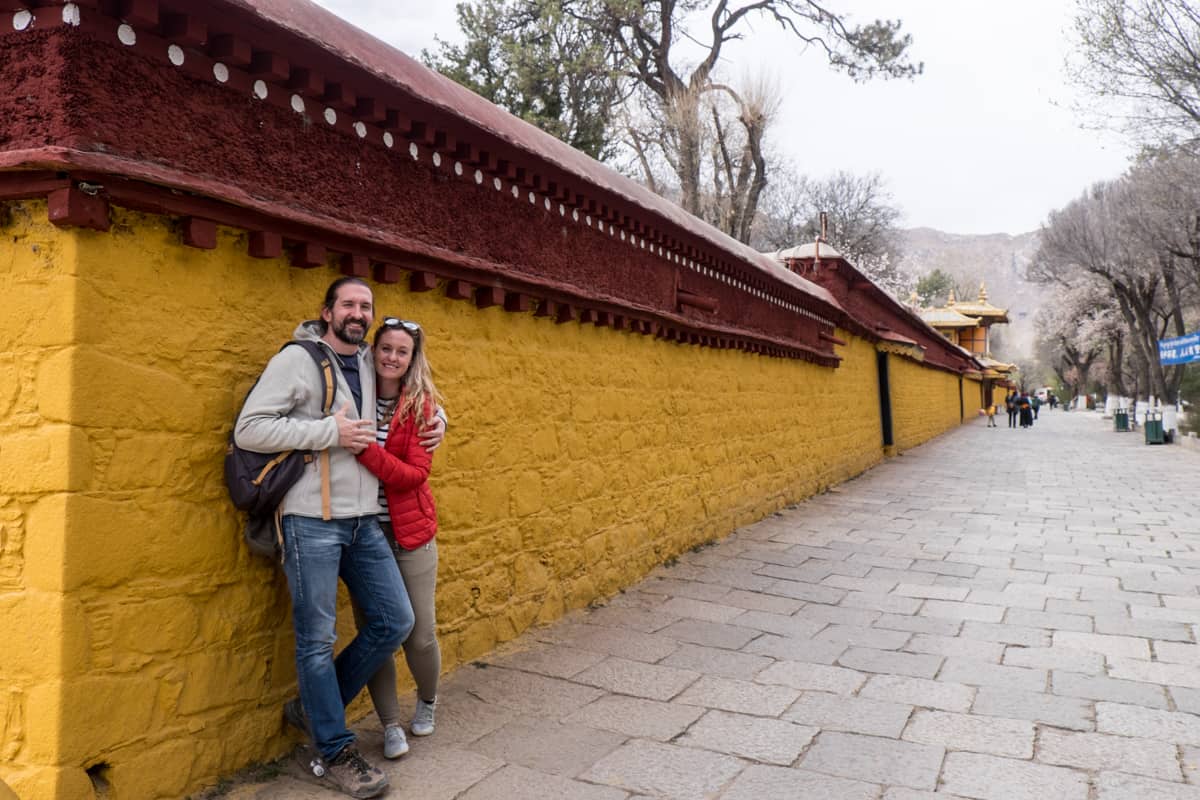
- Sunglasses and sunscreen. Particularly in the morning to mid-afternoon in Lhasa, the sun was extreme. A sun hat is recommended for those more sensitive to the heat.
- Silk sleeping liner for an extra layer at Everest Base Camp and monastery stay and a head torch since the toilet is in a separate building outside of your room. If you have the time to shop around, you can also find these items in Kathmandu before the trip start.
- Toilet paper for roadside ‘nature toilets’ and squats.
- Hand sanitiser (diarrhoea is one of the main health issues for Tibet)
- A Microfibre travel towel is a good, lightweight extra (where you might need a fresh, clean towel or for use at EBC).
- Snacks for sustenance on the road. I usually take a week’s worth of protein and healthy snack bars .
- Painkillers (also to help with early-onset symptoms of altitude). I was able to get stronger 600mg Ibuprofen, only on prescription from my doctor. However, they were vital in curbing the early onset of migraines which would have caused further sickness.
Take crisp, new dollars with you for exchange in Tibet to Chinese Yuan. The ATM didn’t work for everyone. It was also impossible to get a large number of Rupees changed to dollars while in Nepal.
Altitude sickness can occur in some people around the 2,500 m, but everyone is different. For example, I start to feel sick at 4,000m, and it has taken a few trips and treks to work that out.
But the high altitude in Tibet isn’t something to be worried about. The trip is designed to allow enough time in Lhasa to acclimatise and includes many ‘high to low’ drives to cover various altitudes, so your body adjusts. There’s a precise science to the trip itinerary, the route and the designated stops that has you covered without you having to overthink it, but here are some extra t ips for avoiding altitude sickness when in Tibet.
Avoid intense activity when you get to Lhasa. Our trip specifically had four days on the ground to ensure enough time to acclimatise and take things slowly. Stroll, and rest when you feel your body is getting tired. It’s always about listening to your body.
Say hydrated . Drink plenty of water and get plenty of sleep. Dehydration and fatigue are not what you need on this trip when some days involve a lot of sightseeing and long walks around sites. You can pick up dehydration sachets in Kathmandu, which you’ll find in all supermarkets stocked up for those about to go trekking. Or take electrolyte drinks, tablets or salts with you .
Be aware of your body as you slowly climb to a higher altitude . Our G CEO carried a finger pulse monitor, and each day we wrote down our heart rate and oxygen levels. This daily test allowed him to monitor anyone in the groups who could be sick or face any potential issues ahead of time.
You can purchase Diamox tablets in Kathmandu before the trip. However, we managed to find a herbal tablet version in Lhasa that we could begin taking as we were leaving Lhasa to prepare for higher altitudes.

Travel Tibet and Come Back Changed
Tibet is an emotional dive into an ancient Buddhist culture and a journey through the Himalayan plateau’s highlands. A sensorial spectacle on multi-levels that you won’t ever forget.
For further information on the Tibet tour, including the departure dates during the seven-month travel window, see the High Road to Tibet trip overview . I travelled with G Adventures as an ambassador to promote destinations responsibly and where tourism money and practice is used for social good.
Travel Tibet and see it from a different perspective
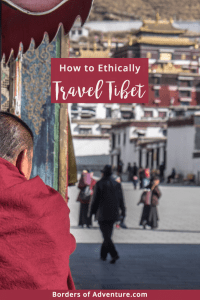
About Becki
Becki Enright is a British Travel Press Award-winning writer whose work focuses on changing perceptions about misunderstood aspects of destinations. Her writing combines storytelling with insight into the social, historical, political and economic factors that shape the country or place in relation to tourism. Becki has appeared live on Sky News and CNN and has contributed to high profile media including National Geographic, Time.com, Guardian online, New York Times, Grazia and Buzzfeed.
Tenzin says
6 January 2021 at 10:43 am
I thoroughly read your whole article about Tibet travel and really mind-blowing! I love the place and the people in Tibet.
31 October 2019 at 7:19 am
Tibet is really an amazing place with wonderful people. The uniquely spiritual place offering fabulous monasteries, breathtaking natural views, stunning high-altitude treks as well as one of the friendliest people. By traveling in Tibet, you will appreciate the visual feast and experience a lifetime cultural encounter.
Deborah says
25 July 2019 at 6:41 pm
This looks amazing. Thank you for this really thorough look into what a trip to Tibet can be and all the details to keep in mind. Great read!
26 July 2019 at 11:41 am
Thank you, Deborah!
25 July 2019 at 11:54 am
I had no idea Tibet was so fiercely policed – it seems crazy to me that you can’t even enter with a ‘Tibet’ guidebook! But I really admire and respect your view point on this, Becki: it would be very simple to just not go as some form of boycott or protest, but I think it’s important to visit to meet people, support their economies and take in the reality for yourself – without bringing your own political agenda on board and trying to place others (i.e. tourguides) in compromising situations.
25 July 2019 at 2:48 pm
It can be a hard choice for many, in choosing to go or not. But my stance, as you picked up, is always to go and witness things for yourself, make your own informed decisions and support the local people. China’s control here does exist with paranoia, and the situation is complex, delicate and emotionally charged. Yet, Tibet is somewhere with such immense beauty and unique spiritualism that it should be experienced. All we can do is tell our stories.
Leave a Reply Cancel reply
Your email address will not be published. Required fields are marked *
- Article Archives
- Work with me
- Privacy Policy

- Travelogues
- Travel Agent Cooperation
.jpg)
Why Traveling from Tibet to Nepal Should Be on Your Bucket List
Tibet is often known as the roof of the world for its high elevation on the Qinghai-Tibet Plateau. With its high mountains and lush green valleys, the region is one of beautiful landscapes and wildlife. Full of monasteries and a unique culture, Tibet is a land where the mysteries of the universe are part of everyday discussion, and where drinking butter tea and eating Tsampa are seen as normal. For those who have traveled the rest of the world, you can guarantee Tibet has something that you have never seen. From the debating monks of the various monasteries to the nomadic herdsmen with their yaks on the wide, expansive prairies, the region is unique in both culture and religion, and it is sometimes hard to know where one stops and the other begins.
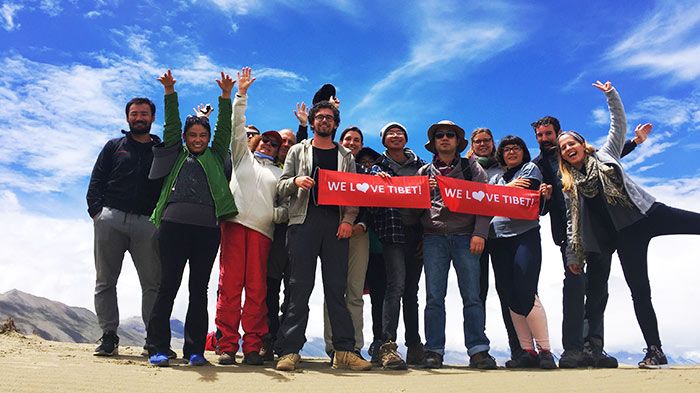
Nepal, similarly, is well known for its beautiful alpine scenery and tropical landscapes, as well as the sights in Kathmandu. With high mountains on the border with Tibet, Nepal can also offer some great mountain adventures, and also has a base camp at the foot of Everest, on the Nepali side of the mountain. Lower down the scenery turns to that of more tropical and sub-tropical climates, with lush green valleys, full of dense forests and clear lakes.
Experiencing the Tibetan Alpine Scenery and the Difference to the Nepali Landscape and Topography
At the high altitudes of Tibet, the scenery is often one of lofty mountains and arid lands, dotted with expansive lakes and tundra. Only in the summer months, when the monsoon rains come, do the valleys and plains turn a very lush green, full of new vegetation, and host to hordes of local and migratory birds, as well as the varied wild animals that inhabit the region. The scenery in Tibet is astounding, and will make you wonder why you never visited before, with the most breathtaking views of the high mountains, and the cold waters of the lakes.

Tibet is now well known for its tours, and thousands of foreign tourists visit every year to experience the unique landscapes and culture of Tibet. The land abounds with monasteries, both ancient and recent – well, as recent as the 18th century – and many of them are included in Tibet tours . The spectacular sight of the Potala Palace rising on high above Lhasa is one of the most breathtaking sights in Tibet, beaten only by the views of Everest and holy Mt. Kailash. Jokhang Temple , also in Lhasa, is renowned for being the center of Tibetan Buddhism, and is the most revered of all the temples and monasteries in Tibet.

Further afield you will see the high peaks of mountains such as Everest, Kailash, Shishapangma, Nojin Kangsang, and many others, as well as some of the most beautiful lakes in the world. Lake Namtso , which can be seen from the train, is one of the holy lakes of Tibet, and is known as “Heavenly Lake” in Tibetan. Lake Yamdrok is another beautiful sight, with snow-capped mountains on all sides. The lake is shaped like a fan, and in Tibetan, Yamdrok means “the Lake of Swans”. One of the most amazing sights at Namtso is that of the pilgrims who come to the lake to walk the kora around its perimeter, prostrating themselves in prayer at certain points around the lake.
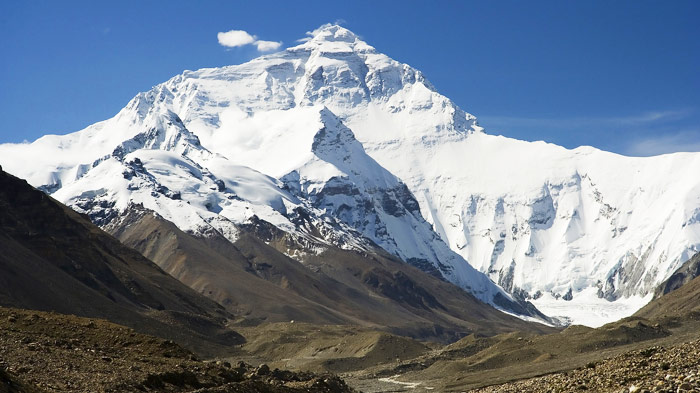
Across the border in Nepal, the topography is a little different, with less of an arid, tundra landscape, and more green valleys and forests. At a lower elevation than Tibet, Nepal has a different diversity of flora and fauna to Tibet . Large forests cover huge expanses of the countryside, with high mountains towering above low-lying, green valleys. The landscape changes as the elevation decreases towards the low Terai Plains. In the Himalaya region of the country, the elevation ranges from 4,000 to 8,000 meters, but drops drastically to the mountains below, averaging around 3,000 meters above sea level. The Mahabharat range, which lies even lower, extends to 2,700 meters at its highest point, before the landscape drops away to the lower Churia Hills.
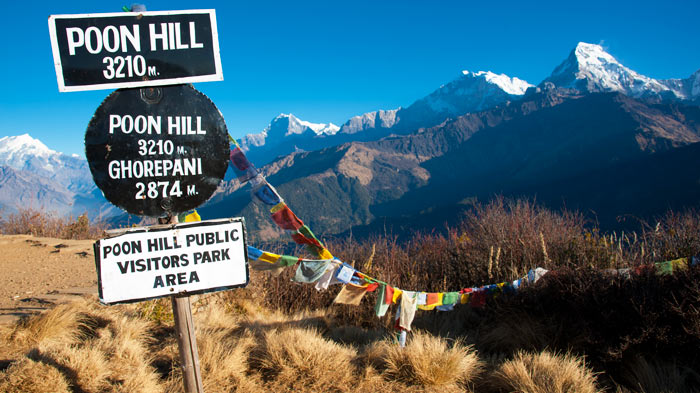
Trekking in the two places is also just as different as their geography. In the high altitude of Tibet, all treks are hard, with low oxygen levels, and rougher, harsher terrain. In Nepal, many treks are done at the lower levels, with only a few reaching the high Himalayan elevations, such as the trek to Everest Base Camp. For many treks in Nepal, the terrain is less rough and harsh than in Tibet, with more grasslands and tree-filled valleys to cover.
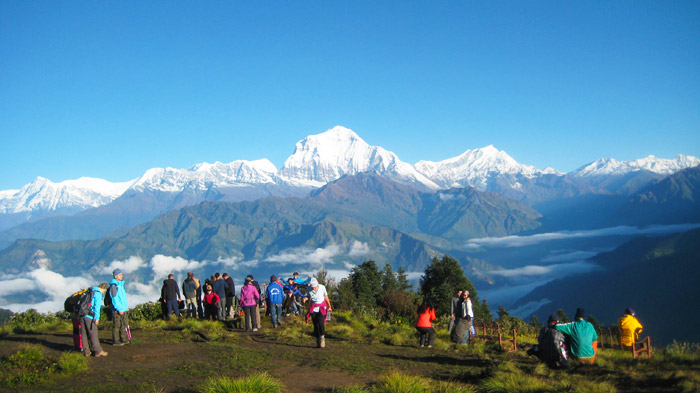
There are other sights that can be seen in Nepal as well as the grassy plains and green valleys. Lumbini is one of the most famous Buddhist pilgrimage sites in Nepal, and is the place where the Buddha, Siddhartha Gautama was born in 623 BC. One of its most famous pilgrims was the Indian emperor, Ashoka, whose pillar still stands in the world famous gardens. And the first ever national park in Nepal, the Chitwan National Park , is one of the best places to visit for animal lovers. They have hundreds of species of birds and animals in the reserve, including the Royal Bengal Tiger, The Gharial Crocodile, and the One-horned Rhinoceros.
>> Join-in the Most Popular Tibet Trekking Tours
Exploring the Mystery of Tibetan Buddhism and Nepali Hinduism and the Connections Between the Two Religions
While Tibet is a predominantly Buddhist region, Nepal was traditionally a Hindu state. Hinduism is the majority religion in Nepal, and has a profound influence on its social structure. With over 80% of Nepalese being Hindu, there is some issue as to the complexity of religion in Nepal. Many people, who naturally follow Hinduism, also practice aspects of Buddhism. And since both religions are Dharmic religions, it is not unusual for both religions in Nepal to accept, and even practice, each others religions. Combined religious beliefs are fairly common, and a 2015 constitution has allowed equal rights to all religions in the country. Tibetan Buddhism is also practiced in certain parts of Nepal, and some of the regional people are practicing it as their sole religion, instead of Hinduism. And there is a major connection between the beliefs and rites of both Hinduism and Buddhism in Nepal.
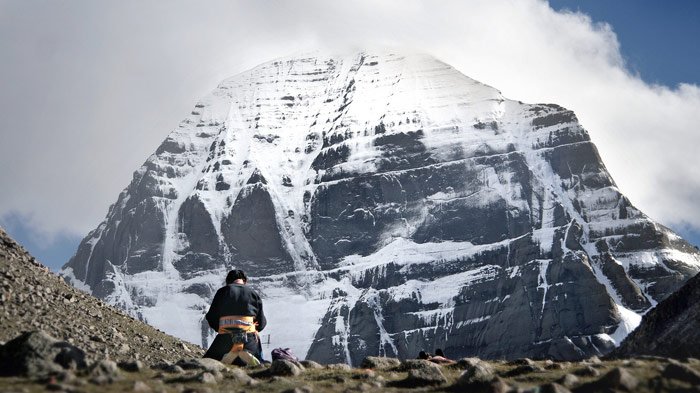
The best example of the connection lies in the holy Mt. Kailash, in Tibet. This mountain exists as a part of both Hindu and Buddhist religions, as well as playing a major part in Jainism and Bon. Both Hinduism and Buddhism believe that the mountain is the center of their religion. In Hinduism, the mountain is the home of Lord Shiva, the destroyer of evil, and he resides at the summit where he sits in eternal meditation with his wife, Parvati. The four faces of the mountain are believed to be made of crystal, ruby, gold, and lapis lazuli, and it is known to be a pillar of the world, located at the heart of six mountain ranges that make the shape of the lotus.
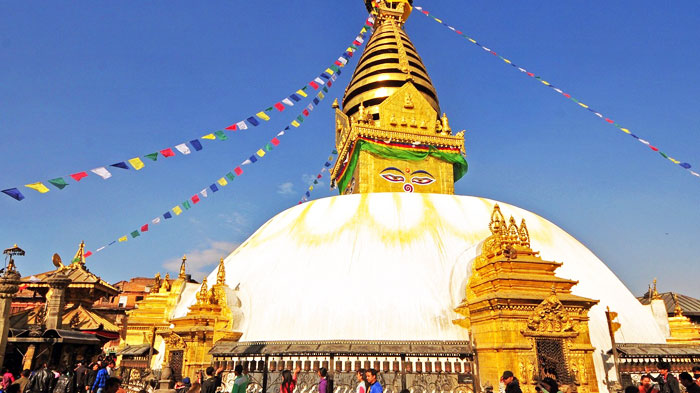
Buddhists believe that the mountain is the home of the Buddha Demchog, also known as Chakrasamvara, who is believed to represent supreme bliss. It is also the site of the ancient battle between Milarepa and Naro Bon-chung, the leader of the Tibetan shamanic religion known as Bon, and where Milarepa defeated him thus bringing Buddhism as the main religion in Tibet.
There are also a number of Buddhist temples and monasteries in Nepal, such as the Swayambhu Mahachaitya in Kathmandu, the Maya Devi Temple at Lumbini, and the Namobuddha Monastery at Simalchaur Syampati. For people on a journey of pilgrimage, these sites are popular destinations, with travelers coming from India and further to visit. For tourists, they show another side to the Buddhist monasteries from those in Tibet, and are just as fascinating in their structures and histories.
>> Join-in the Most Classic Mount Kailash Tours
A Taste of the Distinct Tibetan and Nepalese Cuisine, and the Comparisons of the Cuisines
Nepal is a place where the tastes of many different countries come together. While the country has its own popular dishes, much of the cuisine in Nepal is a combination of ingredients, characteristics and techniques from the neighboring countries. However, Nepalese food has had its own gastronomic history as well.
Just as the people of Nepal have many different backgrounds and ethnicities, so does the food in this region of the Himalayas. Nepalese dishes are usually healthier than most South Asian cuisine, and useless fats and more vegetables, salads, and lean meat . And since the country only opened up to foreign trade in the 1950s, it has added to the focus on using locally grown produce in the Nepali diet.
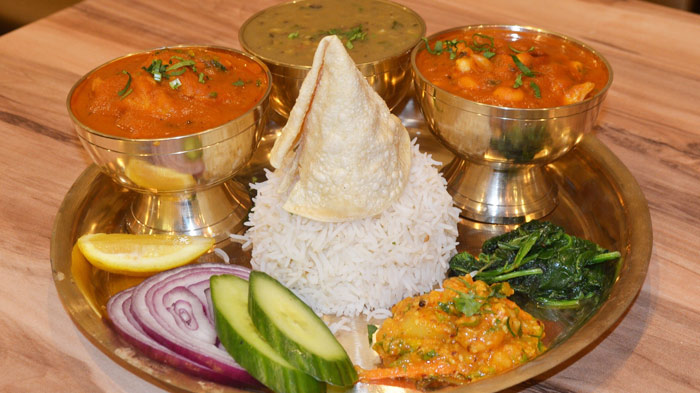
There is a tendency to use more spices in Nepalese food than in Tibetan, although the use of vegetables and yogurt is common between the two cuisines, as are the momos , thukpa – a version of a thick noodle soup. However, Nepalese cuisine is typically Asian in its use of rice . Unlike in Tibet – until recently – rice is a staple of the typical Nepalese diet, and can normally be found at most meals. However, unlike other Asian countries, there is a tendency across Nepal to serve Pulao , cooked rice with vegetables and lightly seasoned with turmeric and cumin. Known in the west as Pilaf or Pilau rice, this is popular throughout the country, and is often served with accompaniments such as yogurt and papadums.
Detailed Guide to Lhasa to Kathmandu Tour with Poon Hill Trek in Pakhara, Nepal
One of the best tours to cover the sights of both Tibet and Nepal is the forteen-day tour from Lhasa that incorporates Shigatse, Everest Base Camp, Mt. Kailash, Kathmandu, and Poon Hill in Pokhara.
Day 1 Arrival in Lhasa
The tour starts in Lhasa, after taking the train across the Qinghai-Tibet Plateau. You will have the chance to rest and get used to the increased elevation in your hotel.
Day 2 Lhasa Tour - Potala Palace, Jokhang Temple, Barkhor Street
On the second day your first stop will be the world famous Potala Palace , the winter palace of the Dalai Lama. Sitting atop Moburi (Red Hill), the palace looks down on the town of Lhasa from its 3,750-meter vantage point. The temple dates back to the 7th century, and houses artifacts and works of art from throughout Tibetan History. The palace also has the gilded burial stupas of the past Dalai Lamas, and below ground lies the ancient meditation cave of the 33rd King of Tibet.
After some lunch, you will head downtown to Jokhang Temple , the primary seat of the Gelugpa sect of Tibetan Buddhism. It was built by the 33rd King of Tibet in 647AD, and is the spiritual center of Tibet and the holiest temple in Tibetan Buddhism. Inside sits the most precious object in the temple, a life-sized statue of Buddha Sakyamuni when he was just 12 years old. Adorned with many precious gems, this gilded statue is the most sacred object in Tibet.
Running around the temple is the famed Barkhor Street . As well as the route of the holy kora, or religious circumambulation, it is also the site of many sellers where you can buy authentic souvenirs from across the region. You can join the pilgrims on their clockwise walk around the temple.
Day 3 Lhasa Tour - Drepung Monastery, Sera Monastery
The day is spent on a trip outside Lhasa, first to Drepung Monastery , one of the Great Three monasteries of the Gelugpa sect. Sitting at the foot of Gambo Utse, 5 kilometers outside Lhasa, it was founded by Jamyang Choge, one of the disciples of Tsong Khapa, in 1416. The Ganden Potrang, sited in the southwest corner of the monastery, was the former residence of the Dalai Lama, until the move to the Potala Palace.
In the afternoon you will travel back across the city to the northern suburbs, to visit Sera Monastery , another of the Great Three monasteries. Founded in 1419, the name, Sera, means "wild rose" in Tibetan, and was named because of the roses that were in bloom on the hill behind it when it was built. The main attraction of the monastery is the colorful and animated debating of the monks, held under the trees in the debating field every afternoon.
Day 4 Lhasa (3650m) to Shigatse (3900m) Via Gyantse
In the morning, our guide will drive you from Lhasa to Shigatse, Tibet's second largest city. En route to Shigatse you will pass over Gampala Pass, which lies at an elevation of 4,790 meters, and will pass the amazing Lake Yamdrok . At 4,400 meters above sea level, the lake lies nestled between lofty mountains, and you will see the holy mountain, Nyenchen Khangsar , its 7,191 meter peak standing tall in the distance. The trip to Gyantse passes close by the Karola Glacier , and at Manak Dam Lake you will be able to hang a prayer flag at the Simila Mountain Pass .
In Gyantse, you will get to visit the unique Pelkor Monastery , which is rare due to it housing three different sects of Tibetan Buddhism under one roof. You will also get to see the Gyantse Kumbum , a giant architectural stupa that stands 34 meters high. After another hour and a half of driving you will reach Shigatse, and will be able to visit the traditional barley mill and in summer you can view the spectacular sight of the barley fields in full crop.
Day 5 Shigatse (3900m) to EBC (5200m) Via Tingri
Before leaving Shigatse, you will get to visit the seat of Tibet's second highest spiritual leader, the Panchen Lama, at c . After obtaining your Alien's Travel Permit, which is needed to tour this area, you will leave Shigatse for Lhatse, a small town where you can get a nice lunch.
On the drive on to Shegar, weather permitting, you will get your first look at the amazing sight of Mt. Everest , or Mt. Qomolangma as it is called in Tibetan. The route will go over the Tsola Pass, at 4,600 meters, and the Gyatso-la Pass, which is higher at 5,248 meters. On entering the Mt. Everest National Nature reserve you will be able to enjoy the amazing panoramic view of the Himalayas as you travel over Gawula Pass, at an elevation of 5,198 meters. After arriving at Rongbuk you will be able to rest from the long drive, ready for the trip to EBC.
Day 6 EBC to Gyirong Border
In the morning you will first visit Rongbuk Monastery . The highest monastery in the world, at 5,000 meters above sea level, it is part of the Nyingmapa Sect of Tibetan Buddhism, and is unique in that both monks and nuns live together in the same monastery. From there it is a short hike of 4km to EBC, where you can take photos of the peak from the best vantage point, the closest place to Everest it is possible to get.
After EBC, you will drive to Gyirong port , taking in the breathtaking vista of Mt. Shishapangma and Pe-kutso Lake . The road goes past the Ghungtang Lhamo, at 5,236 meters, and you will arrive in Gyirong in the late afternoon.
Day 7 Gyirong to Nepal Border
In the morning, your guide will assist you to exit China, and will see you off at the border with Nepal. After transferring to Kathmandu, you will get to rest in your hotel, or spend the rest of the day looking around the local area.
Day 8 Tour around Kathmandu
A full day is set for visiting the areas in and around Kathmandu, and giving you time to prepare for the six-day trek ahead.
Day 9-14 Poon Hill Trek in Pokhara
After you rise from a good night’s sleep, you will travel to the Annapurna region, for trekking at Poon hill. Poon Hill offers the best trekking in Nepal , with spectacular mountain scenery, and dense forests of rhododendrons that are full of birds and small animals.
From Pokhara you will drive to Naya Pul, where you will start the trek to Tikhe Dhunga . This leg of the trek takes around four hours, and you will stay overnight in a lodge. In the morning you will leave Tikhe Dhunga for the trek to Ghorepani, which takes around six hours of walking. The trek here is mainly uphill, and the destination is already 2,850 meters. After staying the night in a lodge, you will take the final leg of the trek to Poon Hill, which takes at least six hours, and rises to an elevation of 3,200 meters.
For the route back, the trail goes on a different path first to Tadapani, a six hour walk, and then to Ghandrung the following day, which takes around four hours. The last part of the trek, to Pokhara, goes via Birethanti, and is mostly downhill to the destination at just 820 meters. Finally, the last day is spent driving back from Pokhara to Kathmandu, where you will be able to rest in your hotel.
>> Check the Most Recommended Tibet and Nepal Tours

About the Author - Kham Sang
Kham Sang is responsible and honest with more than six years of guide experience in Tibet.She has strong interpersonal skills and can communicate effectively with tourists.
Email me about your travel idea
https://plus.google.com/112791612136762180050/
Read all my articles about Tibet travel
Related Articles & Posts
Kyirong Village: the gateway village between Tibet and Nepal
For those who are planing a Nepal Tibet overland tour or traveling Nepal from Tibet by overland? Kyirong Village is the ...
Why One Should Enjoy Lhasa to Kathmandu Overland Tour Via Gyirong Port?
Lhasa to Kathmandu overland tour is truly one of the most exciting and exotic tour packages on earth. And throughout Gyi ...
Top 7 Attractions in Gyirong County in Tibet
Gyirong is well known for its wonderful tourist attractions. Check out the following interesting destinations for the mo ...
Gyirong Valley: A Comprehensive Guide to the Secret Garden in Tibet Himalaya
Although most tourists still just take it as a resting place for crossing the border, Gyirong Valley has a lot of places ...
Ten Must-try Restaurants during your Tour in Kathmandu, Nepal
Find best and top dining places in Kathmandu to eat varies of local cuisine of Nepal during your travel in Kathmandu. He ...
Tips on Everest Base Camp Trekking in Nepal
This travel guide provides many useful trekking information towards trekking in Everest Region in Nepal. ...
The Direct Regular Bus From Lhasa to Nepal Is In Service
The direct regular bus from Lhasa to Nepal is in service, and there are some attentions travellers need to know. ...
The Latest News About Zhangmu Border
Recently, a carpool ad to Zhangmu port was seen on Tamil street, but it is proven to be a rumor. Zhangmu port remains c ...
Have a Question? Ask below or call +86 28 81754631
Question Summary *
Please fill in your contact information, we will send you the answer by email
Country * : United States India Australia Malaysia United Kingdom Singapore Canada Germany China France Indonesia Hong Kong, China Netherlands Spain Italy New Zealand Brazil Mexico Thailand Switzerland Japan South Africa Nepal Philippines Russia Sweden Belgium Argentina Austria Ireland Israel Chile Vietnam Denmark Bangladesh Poland Portugal Sri Lanka South Korea Oman Romania Pakistan Other Colombia Hungary Taiwan, China Finland Greece Turkey Norway Mongolia Bhutan Bulgaria Costa Rica Myanmar Saudi Arabia Slovenia Ukraine Lithuania Egypt Qatar Mauritius Serbia Ecuador Uruguay Iran Niger Venezuela Cyprus Lebanon Nigeria Honduras Latvia Peru Guatemala Belarus Cambodia Estonia Kenya Macau, China Malta Tunisia Albania Bahrain Jordan Luxembourg Andorra Azerbaijan Georgia Guinea Kuwait Panama El Salvador French Guiana Iceland Kazakhstan Macedonia Micronesia Montenegro Morocco Paraguay Tanzania Uzbekistan Zimbabwe Anguilla Armenia Belize Benin Bolivia Botswana Dominica Eritrea Ethiopia Fiji Laos Liberia Libya Malawi Mali Moldova Monaco Namibia Norfolk Island Reunion Island Somalia Swaziland Tajikistan Turkmenistan Tuvalu Yemen Zambia Afghanistan Algeria Angola Antarctica Aruba Bahamas Barbados Bermuda Burkina Faso Burundi Cameroon Chad Comoros Djibouti East Timor French Polynesia Gabon Gambia Ghana Gibraltar Greenland Grenada Guadeloupe Guam Guernsey Guyana Haiti Iraq Jamaica Jersey Kiribati Kosovo Lesotho Liechtenstein Madagascar Maldives Martinique Mauritania Mayotte Island Montserrat Mozambique Nauru New Caledonia Nicaragua Niue Palau Pitcairn Island Puerto Rico Rwanda Saint Helena Saint Lucia San Marino Senegal Seychelles Sierra Leone Suriname Timor-Leste Togo Tokelau Tonga Islands Uganda Vanuatu Vatican City Western Sahara Western Samoa Costarica Croatia Czech Korea
SUBMIT Cancel
0 Comment ON "Why Traveling from Tibet to Nepal Should Be on Your Bucket List"
Check All Tibet Travel FAQs Here
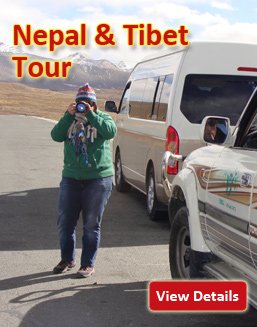
- Tibet Travel Advice
- Advice & Tips on Tibet Visa Application (6)
- Plan a trip to Everest Base Camp (22)
- Best Travel Time to Tibet (30)
- Keep Healthy in Tibet (14)
- Accommodation in Tibet (16)
- Tibetan Food and Restaurants (8)
- Money and banking in Tibet (3)
- How to Get to Tibet (9)
- How to Travel in Tibet (9)
- Taking train to Tibet (3)
- Tibet Tour Cost (7)
- Shopping in Tibet (2)
- Photography in Tibet (10)
- Etiquette and Taboos in Tibet (3)
- Trekking in Tibet (2)
- Biking in Tibet (1)
- Children and Old people to Tibet (5)
- Things to Do in Tibet (6)
- Useful Travel Tips (25)
- River rafting in Tibet
- Tibetan Mountains

Ask a Quick Question
Your Full Name:
Your Email Adress:
More about Your Travel Plan:


A Complete Guide to Travel Nepal, Tibet, and Bhutan in ‘One Go’
Planning a trip to the Himalayan countries Nepal, Tibet, and Bhutan in ‘One Go? Here is a complete guide to help you plan the Himalayan single trip smoothly.
“Based on our experiences organizing Nepal Tibet Bhutan Tour packages for more than a decade, we present the most important things that you should know before traveling to these nations in a single trip.”
A trip to Nepal, Tibet, and Bhutan as 3 Country Himalayan destinations that cover three different countries in a single tour allowing us to experience the culture, tradition, history, and religion of each country. From the magical city of Kathmandu including ancient temples & palaces to the roof of the world of Tibet including the Potala Palace & monasteries in Lhasa and Tibet Everest Base Camp to the last Shangri-La, Bhutan to explore the cultural cities of Paro and Thimphu with a hike to Tiger’s Nest . This can be the complete combo trip to the Himalayas and learn about the culture, history, and religion (Buddhism and Hinduism) that are being practiced differently in each country.
How to plan the 3 Country Himalayan tours (Nepal, Tibet, and Bhutan)?
First of all, it is advised that you allow at least two weeks to explore these three beautiful Himalayan destinations and choose the best tour company that can help you plan all the arrangements including Visas and flights to and from Paro and Lhasa. 3 Country Himalayan Tours (Cross-Country) including Nepal, Tibet, and Bhutan can be started from any city such as Kathmandu, Lhasa, or Paro . Depending on your flight, destination, and cheapest fare; you can choose the cities to start your journey of 3 Country Himalayan Tours. However, some procedures need to be followed before you book the tour. Your tour operator can organize everything including Visas, flights, etc and it is wise to know everything before you plan this trip.
3 Country Himalayan Tours STARTING from Kathmandu
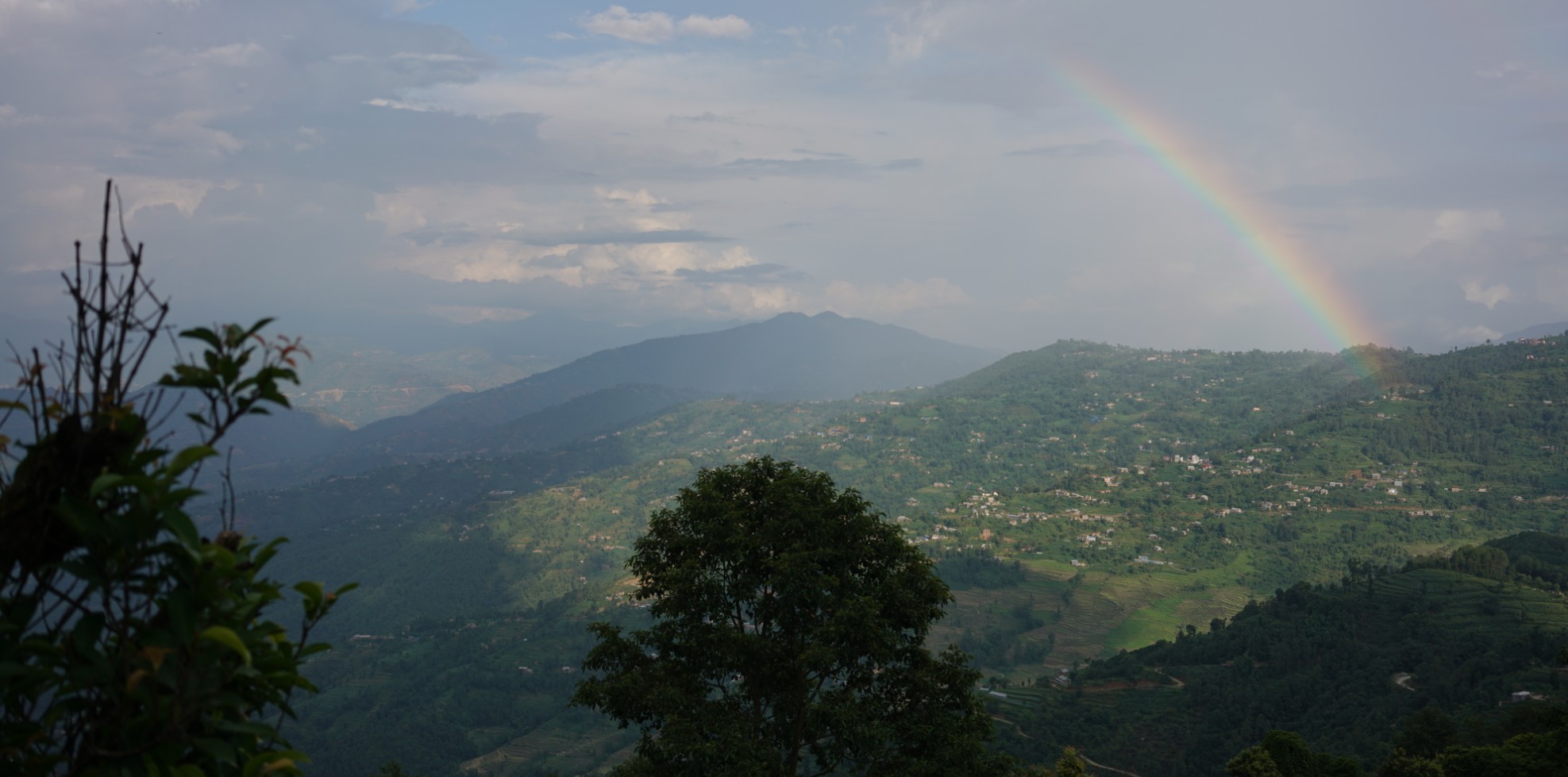
Trip Starts: Kathmandu (Nepal)
Trip ends: paro/kathmandu, itinerary in order: kathmandu (nepal) – lhasa (tibet) – bhutan, total no. of days suggested: 11-14 days.
“Currently, there is no direct flight available from Kathmandu to Lhasa. Instead, the flight must include a stopover in Chengdu, which contributes to the high cost of the airfare. Therefore, it is advised to initiate the journey from Beijing or another location in Mainland China and travel overland through the Kyirong border for a smoother travel experience. However, please note that this overland route will add an additional 3-4 days to the itinerary from Lhasa to Kathmandu. “
Starting the trip from Kathmandu could be the first choice for most travelers. It is much easier to plan the 3 Country Himalayan Tours including the flight and visa from Kathmandu. Tour agents based in Kathmandu are well experienced in organizing your tours professionally. However, it is important to select the best itinerary and tour company to have a hassle-free arrangement. Here are the point-wise suggestions that you can take into account before you plan a trip starting from Kathmandu.
- First of all, make sure your visa is valid at least 6 months before the tour start date and obtain a multi-entry Nepal Visa either on arrival in Kathmandu or your hometown. Send the color-scanned clear passport copy to your tour agent whom you are looking to book the entire trip after you confirm the tour and price. It is advised to book all three destinations with the same company to have a better experience.
- Allow at least 4 working days in Kathmandu to process the Tibet Group Visa (TGV) . Your original passport must be submitted to apply for the TGV at the Embassy of China in Kathmandu and your tour operator can process the visa on your behalf. Until TGV is issued, you can go for a tour around Kathmandu and its surroundings or take a half-day H elicopter tour to Everest Base Camp . If you are a fit hiker, you may go for Everest Base Camp Trek , Annapurna Base Camp Trek , Ghorepani Poonhill Trek , Kathmandu culture trek , or any other guided private day tours .
- It is advised to pick Tibet first and then Bhutan . This helps save your time and the Bhutan Visa Clearance can be ready during the trip to Tibet. You can choose Tibet tours from 3-4 days to 7-8 days, depending on your holiday time and budget. If you are planning a budget tour for 7-8 days in Tibet, you can choose 7 nights 8 days Kathmandu to Lhasa overland Tour which starts every Saturday from Kathmandu or you can plan a tailor-made private tour.
Suggested Itinerary | 3 Country Tour Nepal Tibet Bhutan – 11 Days
3 country himalayan tours starting from lhasa -arrive from china (beijing/chengdu) .

Trip Starts: Lhasa, Tibet (3650m) – Arrive from Beijing or Chengdu via flight or train
Trip ends: paro/kathmandu, itinerary in order: lhasa – kathmandu – bhutan, total days suggested: 11-14 days.
The 3 Country Himalayan tour can be started from Lhasa – before you book the flight and tour; you should be aware of the permit and visa requirements for the Tibet tour. If you are entering from Beijing or Chengdu to Lhasa via flight or train; make sure that you have the original permit in hand before you leave for Lhasa. You can plan the Lhasa-only trip or take an overland tour to Kathmandu via Everest Base Camp.
- To process the tour, you will be required to obtain a Chinese individual tourist visa in your home country and send it to your tour operator once you confirm the tour and price. Because only the tour company is allowed to take you around who issues the permit for you. So choosing a different company after getting permits is not possible.
- If you are working or studying in China, you will need to send the visa copy along with the leave/no objection letter from your concerned employer or university.
- Your tour operator will process the permits which take a minimum of 5-7 working days or it might take even longer during the peak season (July, August, and September).
- After the permits are issued in Lhasa, the original permits should be couriered to the address in China where you will be staying for a night (It is advised to stay at least a night in China). Send your apartment or hotel address where the agent can send them safely, grab your permits, and fly or train to Lhasa. However, in some routes, the color print of your permits is accepted.
After the trip to Tibet is over, you may fly into Kathmandu from Lhasa or take an overland tour to Kathmandu via the Kerung border . If you are traveling overland, there will be a guide at the border to receive you and take you to Kathmandu, it takes about 7-8 hours through the rough road to reach Kathmandu. Then, you can explore around Kathmandu and beyond before you fly to Bhutan.
Suggested Itinerary | 18 Days Classic Tibet Nepal Bhutan Overland Tour from Beijing
3 country himalayan tours starting from paro, bhutan.
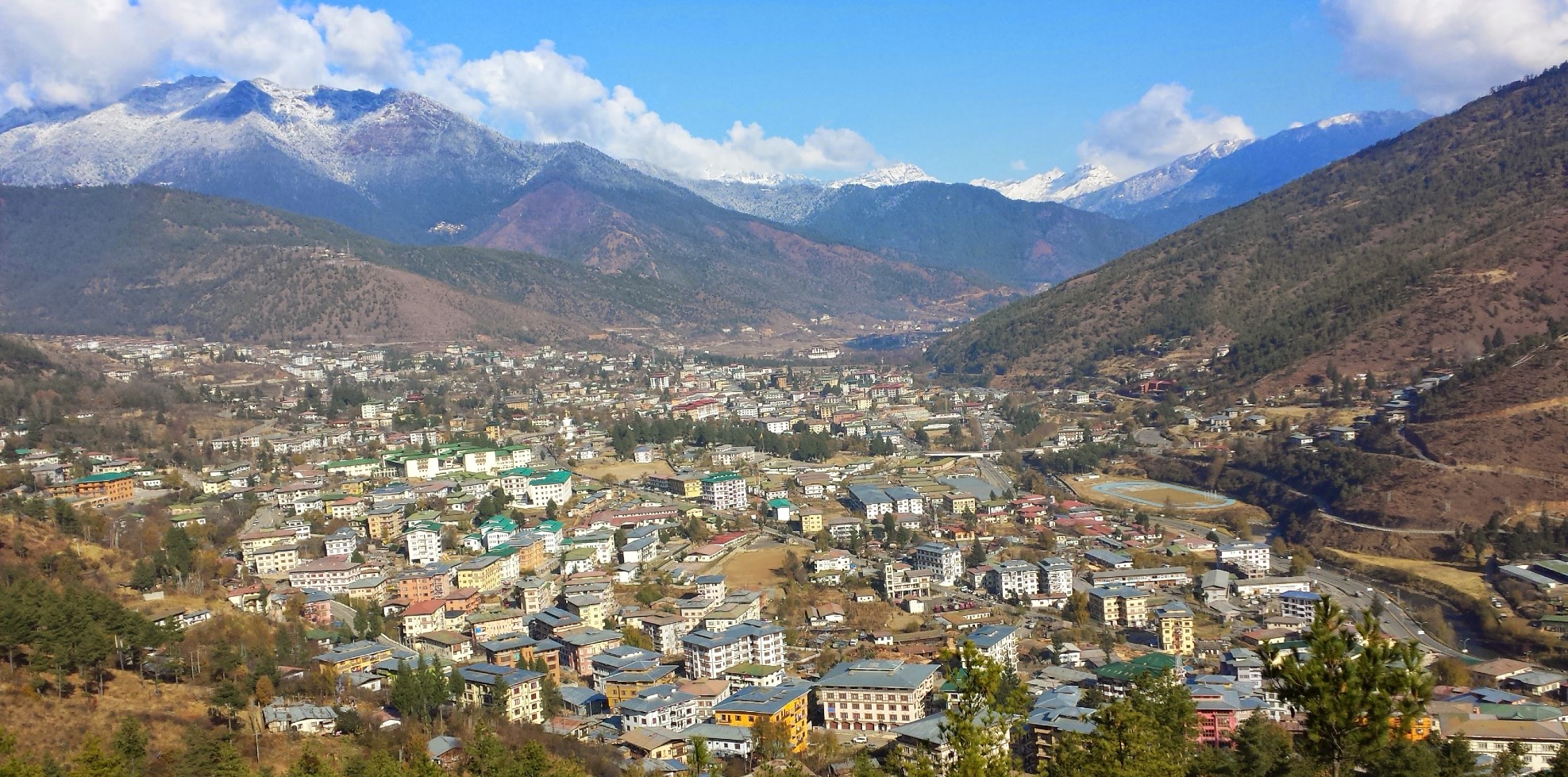
Trip Starts: Paro, Bhutan
Trip ends: lhasa (fly to mainland china/kathmandu), itinerary in order: bhutan – kathmandu – lhasa.
Same as Kathmandu, you can plan 3 Country Himalayan Tours starting from Paro, Bhutan. You can land at Paro airport from several destinations such as Thailand (Bangkok), India (Delhi, Kolkotta Guwahati, Bagdogra) Singapore, Bangladesh (Dhaka), and Nepal (Kathmandu) . There are two flights ( Du rk Air and Bh utan Airlines ) in operation, check the destinations and available dates before you confirm the date of your holiday to the Himalayas. After you complete the tour in Bhutan, you will fly to Kathmandu, a short flight from Paro to Kathmandu, you can enjoy the eye-level Himalayan vistas from the window – request for a left seat window for KTM to Paro and a right window seat for Paro to KTM. As described above, you will need to allow at least 4 working days in Kathmandu to process for TGV and fly to Lhasa or travel to Lhasa via border crossing.
3 Country Himalayan Tour BUDGET Plan
It is advised to travel in a group to minimize the tour cost as tailor-made private trips are expensive especially if you are traveling solo. Being two people & choosing 3 country tours for about 11-14 days with a 3-Star hotel stay with breakfast, guide, private transportation, and entrance fees; the budget would be between USD 3500-USD 5000 Per Person including flights and visas to/from Kathmandu. However, it depends on the package you choose, there will be varieties of budget to luxury versions and prices may differ accordingly.
RELATED CONTENT | Why not learn about Bhutan Travel Information and Tibet Travel Information ?
The destinations Tibet and Bhutan DO NOT allow independent travel and it is a must to hire a licensed guide. The trip has to be booked through the local tour company or any international associates. There are some group tours available for the Tibet tour that you can check before you book the trip. However, if you are a couple or group of friends/family of three or more with similar travel interests, it is wise to book tailor-made private trips to have a better travel experience.

Best time to go
It is possible to travel to three destinations all year round and getting the perfect weather for each destination at the same time can be difficult sometimes. Tibet is on the high Himalayan plateau and has arid weather and long winter the best time to visit Tibet is in during summer (June, July, August, and September) whereas Nepal and Bhutan share sub-tropical climates with four seasons such as spring ‘pre-monsoon’ (March, April, May), Summer ‘monsoon’ (June, July, August), Autumn ‘post-monsoon’ (September, October, November), and winter (December, January, February). Exploring only cities on this trip, all seasons are suggested, however; if you wish to choose the best months for combining the trip for all three destinations, it is recommended to travel during April, May, September, October, and November to enjoy the best weather/climate of three places of Nepal, Tibet, and Bhutan.
The Best tour package that you can choose from HimalayanWindows
There are several packages that you can choose or customize as per your requirements; here are some of the popular packages that are liked by our previous clients – take a look:
- 3 Country Tour (Nepal, Tibet Bhutan) – 11 Days
- Nepal Tibet Bhutan Culture Tour – Luxury Version – 12 Days
- Bhutan Tour from Kathmandu- 7 Days – Add-On Tibet, if you are interested
- Everest Base Camp Trek and Bhutan Tour- 17 Days – Add-On Tibet, if you are interested
- Himalayan Combined Tibet Nepal Tour- 14 Days – Add-on Bhutan, if you are interested
- Cultural Tour and Trekking (Nepal, Tibet, and Bhutan) – 20 Days
The purpose of this blog is to provide essential information for those planning a trip to Nepal, Tibet, and Bhutan as part of a single package. If the trip ideas mentioned above do not fully satisfy your requirements, please feel free to contact us at any time. It is important to note that rules and protocols, particularly in Tibet, can change unexpectedly. Therefore, it is wise to stay updated with the latest information before finalizing any decisions.
At HimalayanWindows, we are delighted to address any questions you may have and assist you in planning a once-in-a-lifetime trip. We wish you a joyful and safe journey as we emerge from the aftermath of the Coronavirus (Post-COVID-19) pandemic and gradually return to normalcy. Namaste!
*This blog was last edited by HimalayanWindows on July 4, 2023.
Have questions? Make us an enquiry, our experts will help you customize and plan your perfect trip. Let’s get started!
Related Posts
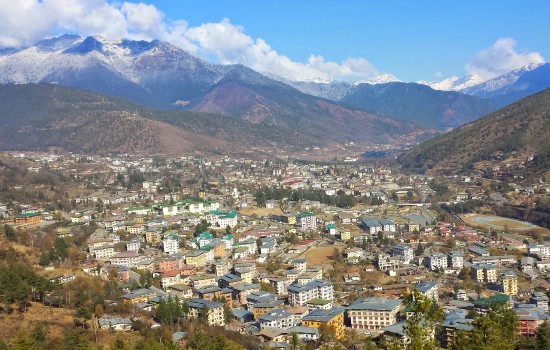
Bhutan: Best 10 Places to Visit in 2024
Introduction to Bhutan's Majestic Beauty Bhutan, a hidden paradise nestled in the…
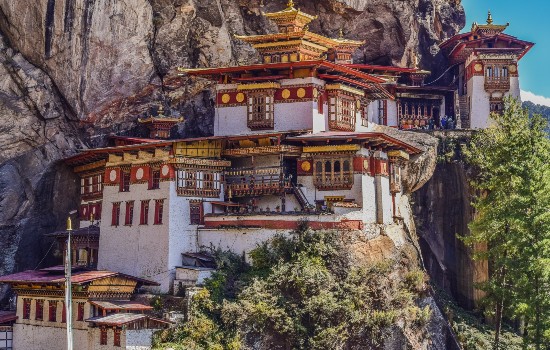
Bhutan Cuts Tourists Fee by Half to Boost Tourism
The Himalayan Realm of Bhutan is set to cut in half the…
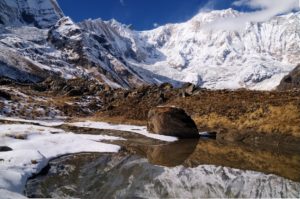
Journey of a lifetime: Trekking to Annapurna Base Camp
Embarking on the epic trek to Annapurna Base Camp is an adventure…

Planning Your Nepal Trip: Seasonal Insights and Practical Tips
Nepal, a captivating blend of majestic landscapes, rich cultures, and spiritual heritage,…
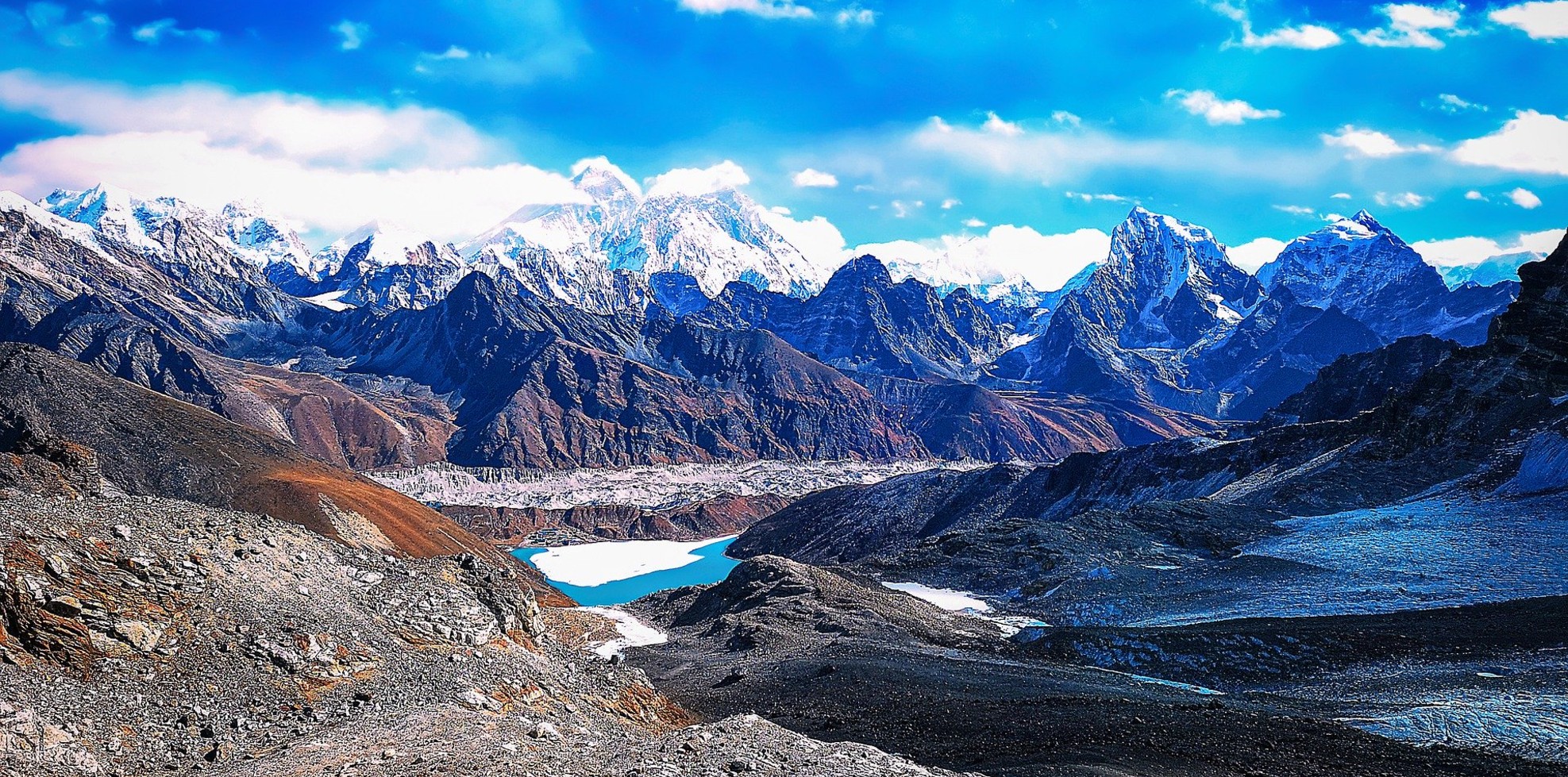
Best Time to Hike Everest Base Camp w/Pros & Cons
Gokyo Ri View When is the best time to Hike Everest Base…
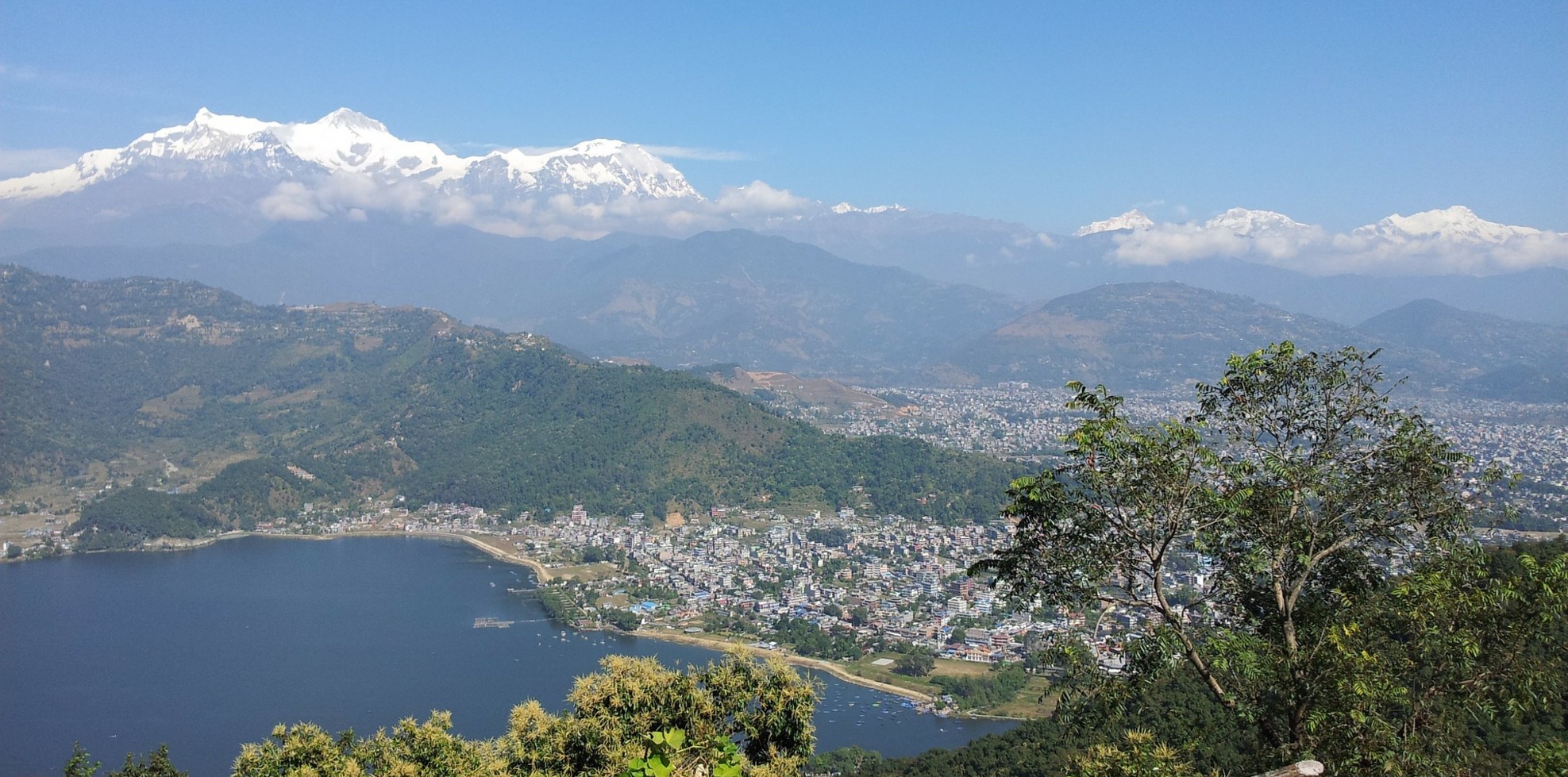
Explore the Enchanting Himalayas: Wonders of Nepal and Bhutan
Introduction: Embarking on a journey to Nepal and Bhutan is like stepping…


- Tibet Train Book
- Beijing to Lhasa
- Shanghai to Lhasa
- Chengdu to Lhasa
- Xining to Lhasa
- Guangzhou to Lhasa
- Hong Kong to Lhasa
- Chongqing to Lhasa
- Xian to Lhasa
- Lanzhou to Lhasa
- Xining to Shigatse
- Golmud to Lhasa
- Lhasa to Shigatse
- Tibet Train Tour
- Tibet Train Small Group Tour
- Beijing Tibet Train Tour
- Shanghai Tibet Train Tour
- Chengdu Tibet Train Tour
- Xining Tibet Train Tour
- Guangzhou Tibet Train Tour
- Hong Kong Tibet Train Tour
- Xian Tibet Train Tour
- Tibet Train Ticket Class
- Soft Sleeper
- Hard Sleeper
- Life Onboard
- Oxygen Supply System
- Dining Car onboard
- Luggage Restrictions
- Medical Service onboard
- Safety and Security
- Lhasa Express Train
- Qinghai-Tibet Railway
- Tibet Train FAQs
Tibet Travel Permit
- China Visa for Tibet Tour
- Mount Everest Travel Permits
- Mount Kailash Travel Permits
- Apply Tibet Permits from China
- Apply Tibet Permits from Nepal
- Tibet Small Group Tour 2022
- Lhasa and Surrounding Tour
- Everest Base Camp Tour
- Mount Kailash Tour
- Tibet Trekking Tour
- Tibet Overland Tour
- Tibet Cycling Tour
- China Tibet Tour
- Beijing Tibet Tour
- Shanghai Tibet Tour
- Chengdu Tibet Tour
- Guangzhou Tibet Tour
- Hong Kong Tibet Tour
- Tibet Nepal Tour
- Tibet Nepal Bhutan Tour
- Tibet Nepal India Tour
- India Nepal Bhutan Tibet Tour
- Beijing Tibet Nepal Tour
- China Tibet Nepal Tour
- Enquire Now
- Travelogues
- Travel Blog

How to Travel from Nepal to Tibet by Road
Last updated: August,19 2018
There are many ways in which one can travel to Tibet, by flight, by train, and by road . While the train is an amazing journey, it is quite long, taking from 22-55 hours to reach Lhasa, the center of Tibet. Flights can also be useful, especially for those who are strapped for time, as most of the flights into Lhasa take up to 6-7 hours at most, with the shortest being just 90 minutes.
However, driving to Lhasa in Tibet is an adventure in itself, and while the roads from mainland China to Tibet can be traveled as an awesome adventure, the best road route to Lhasa is the one that starts in Nepal . The route from Kathmandu, the capital of Nepal, to Lhasa is one that is not only adventurous, but has other advantages over flying and taking the train. Not the least of these is the experience of traveling over the border at the Gyirong crossing checkpoint, which crosses the stunning Trishuli River Gorge on the Resuo Bridge. One of the most beautiful sights of the lower Himalayas, the gorge runs deep below the bridge, with plant-covered sides dropping down to the rushing river far below.
Kathmandu to Lhasa Driving Route
The route from Kathmandu to Lhasa is long and winding, covering more than 1,000 kilometers up into the Himalayas and across the vast expanse of the Tibetan plateau. Starting in Kathmandu, which lies at an elevation of just 1,400 meters, the route heads northwest along winding roads to the small town of Bidur, 65 kilometers from the Nepali capital. From there the road turns north through Laharapauwa, where it enters the Langtang National Park. Continuing north, the route passes through the town of Dunche on its way to Rasuwagadhi Fort, the Nepali side of the Resuo Bridge and the immigration point for people entering Nepal from Tibet overland.
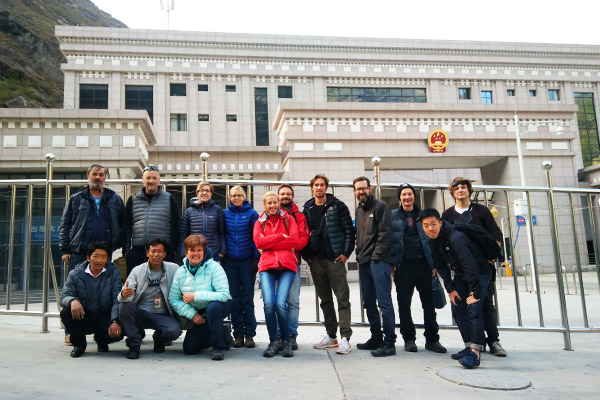
Once past the border crossing and into Tibet, where your guide and driver will meet you, the first stop is at Gyirong Town (2,800m), 24 kilometers from the border. A small town, there is little to see but the amazing landscape and the lush green valley in which it lies. The town has grown as a stopping point for tourists heading across the border in both directions thanks to the opening of the Gyirong Port border checkpoint in August 2017.
After Gyirong Town, the Kathmandu to Lhasa overland journey continues to head north for a short distance, before turning east on the S214 Provincial Road and passing a series of three lakes, each smaller than the last. Peiku-tso is the first and largest of the three, followed by Langqiang Co and Baikuimai Co, as the road heads on eastwards. Shortly after passing the lakes, the route turns onto the G318 National Road, also known as the Sino-Nepal Friendship highway, which runs all the way to Lhasa.
For those visiting Mount Everest, Old Tingri (4,300m), a short distance from the place where you joined the G318, marks the turning for the world’s highest mountain. Most travelers to Tibet that cross the plateau overland from Kathmandu to Lhasa stop at the Everest base Camp (EBC), to view and photograph this unique mountain.
After visiting EBC (5,200m), it is then back to the Friendship Highway and on eastwards to the second city of Tibet, Shigatse, at 3,830 meters above sea level. Home of the Tashilhunpo Monastery, the only monastery in Tibet that houses three separate schools of Tibetan Buddhism, Shigatse is one of the most stunning cities in Tibet, after Lhasa itself.
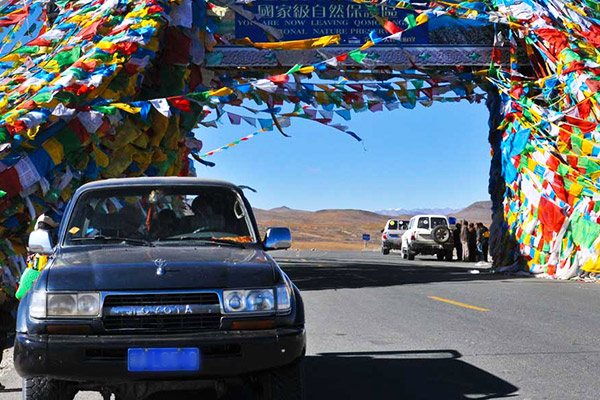
From Shigatse, the route separates from the Friendship Highway for a spell, as it heads along the S204 Provincial Road to the town of Gyantse (4,000m), which lies on the banks of the Nyang River, the longest tributary of the Yarlung Tsangpo River. Noted for the famous 32 meter-high Kumbum, a stupa with multiple tiers and 108 chapels, Gyantse is the home of the Pelkor Chode Monastery, the most important center of the Sakya School of Tibetan Buddhism.
After Gyantse, the route takes the S307 provincial Road, which takes you past the stunning Lake Yamdrok. One of the Great Three holy lakes of Tibet, Yamdrok is a spectacular sight, and the road runs alongside the western shore before turning north to Dagaxiang, where it rejoins the Friendship Highway. From Dagaxiang, the route heads through Quxu as it heads north, following the route of the beautiful Lhasa River until you reach the Tibetan regional capital, which lies at an elevation of 3,560 meters.
Required Travel Documents for Nepal to Tibet Overland Tour
For those traveling from Nepal to Tibet along the Friendship Highway via Gyirong port, there are certain permits and documents that are required before you can leave Nepal. These are normally obtained by your tour operator and can only be applied for once you have booked a Tibet tour.
The Tibet Travel Permit is the primary permit for all travelers to Tibet, and it is impossible to even board a flight or train to Lhasa without first showing the permit when boarding or checking in. For those traveling overland from Kathmandu, you will need the permit to show to the immigration officials at the border crossing at Gyirong Port.
The permit is applied for by the tour operator once you have booked your Tibet tour , and requires photocopies of your passport pages in order to process the application. Once it has been obtained, it will be used to obtain the other permits and visas required once you arrive in Kathmandu. The permits you need to travel across the border also include the Alien’s Travel permit, for travel outside Lhasa within Tibet and the Frontier Pass, which is needed for everyone traveling in Tibet near the borders with Nepal and India.
Chinese Group Visa
Instead of applying for a Chinese Entry Visa at the Embassy of the People’s Republic of China, traveling into Tibet from Nepal means that you need to have what is known as the Tibet Group Tourist Visa . This is issued by the Chinese Embassy in Kathmandu and is applied for by the tour operator once you arrive in Kathmandu. The application requires your original passport, as well as the Tibet Travel Permit and a completed application form.
Processing of the visa normally takes around three working days, so it is recommended that you arrive in Nepal at least five working days before your expected date of departure for Tibet. Our local office in Kathmandu will collect your passport and completed application form and make the application on your first morning in Nepal. The visa is normally ready for us to collect on the third day, after which we will deliver it to you for you to start your trip to Rasuwagadhi Fort and Gyirong Port.
>> See the detailed guideline about how to apply for Tibet Visa from Kathmandu Nepal
Highlights of Nepal to Tibet Overland Tour
The route of Tibet-Nepal highway is one of the most beautiful stretches of Tibetan landscape on the plateau, as well as the stunning, if a little scary, trip from the Nepali capital to the border. Getting there can be done by public bus or private car and takes around six hours on mostly gravel and dirt roads that are only single lane.
Beautiful Gyirong Gorge at the Edge of the Himalayas
Lying in the Himalayan foothills Gyirong Valley is one of the least known of all the stunning valleys in Tibet and is said to be the most beautiful valley on the entre plateau. The entire region of the valley, which stretches for more than 100 kilometers, is filled with alpine bushes and trees and rising mountain peaks, with villages and farms spread along its length. Starting at around 1,700 meters at its southern end, the valley rises in altitude to around 7,000 meters in the north, and this relatively closed valley has a unique ecosystem that changes as the altitude increase.
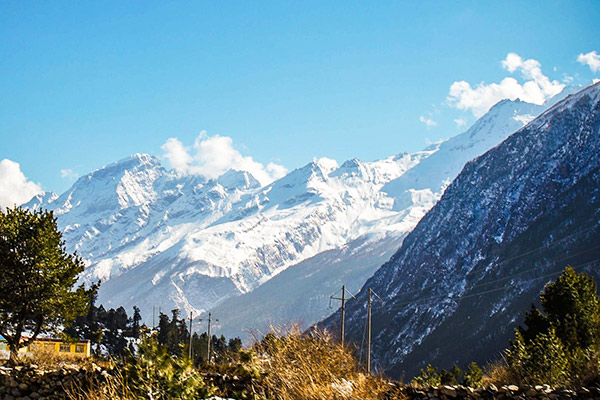
Drive across Peiku-tso Lake and View Mount Shishapangma
A stunning lake in Shigatse prefecture, Lake Peiku-tso lies alongside the S214 Provincial Road just after Gyirong Town. At 4,591 meters above sea level, the lake is shaped roughly like an hourglass and is surrounded by 6,000+ meter mountains. While still stunning, the brackish water of the lake shows that it has not overflowed into the Yarlung Tsangpo River for thousands of years.
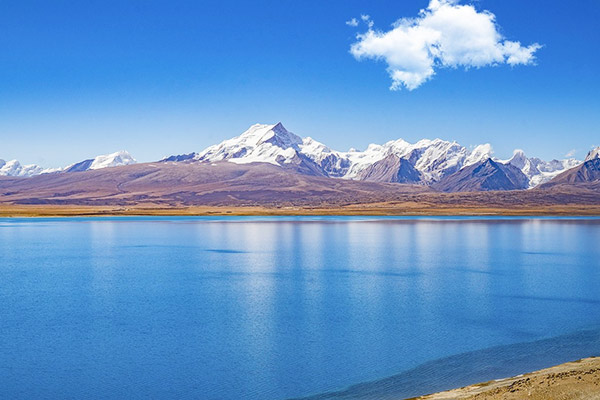
From the road that runs past the three lakes, a southward look shows the massive height of Mount Shishapangma in the distance, around 30 kilometers south of the road. The 14th highest mountain in the world, and the fifth highest in Tibet, this 8,027 meter-high mountain is the highest mountain that is wholly in Tibet and the last of the 8,000+ meter mountains to be climbed in the Himalayas, mainly due to its remote location.
Panorama View of Himalaya at Gawula Pass
On the road to EBC, the route passes over the Gawula Pass, one of the highest passes in Tibet at 5,198 meters above sea level. The view from the top of the pass is one of the most stunning in Tibet, with a panoramic vista of the Himalayas that stretches from Mount Shishapangma in the west t Mount Makalu in the east, including Mount Cho Oyu and Mount Everest in between. It is also one of the best places to get an uninterrupted view of Mount Everest with the rest of the Himalayas in the background.
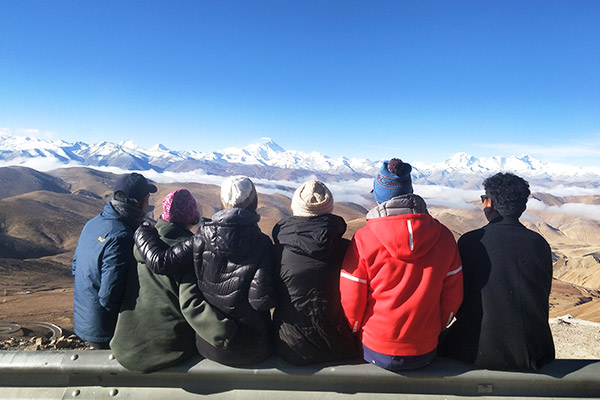
Stay Overnight at Everest Base Camp
Everest Base Camp (EBC) is one of the most popular tourist spots in Asia, and sees thousands of travelers stopping during their tours of Tibet. More easily accessible than its southern counterpart in Nepal, the base camp is easily reached by car, and the tent guesthouses are a popular place to stay while spending the night at the base camp. Authentic Tibetan tents, the guesthouses accommodate up to a dozen people in each, and it is the best place to stay from April to October for the morning view of the sunrise on the slopes of Mount Everest.
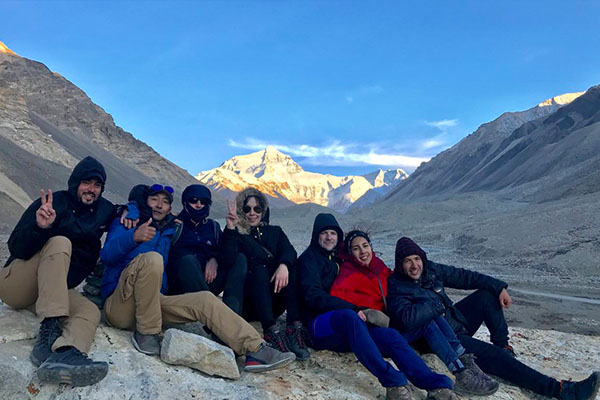
Best of the Central Tibet from Shigatse to Lhasa
After visiting the Everest Base Camp, you will follow the route from Shigatse to Lhasa to explore the central and southern area of Tibet. During the last section of the journey before reaching Lhasa city, you will visit the Tashilunpo Monastery in Shigatse, witness the Yamdrok Lake from the Gampala Pass and enjoy the marvelous view of the awesome turquoise Yamdrok Lake.
Travel Tips for Nepal to Tibet Overland Tour
While there is decent three to five-star accommodation in the major cities of Lhasa and Shigatse, most of the places you will stay along the route in the outlying areas will not be of the same standard. Some of the guesthouses in the towns do not even have hot running water. Expect basic accommodation when out of the bigger cities , and very basic guesthouses when staying at Mont Everest Base Camp and other remote sites.
The road conditions along the route to Lhasa from Gyirong is good lately , with asphalt roads for most of the route you are taking. There are some dirt and gravel roads in places on the lesser highways and Provincial Roads, although even the road to EBC is now almost completely asphalted.
Altitude is the biggest danger for anyone traveling on the Tibetan plateau, and the high altitudes of Tibet can often cause altitude sickness if not acclimatized properly. On the route from Kathmandu to Lhasa, there is an opportunity to stop in Gyirong Town for a day or two to acclimatize to the intermediate elevation at 2,800 meters. This intermediate acclimatization will help with acclimatizing to the higher altitudes, often up to more than 5,000 meters, and the higher altitude of Lhasa itself.
Related Readings:
Nepal Visa On Arrival
How to apply for Nepal visa on arrival? Almost any national can get a visa on arrival at the airport or border crossing, with a few exceptions. This article tells you the cost, process and requirements.
How Many Days in Nepal are Enough for Your first Nepal Tour?
For the first-times to Nepal, this article will give you some advice about where to go and what to see. If you like trekking, there are also recommended trekking route for your first Nepal trip.
How to Plan a Nepal Photography Tour
Nepal, where with the nature and culture and with the ancient Buddhist and Hindu traditions still exist, is a newly popular place for those amateur photographers who are interested at taking natural photos. This article will show you the attractions of a photography tour in Nepal and tell you what to prepare for a Nepal photography tour.
Ultimate Guide to the Himalaya Road Trip from Tibet to Nepal
Traveling from Tibet to Nepal is one of the most popular tours in the region, and driving along the 1,080-kilometers route that links Lhasa with the exotic Nepali capital of Kathmandu is an adventure that will leave you breathless. This article will tell you the travel tips of Himalaya Road Trip from Tibet to Nepal.
When is the Best Time to Visit Nepal Himalayas
Generally, the best time to visit Nepal Himalayas is in spring and autumn. While winter and summer are also ideal seasons depending on what part of the Himalayan regions will be visited.
New Port in Nepal for Nepal Tibet Overland instead of Kodari Border Crossing
Rasuwa, new port in Nepal, opens for travelling between Lhasa and Kathmandu. Check details on Rasuwa port in Nepal, including transportation, travel permits for Rasuwa-Gyirong border crossing, attractions, etc.
How Far is Tibet from Nepal by Flight, Train and Overland?
This article offers comprehensive information about train, flights and overland routes between Tibet and Nepal, details about how to go and which road to choose.
Nepal Train: Are There Trains in Nepal and Is There a Tibet Nepal Train?
Are There Trains in Nepal? Is There a Tibet Nepal Train? The guidance shows the facts about Nepal train and Tibet Nepal Train, and will help you to find a proper way to travel to Tibet from Nepal.
Kyirong Valley in Tibet – Not Only for Tibet Nepal Land Border Crossing
Kyirong Valley in Tibet is not just one stop for Tibet Nepal land border crossing, but also a good place to enjoy the natural beauty and Tibetan culture on the way of Tibet Nepal overland tour.
How to Cross the Tibet Nepal Border at Gyirong Port
How to cross the Nepal Tibet border at Gyirong Port? Except the requried documents for crossing, you may need to know more details like means of transportation etc. Check this guidance to get yourself prepared for your Nepal and Tibet overland tour via Gyirong Port.
Have a Question? Ask below or call + 86-28-81754631
Question Summary *
Please fill in your contact information, we will send you the answer by email
Country * :
SUBMIT Cancel
0 Comment ON "How to Travel from Nepal to Tibet by Road"
Your Full Name:
Your Email Address:
Train Route From:
Tell us more about your trip:
- Skip to main content
- Skip to "About this site"
Language selection
Search travel.gc.ca.
Help us to improve our website. Take our survey !
COVID-19: travel health notice for all travellers
Nepal travel advice
Latest updates: Health – editorial update
Last updated: April 5, 2024 07:23 ET
On this page
Safety and security, entry and exit requirements, laws and culture, natural disasters and climate, nepal - exercise a high degree of caution.
Exercise a high degree of caution in Nepal due to the fragile political and security situation.
Back to top
Petty theft is common, particularly near tourist sites, on buses and in hotel rooms.
Take particular care when walking around Kupandol, Sanepa and Thamel, popular tourist spots in Kathmandu, where pickpocketing is common.
- Do not leave personal belongings unattended. Armed robberies, particularly of solo trekkers, occur occasionally
- Exercise caution in and around Kathmandu and other cities
- Do not travel after dark
Festival season
There is a significant increase in crime, including thefts, purse and bag snatchings, pickpocketing and break-ins, during the festival season, which extends from September to November. Maintain a high level of personal security awareness and ensure that your personal belongings and your passports are secure.
Women’s safety
Women are vulnerable to harassment and verbal abuse. Dress conservatively, particularly in remote areas.
Female tourists travelling alone are more at risk of violent attacks.
Advice for women travellers
Political tensions
While Nepal continues its transition to a stable democracy, the political situation remains fragile and tensions can increase with little notice.
Acts of violence
Small-scale, politically-motivated attacks occasionally occur, especially in Kathmandu. Past attacks have led to injuries and sometimes caused deaths. Foreigners have not been targeted. Further attacks are likely.
Demonstrations
Political protests are common in Nepal and sometimes result in violence. Transport and public services may be disrupted at short notice.
Politically motivated protests have been particularly volatile in Kathmandu as well as in Nepal’s southern region bordering India, which has at times resulted in supply shortages and affected border crossings.
Even peaceful demonstrations can turn violent at any time. They can also lead to disruptions to traffic and public transportation.
- Avoid areas where demonstrations and large gatherings are taking place
- Follow the instructions of local authorities
- Monitor local media for information on ongoing demonstrations
Mass gatherings (large-scale events)
General strikes (locally referred to as bandhs) are a popular form of political expression and can occur on short notice throughout the country. Such strike action can affect access to services. While bandhs are usually peaceful, riots and violence are possible. During a bandh, businesses and roads may close and transportation services may be unavailable or severely disrupted.
Avoid travelling on public transportation during or immediately preceding bandhs, as tourists have been injured. Transportation to and from airports throughout Nepal could be affected. Army and police checkpoints are frequent, especially at night.
Follow the advice of local authorities and respect curfews and roadblocks.
Trekking and mountain climbing
Many popular trekking trails ascend higher than 5,500 metres.
A number of hikers and guides have been stranded, injured or killed while trekking. You may experience acute mountain sickness at high altitudes and should be well informed on possible hazards in the high mountains.
Drops in temperature and changes in weather conditions, including blizzards and avalanches can occur suddenly in mountainous regions at any time of year.
If you intend to trek:
- never do so alone and always hire an experienced guide from a reputable company
- buy travel insurance that includes helicopter rescue and medical evacuation
- ensure that your physical condition is good enough to meet the challenges of your activity
- ensure that you're properly equipped and well informed about weather and other conditions that may pose a hazard
- inform a family member or friend of your itinerary, including when you expect to be back to camp
- know the symptoms of acute altitude sickness, which can be fatal
- obtain detailed information on trekking routes or ski slopes before setting out and do not venture off marked trails or slopes
Emergency services such as evacuations and rescues from remote areas are available but can be hindered by:
- the lack of immediate payment to helicopter rescue services
- a positive response from clients of their insurance companies
- limited access to regular phone service in many trekking areas
There have been helicopter rescue scams in the past. Ensure that you are dealing with reputable helicopter companies. Check with your trekking agency for updates on the security situation in the area.
Trekkers’ Information Management System
All trekkers must purchase a trekkers’ information management system (TIMS) card from one of the following entities:
- the Trekking Agencies’ Association of Nepal
- the Nepal Tourism Board
- an authorized trekking company
National park permit
You must obtain a national park entry permit before entering official trekking regions or routes such as those in the Annapurna, Everest and Langtang regions.
Permits may be obtained from the national tourism board after arrival in Kathmandu or Pokhara.
More about trekking permits - Trekking Agencies’ Association of Nepal
Organize white-water rafting excursions through reputable agencies only.
Due to an energy shortage, electric power cuts, termed “load shedding,” are a year-round occurrence. They occur frequently for short periods and without advance notice.
Public transportation
Most public buses are often poorly maintained and accidents involving buses, often causing injuries and fatalities, are common.
Avoid travelling on overnight buses.
Tourist buses are generally safe.
Boat accidents are common due to the overloading and poor maintenance of vessels. Do not board vessels that appear overloaded or unfit, especially where there are strong currents.
Road safety
Exercise caution when travelling by road as road conditions and driving standards are poor and traffic laws are not enforced.
Drivers often drive at excessive speed and often do not yield right-of-way to pedestrians.
Many mountain and hill roads, which can be hazardous even in the best weather, are intermittently impassable during the monsoon season due to landslides.
Traffic is congested in the Kathmandu Valley.
Landmines and unexploded ordnance constitute a risk in parts of the country, including in some trekking areas. Follow the advice of local authorities, and only travel on well-used roads and paths.
We do not make assessments on the compliance of foreign domestic airlines with international safety standards.
Information about foreign domestic airlines
Every country or territory decides who can enter or exit through its borders. The Government of Canada cannot intervene on your behalf if you do not meet your destination’s entry or exit requirements.
We have obtained the information on this page from the Nepalese authorities. It can, however, change at any time.
Verify this information with the Foreign Representatives in Canada .
Entry requirements vary depending on the type of passport you use for travel.
Before you travel, check with your transportation company about passport requirements. Its rules on passport validity may be more stringent than the country’s entry rules.
Regular Canadian passport
Your passport must be valid for at least 6 months beyond the date you expect to leave Nepal.
Passport for official travel
Different entry rules may apply.
Official travel
Passport with “X” gender identifier
While the Government of Canada issues passports with an “X” gender identifier, it cannot guarantee your entry or transit through other countries. You might face entry restrictions in countries that do not recognize the “X” gender identifier. Before you leave, check with the closest foreign representative for your destination.
Other travel documents
Different entry rules may apply when travelling with a temporary passport or an emergency travel document. Before you leave, check with the closest foreign representative for your destination.
Useful links
- Foreign Representatives in Canada
- Canadian passports
Tourist visa: required Business visa: required (only issued in Nepal) Student visa: required
You can purchase a tourist visa, valid for up to 60 days, at:
- a Nepalese embassy or consulate
- the Tribhuvan International Airport in Kathmandu
- some border crossings, upon arrival
You will need to supply a recent passport-size photo. Ensure that you have the necessary amount of funds (Canadian and U.S. dollars are accepted) with you if you wish to obtain a visa upon arrival. Check with the closest Nepalese embassy or consulate for the latest visa fees.
Tourist Visa - Department of Immigration, Government of Nepal
Visa overstays
Overstaying your visa is an offence and immigration authorities can detain you until you pay a fine. In addition to fines and detention, overstays can result in a 7-year ban on re-entry.
Travel to Tibet
If you intend to travel to Tibet from Nepal, contact the Chinese embassy in Kathmandu for current entry regulations.
Children and travel
Learn more about travelling with children .
Yellow fever
Learn about potential entry requirements related to yellow fever (vaccines section).
Relevant Travel Health Notices
- Global Measles Notice - 13 March, 2024
- COVID-19 and International Travel - 13 March, 2024
This section contains information on possible health risks and restrictions regularly found or ongoing in the destination. Follow this advice to lower your risk of becoming ill while travelling. Not all risks are listed below.
Consult a health care professional or visit a travel health clinic preferably 6 weeks before you travel to get personalized health advice and recommendations.
Routine vaccines
Be sure that your routine vaccinations , as per your province or territory , are up-to-date before travelling, regardless of your destination.
Some of these vaccinations include measles-mumps-rubella (MMR), diphtheria, tetanus, pertussis, polio, varicella (chickenpox), influenza and others.
Pre-travel vaccines and medications
You may be at risk for preventable diseases while travelling in this destination. Talk to a travel health professional about which medications or vaccines may be right for you, based on your destination and itinerary.
Yellow fever is a disease caused by a flavivirus from the bite of an infected mosquito.
Travellers get vaccinated either because it is required to enter a country or because it is recommended for their protection.
- There is no risk of yellow fever in this country.
Country Entry Requirement*
- Proof of vaccination is required if you are coming from or have transited through an airport of a country where yellow fever occurs.
Recommendation
- Vaccination is not recommended.
- Discuss travel plans, activities, and destinations with a health care professional.
- Contact a designated Yellow Fever Vaccination Centre well in advance of your trip to arrange for vaccination.
About Yellow Fever
Yellow Fever Vaccination Centres in Canada * It is important to note that country entry requirements may not reflect your risk of yellow fever at your destination. It is recommended that you contact the nearest diplomatic or consular office of the destination(s) you will be visiting to verify any additional entry requirements.
There is a risk of hepatitis A in this destination. It is a disease of the liver. People can get hepatitis A if they ingest contaminated food or water, eat foods prepared by an infectious person, or if they have close physical contact (such as oral-anal sex) with an infectious person, although casual contact among people does not spread the virus.
Practise safe food and water precautions and wash your hands often. Vaccination is recommended for all travellers to areas where hepatitis A is present.
Japanese encephalitis is a viral infection that can cause swelling of the brain. It is spread to humans through the bite of an infected mosquito. Risk is very low for most travellers. Travellers at relatively higher risk may want to consider vaccination for JE prior to travelling.
Travellers are at higher risk if they will be:
- travelling long term (e.g. more than 30 days)
- making multiple trips to endemic areas
- staying for extended periods in rural areas
- visiting an area suffering a JE outbreak
- engaging in activities involving high contact with mosquitos (e.g., entomologists)
Hepatitis B is a risk in every destination. It is a viral liver disease that is easily transmitted from one person to another through exposure to blood and body fluids containing the hepatitis B virus. Travellers who may be exposed to blood or other bodily fluids (e.g., through sexual contact, medical treatment, sharing needles, tattooing, acupuncture or occupational exposure) are at higher risk of getting hepatitis B.
Hepatitis B vaccination is recommended for all travellers. Prevent hepatitis B infection by practicing safe sex, only using new and sterile drug equipment, and only getting tattoos and piercings in settings that follow public health regulations and standards.
Coronavirus disease (COVID-19) is an infectious viral disease. It can spread from person to person by direct contact and through droplets in the air.
It is recommended that all eligible travellers complete a COVID-19 vaccine series along with any additional recommended doses in Canada before travelling. Evidence shows that vaccines are very effective at preventing severe illness, hospitalization and death from COVID-19. While vaccination provides better protection against serious illness, you may still be at risk of infection from the virus that causes COVID-19. Anyone who has not completed a vaccine series is at increased risk of being infected with the virus that causes COVID-19 and is at greater risk for severe disease when travelling internationally.
Before travelling, verify your destination’s COVID-19 vaccination entry/exit requirements. Regardless of where you are going, talk to a health care professional before travelling to make sure you are adequately protected against COVID-19.
The best way to protect yourself from seasonal influenza (flu) is to get vaccinated every year. Get the flu shot at least 2 weeks before travelling.
The flu occurs worldwide.
- In the Northern Hemisphere, the flu season usually runs from November to April.
- In the Southern Hemisphere, the flu season usually runs between April and October.
- In the tropics, there is flu activity year round.
The flu vaccine available in one hemisphere may only offer partial protection against the flu in the other hemisphere.
The flu virus spreads from person to person when they cough or sneeze or by touching objects and surfaces that have been contaminated with the virus. Clean your hands often and wear a mask if you have a fever or respiratory symptoms.
Measles is a highly contagious viral disease. It can spread quickly from person to person by direct contact and through droplets in the air.
Anyone who is not protected against measles is at risk of being infected with it when travelling internationally.
Regardless of where you are going, talk to a health care professional before travelling to make sure you are fully protected against measles.
Typhoid is a bacterial infection spread by contaminated food or water. Travellers going to countries in South Asia should speak to a health care professional about getting vaccinated.
Malaria is a serious and sometimes fatal disease that is caused by parasites spread through the bites of mosquitoes. There is a risk of malaria in certain areas and/or during a certain time of year in this destination.
Antimalarial medication may be recommended depending on your itinerary and the time of year you are travelling. Consult a health care professional or visit a travel health clinic before travelling to discuss your options. It is recommended to do this 6 weeks before travel, however, it is still a good idea any time before leaving. Protect yourself from mosquito bites at all times: • Cover your skin and use an approved insect repellent on uncovered skin. • Exclude mosquitoes from your living area with screening and/or closed, well-sealed doors and windows. • Use insecticide-treated bed nets if mosquitoes cannot be excluded from your living area. • Wear permethrin-treated clothing. If you develop symptoms similar to malaria when you are travelling or up to a year after you return home, see a health care professional immediately. Tell them where you have been travelling or living.
In this destination, rabies is commonly carried by dogs and some wildlife, including bats. Rabies is a deadly disease that spreads to humans primarily through bites or scratches from an infected animal. While travelling, take precautions , including keeping your distance from animals (including free-roaming dogs), and closely supervising children.
If you are bitten or scratched by a dog or other animal while travelling, immediately wash the wound with soap and clean water and see a health care professional. In this destination, rabies treatment may be limited or may not be available, therefore you may need to return to Canada for treatment.
Before travel, discuss rabies vaccination with a health care professional. It may be recommended for travellers who are at high risk of exposure (e.g., occupational risk such as veterinarians and wildlife workers, children, adventure travellers and spelunkers, and others in close contact with animals).
Safe food and water precautions
Many illnesses can be caused by eating food or drinking beverages contaminated by bacteria, parasites, toxins, or viruses, or by swimming or bathing in contaminated water.
- Learn more about food and water precautions to take to avoid getting sick by visiting our eat and drink safely abroad page. Remember: Boil it, cook it, peel it, or leave it!
- Avoid getting water into your eyes, mouth or nose when swimming or participating in activities in freshwater (streams, canals, lakes), particularly after flooding or heavy rain. Water may look clean but could still be polluted or contaminated.
- Avoid inhaling or swallowing water while bathing, showering, or swimming in pools or hot tubs.
Travellers' diarrhea is the most common illness affecting travellers. It is spread from eating or drinking contaminated food or water.
Risk of developing travellers' diarrhea increases when travelling in regions with poor standards of hygiene and sanitation. Practise safe food and water precautions.
The most important treatment for travellers' diarrhea is rehydration (drinking lots of fluids). Carry oral rehydration salts when travelling.
Typhoid is a bacterial infection spread by contaminated food or water. Risk is higher among children, travellers going to rural areas, travellers visiting friends and relatives or those travelling for a long period of time.
Travellers visiting regions with a risk of typhoid, especially those exposed to places with poor sanitation, should speak to a health care professional about vaccination.
Cholera is a risk in parts of this country. Most travellers are at very low risk.
To protect against cholera, all travellers should practise safe food and water precautions .
Travellers at higher risk of getting cholera include those:
- visiting, working or living in areas with limited access to safe food, water and proper sanitation
- visiting areas where outbreaks are occurring
Vaccination may be recommended for high-risk travellers, and should be discussed with a health care professional.
Insect bite prevention
Many diseases are spread by the bites of infected insects such as mosquitoes, ticks, fleas or flies. When travelling to areas where infected insects may be present:
- Use insect repellent (bug spray) on exposed skin
- Cover up with light-coloured, loose clothes made of tightly woven materials such as nylon or polyester
- Minimize exposure to insects
- Use mosquito netting when sleeping outdoors or in buildings that are not fully enclosed
To learn more about how you can reduce your risk of infection and disease caused by bites, both at home and abroad, visit our insect bite prevention page.
Find out what types of insects are present where you’re travelling, when they’re most active, and the symptoms of the diseases they spread.
There is a risk of chikungunya in this country. The risk may vary between regions of a country. Chikungunya is a virus spread through the bite of an infected mosquito. Chikungunya can cause a viral disease that typically causes fever and pain in the joints. In some cases, the joint pain can be severe and last for months or years.
Protect yourself from mosquito bites at all times. There is no vaccine available for chikungunya.
- In this country, dengue is a risk to travellers. It is a viral disease spread to humans by mosquito bites.
- Dengue can cause flu-like symptoms. In some cases, it can lead to severe dengue, which can be fatal.
- The level of risk of dengue changes seasonally, and varies from year to year. The level of risk also varies between regions in a country and can depend on the elevation in the region.
- Mosquitoes carrying dengue typically bite during the daytime, particularly around sunrise and sunset.
- Protect yourself from mosquito bites . There is no vaccine or medication that protects against dengue.
- In this country, risk of dengue is sporadic. It is a viral disease spread to humans by mosquito bites.
- The level of risk of dengue changes seasonally, and varies from year to year. The level of risk also varies between regions in a country and can depend on the elevation in the region.
- Protect yourself from mosquito bites . There is no vaccine or medication that protects against dengue fever.
Animal precautions
Some infections, such as rabies and influenza, can be shared between humans and animals. Certain types of activities may increase your chance of contact with animals, such as travelling in rural or forested areas, camping, hiking, and visiting wet markets (places where live animals are slaughtered and sold) or caves.
Travellers are cautioned to avoid contact with animals, including dogs, livestock (pigs, cows), monkeys, snakes, rodents, birds, and bats, and to avoid eating undercooked wild game.
Closely supervise children, as they are more likely to come in contact with animals.
Person-to-person infections
Stay home if you’re sick and practise proper cough and sneeze etiquette , which includes coughing or sneezing into a tissue or the bend of your arm, not your hand. Reduce your risk of colds, the flu and other illnesses by:
- washing your hands often
- avoiding or limiting the amount of time spent in closed spaces, crowded places, or at large-scale events (concerts, sporting events, rallies)
- avoiding close physical contact with people who may be showing symptoms of illness
Sexually transmitted infections (STIs) , HIV , and mpox are spread through blood and bodily fluids; use condoms, practise safe sex, and limit your number of sexual partners. Check with your local public health authority pre-travel to determine your eligibility for mpox vaccine.
Tuberculosis is an infection caused by bacteria and usually affects the lungs.
For most travellers the risk of tuberculosis is low.
Travellers who may be at high risk while travelling in regions with risk of tuberculosis should discuss pre- and post-travel options with a health care professional.
High-risk travellers include those visiting or working in prisons, refugee camps, homeless shelters, or hospitals, or travellers visiting friends and relatives.
Medical services and facilities
Outside the Kathmandu Valley and Pokhara, medical services and facilities do not meet standards you might expect in Canada.
Most hospitals require up-front payment or confirmation of insurance coverage prior to commencing treatment. Following an incident or accident, you should contact your travel insurance company without delay.
Trekkers may experience frostbite and acute mountain sickness (AMS) at high altitudes. AMS can be deadly. Medical evacuation to Bangkok, Thailand, New Delhi, India, or Singapore is often necessary for serious conditions. Carry medical and first aid kits.
Make sure you get travel insurance that includes coverage for medical evacuation and hospital stays.
Travel health and safety
Keep in Mind...
The decision to travel is the sole responsibility of the traveller. The traveller is also responsible for his or her own personal safety.
Be prepared. Do not expect medical services to be the same as in Canada. Pack a travel health kit , especially if you will be travelling away from major city centres.
You must abide by local laws.
Learn about what you should do and how we can help if you are arrested or detained abroad .
Penalties for possession, use or trafficking of illegal drugs are severe. Convicted offenders can expect jail sentences, including life imprisonment, and heavy fines.
Drugs, alcohol and travel
Photography
Photography of military installations and personnel is prohibited.
You may not bring any kind of firearm into Nepal. Violators who bring in firearms or ammunition may be prosecuted. This includes firearm imitations or in jewellery form.
Traffic drives on the left.
There is zero tolerance for driving under the influence of alcohol.
Helmets are mandatory for motorcycle drivers.
You must carry an international driving permit.
International Driving Permit
Dress and behaviour
Women should dress conservatively in public.
Public displays of affection are considered to be inappropriate at many of Nepal’s religious sites.
Commercial surrogacy
Commercial surrogacy services for foreigners is banned in Nepal. If you have already entered into such an arrangement, you should seek advice from a local lawyer on how this ban could affect your situation and, in particular, on any exit requirement.
Dual citizenship
Dual citizenship is not legally recognized in Nepal.
If local authorities consider you a citizen of Nepal, they may refuse to grant you access to Canadian consular services. This will prevent us from providing you with those services.
Travellers with dual citizenship
International Child Abduction
The Hague Convention on the Civil Aspects of International Child Abduction is an international treaty. It can help parents with the return of children who have been removed to or retained in certain countries in violation of custody rights. It does not apply between Canada and Nepal.
If your child was wrongfully taken to, or is being held in Nepal by an abducting parent:
- act as quickly as you can
- consult a lawyer in Canada and in Nepal to explore all the legal options for the return of your child
- report the situation to the nearest Canadian government office abroad or to the Vulnerable Children’s Consular Unit at Global Affairs Canada by calling the Emergency Watch and Response Centre.
If your child was removed from a country other than Canada, consult a lawyer to determine if The Hague Convention applies.
Be aware that Canadian consular officials cannot interfere in private legal matters or in another country’s judicial affairs.
- International Child Abduction: A Guidebook for Left-Behind Parents
- Travelling with children
- Canadian embassies and consulates by destination
- Emergency Watch and Response Centre
The currency is the Nepalese rupee (NPR).
The economy is largely cash-based; however, credit cards can be used in major stores, hotels and restaurants. ATMs are available in larger cities such as Kathmandu and Pokhara.
It is illegal to take NPR banknotes out of the country.
Any amount over US$5,000 in cash (or equivalent in foreign currencies) must be declared at customs upon arrival in Nepal.
Earthquakes
Nepal is located in an active seismic zone and there is a continued risk of earthquakes, aftershocks and landslides.
Become familiar with local earthquake safety procedures. In the event of an earthquake, exercise caution, follow the advice of local authorities and monitor local media.
Monsoon season
The rainy (or monsoon) season extends from June to September. Severe rainstorms can cause flooding and landslides, resulting in significant loss of life and extensive damage to infrastructure, and hampering the provision of essential services.
Tornadoes, cyclones, hurricanes, typhoons and monsoons
In mountainous regions, avalanches present a risk and have resulted in fatalities. Monitor local media and weather forecasts and follow the advice of local authorities.
Local services
In case of emergency, dial:
- police: 100
- tourist police: + 977 1 424 7041
- medical assistance: 102
- firefighters: 101
General assistance
- Tourist Police in Kathmandu: 1144 (hotline)
- Tourist Police in Pokhara: +977 61 462761
- Thamel Tourism Development Council: +977 1 4700750
More about the Tourist Police
Consular assistance
Andaman and Nicobar Islands, Andhra Pradesh, Arunachal Pradesh, Assam, Bihar, Chandigarh, Chhattisgarh, Dadra and Nagar Haveli, Daman and Diu, Delhi, Goa, Gujarat, Haryana, Himachal Pradesh, Jammu and Kashmir, Jharkhand, Karnataka, Kerala, Ladakh, Lakshadweep, Madhya Pradesh, Maharashtra, Manipur, Meghalaya, Mizoram, Nagaland, Odisha, Pondicherry, Punjab, Rajasthan, Sikkim, Tamil Nadu, Telangana, Tripura, Uttar Pradesh, and Uttarakhand.
For emergency consular assistance, call the Consulate of Canada in Nepal and follow the instructions. At any time, you may also contact the Emergency Watch and Response Centre in Ottawa.
The decision to travel is your choice and you are responsible for your personal safety abroad. We take the safety and security of Canadians abroad very seriously and provide credible and timely information in our Travel Advice to enable you to make well-informed decisions regarding your travel abroad.
The content on this page is provided for information only. While we make every effort to give you correct information, it is provided on an "as is" basis without warranty of any kind, expressed or implied. The Government of Canada does not assume responsibility and will not be liable for any damages in connection to the information provided.
If you need consular assistance while abroad, we will make every effort to help you. However, there may be constraints that will limit the ability of the Government of Canada to provide services.
Learn more about consular services .
Risk Levels
take normal security precautions.
Take similar precautions to those you would take in Canada.
Exercise a high degree of caution
There are certain safety and security concerns or the situation could change quickly. Be very cautious at all times, monitor local media and follow the instructions of local authorities.
IMPORTANT: The two levels below are official Government of Canada Travel Advisories and are issued when the safety and security of Canadians travelling or living in the country or region may be at risk.
Avoid non-essential travel
Your safety and security could be at risk. You should think about your need to travel to this country, territory or region based on family or business requirements, knowledge of or familiarity with the region, and other factors. If you are already there, think about whether you really need to be there. If you do not need to be there, you should think about leaving.
Avoid all travel
You should not travel to this country, territory or region. Your personal safety and security are at great risk. If you are already there, you should think about leaving if it is safe to do so.
Nepal Tibet Tours - Best Tours for Tibet Nepal 2024
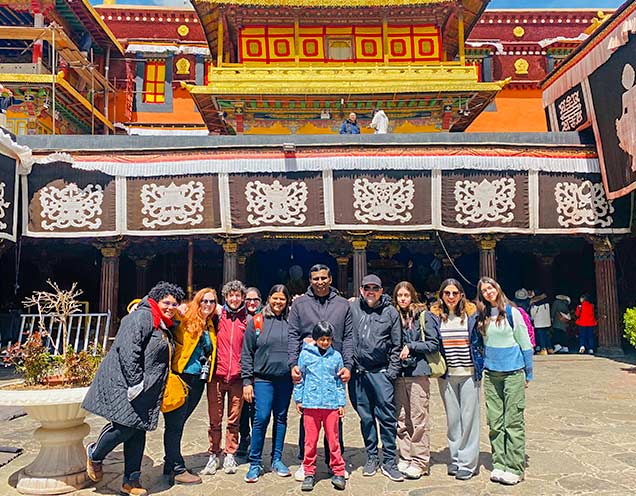
"Excellent Tour, best experience"
"A unique experience despite a difficult context thanks
to an experience team of organisers"
8 Best Tibet Nepal Tours
Looking for an in-depth exploration of Nepal and Tibet ? Why not experience the best of both destinations? You can spend 4-9 days exploring Kathmandu , Pokhara, Nagarkot, and Chitwan in Nepal , and then spend another 4-8 days visiting the highlights of Tibet , including Lhasa , Yamdrok Lake, Mount Everest, Shigatse, Namtso Lake and more. Combining Tibet and Nepal together will make your trip truly unforgettable.
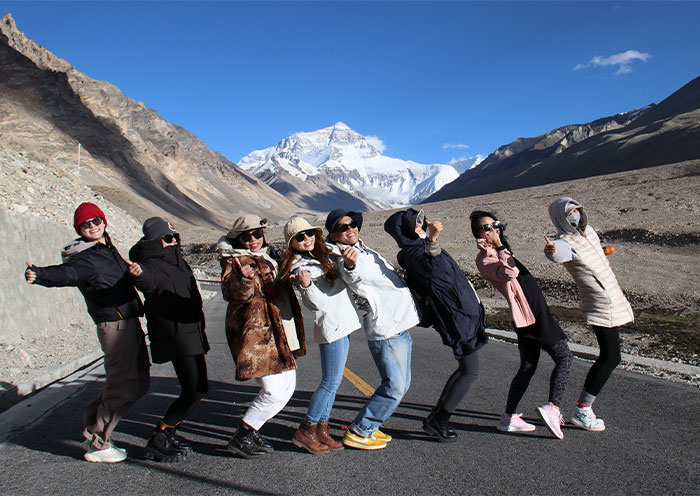
7 Days Classic Tibet Nepal Overland Tour from Lhasa to Gyirong via EBC
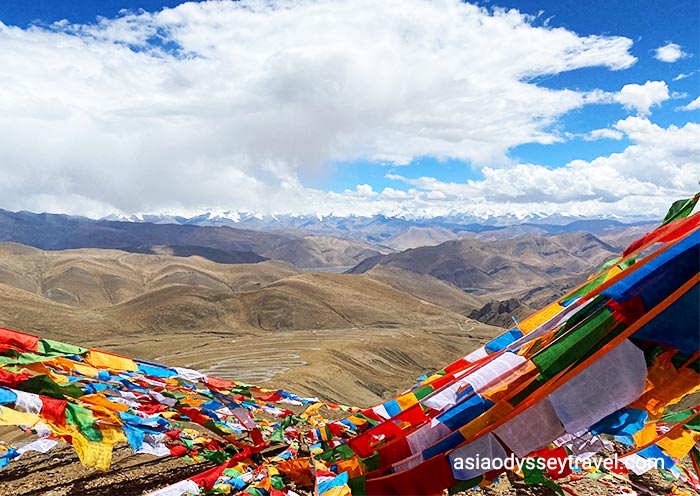
11 Days Tibet Nepal Overland Tour with Old Tingri to EBC Trek
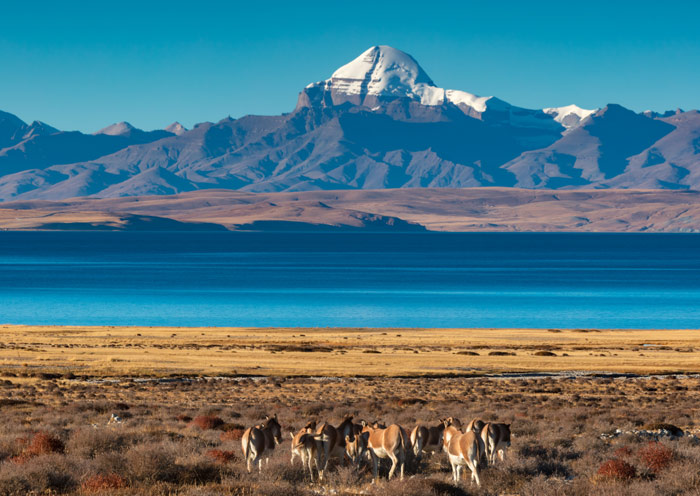
13 Days Lhasa to Kathmandu Overland Tour via Gyirong with EBC & Mount Kailash Trek
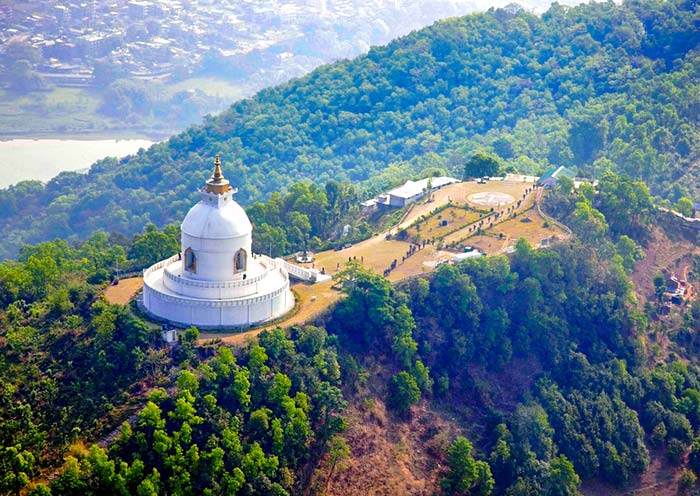
14 Days Tibet Nepal Overland Odyssey Tour (Classic Route)
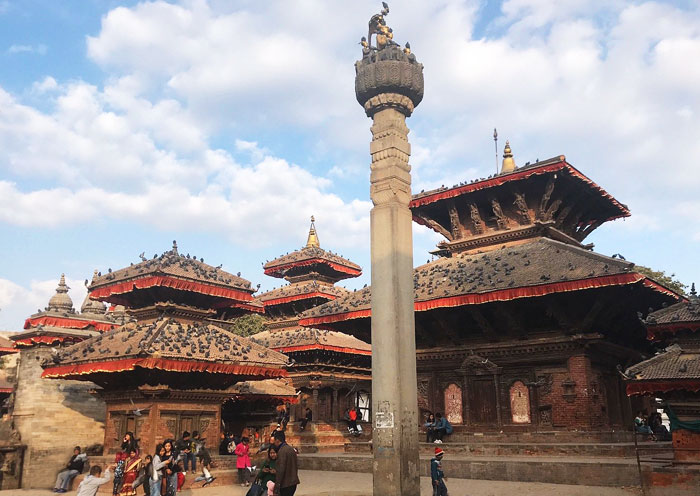
7 Days Kathmandu to Lhasa Overland Tour without EBC
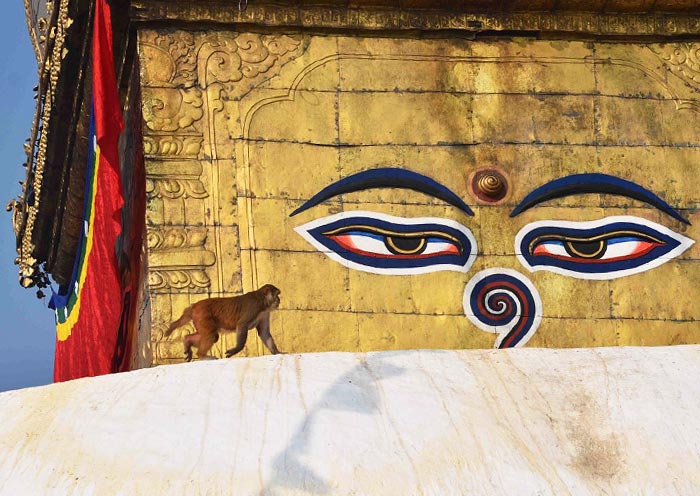
15 Days Classic Nepal & Lifetime Everest Base Camp Tibet Tour
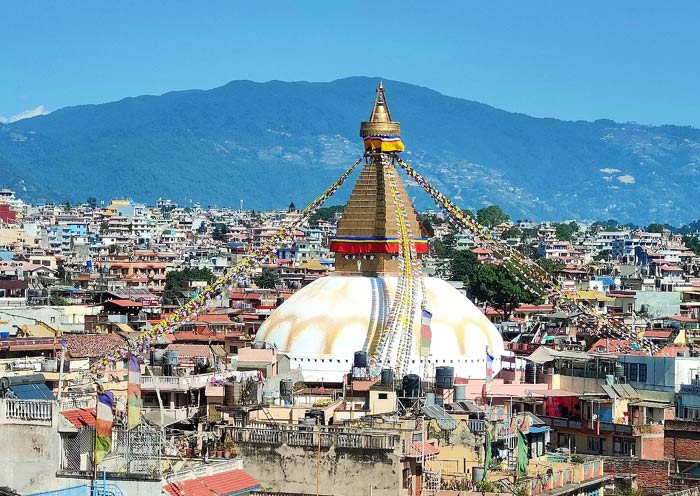
11 Days Best Nepal Tibet Overland Tour with Kathmandu, EBC & Lhasa
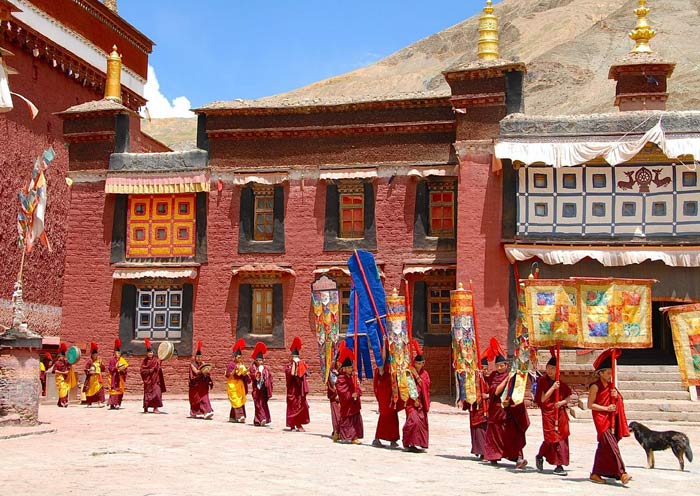
8 Days Lhasa, EBC to Kathmandu Overland Tour (Slow Pace)
Choose your nepal tibet tours by classification.
2024/2025 >>
You can travel from Lhasa to Kathmandu by overland or by flight. Select the following 3 Lhasa to Kathmandu tour packages ranging from 7 to 13 days to explore Tibet first and then enjoy your trip in Kathmandu. Best prices are guaranteed!
It is a popular choice to enter Tibet from Kathmandu, Nepal. Travelers can have an immersive cultural experience in Kathmandu by exploring “the City of Temples” and then reach Tibet by overland or by flight. Choose one of the 3 best tours from Kathmandu to Lhasa for a memorable experience.
Take an unforgettable journey through China , Tibet , and Nepal . Explore iconic Chinese cities like Beijing , Shanghai , Chengdu , and Xian before visit Tibet. Exit through the Gyirong Border to Nepal , or start your journey in Nepal and make your way to Tibet and cover highlights of China . Customize your tour at the best prices!
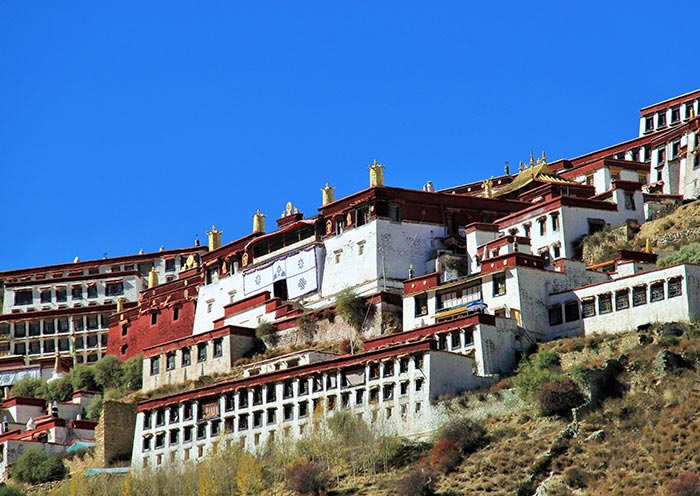
9 Days Ganden Monastery to Samye Monastery Classic Trek with Holy Lhasa Tour
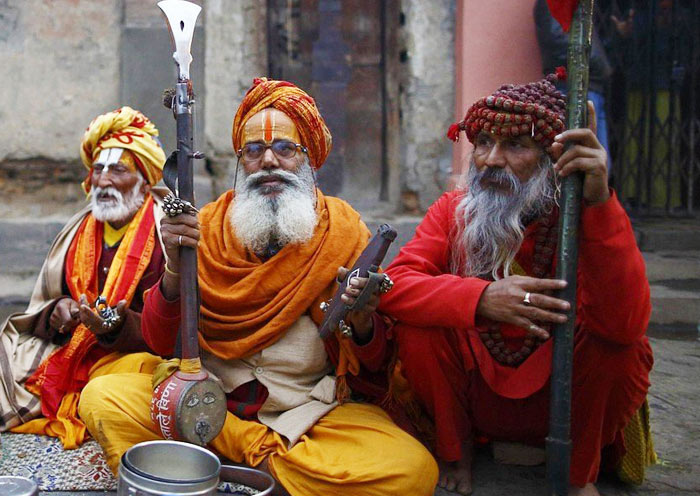
8 Days Kathmandu to Lhasa Overland Adventure Tour with EBC Experience
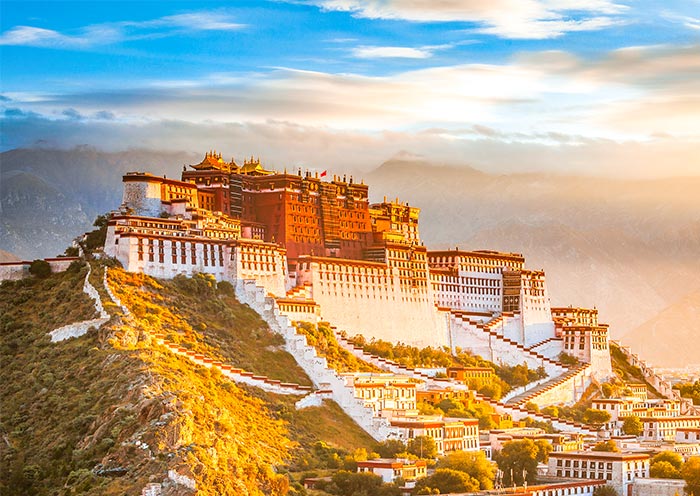
4 Days Tibet Lhasa Essence Tour from Kathmandu (by Flight)
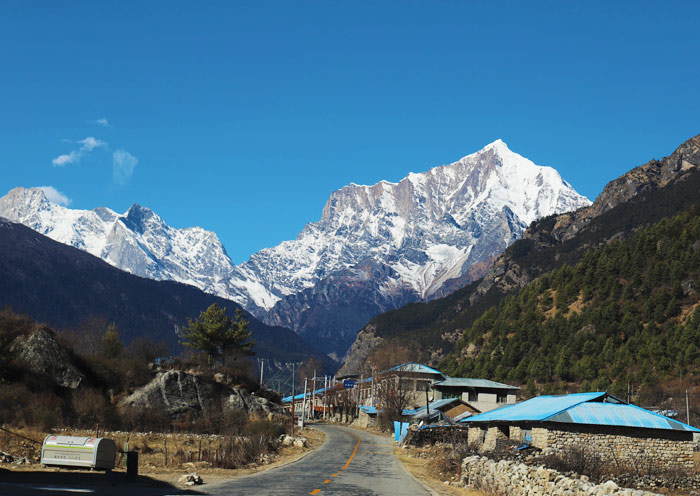
10 Days Tibet Nepal Tour from Xining to Lhasa & EBC, Overland by Gyirong Border
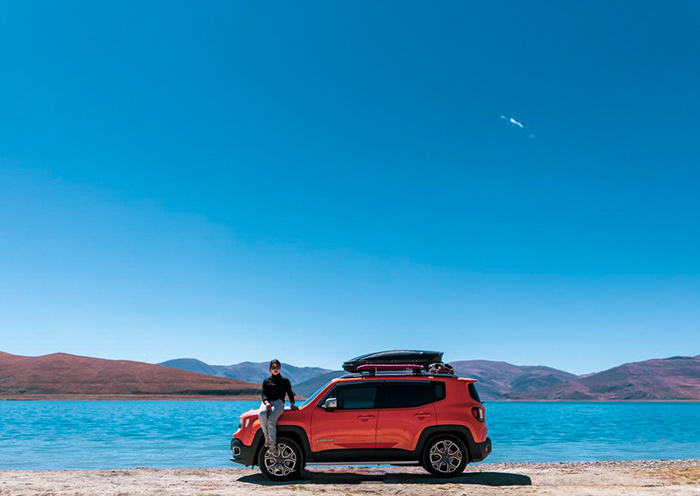
14 Days China Tibet Nepal Overland Tour with Great Wall, Terracotta & Mt.Everest
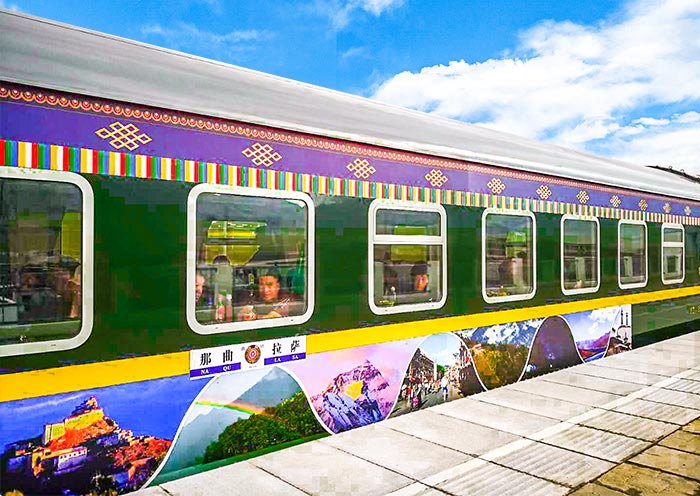
10 Days Chengdu & Lhasa to Kathmandu Overland Tour via Qinghai-Tibet Railway
Top reasons to take nepal tibet tours with us.
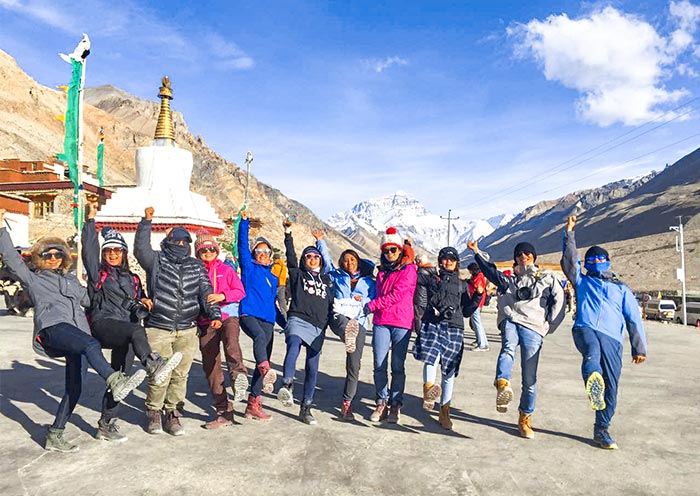
What to Expect Nepal Tibet Tours with Asia Odyssey Travel
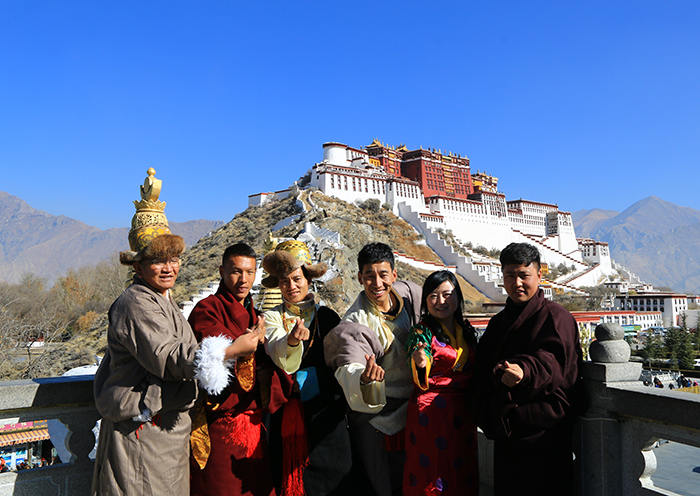
Professional & Knowledgeable Nepal/Tibet Local Guides
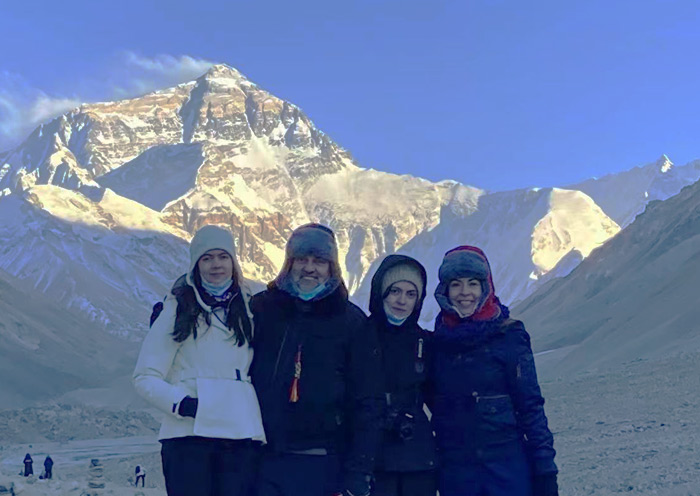
Flexibility & Comfortable Pace on Your Own
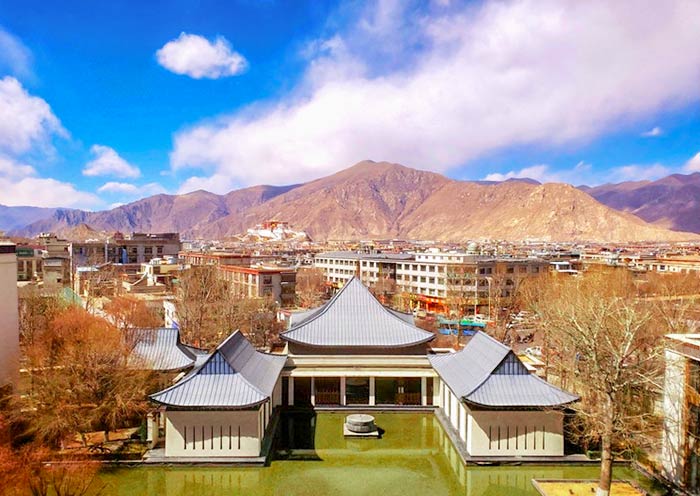
Well-selected Hotels/Guesthouses in Every Destination

Authentic Experiences & Various Activities
1. What are the accommodations like on a Tibet tour? +
There are two main types of accommodation choices on a Tibet group tour: basic standard and comfortable . In major cities like Lhasa, there are a variety of accommodation options available, ranging from 3 star to 4 star hotels. In more remote areas, such as near Mount Everest or Mount Kailash, the accommodations may be more basic, with simple guesthouses or tented camps. We will email you the detailed hotel arrangement after your booking.
Learn more about Where to Stay in Tibet & Lhasa >>
2. At what age are children suitable for Tibet tour? +
There is no specific age requirement for children to take a Tibet tour, but it is important to consider the high altitude and the physical demands of some of the activities involved. Children who are too young or not physically fit may not be able to participate in some of the more strenuous activities, such as trekking or hiking at high altitudes.
It is recommended that children be at least 4 years old to take a Tibet tour, as younger children may have difficulty adjusting to the high altitude.
3. When is the best time to visit Tibet? +
The best time to visit Tibet is from April to October , during the spring, summer, and autumn seasons. The weather during this time is mild and dry, with clear skies and comfortable temperatures.
The peak tourist season is from late June to early October . However, visiting in the shoulder seasons of April-May and mid-October to November can offer fewer crowds and lower prices. You can decide your best time to come to fulfill your Tibet dream.
Besides the weather condition, there are some grand festivals such as Saga Dawa Festival (May/June), Tibetan New Year (February) and Shoton Festival (August). If you are interested in the cultural experience in Tibet, feel free to contact our travel experts to match your ideas and likes.
Learn more about Tibet Weather & Best Time to Visit Tibet >>
4. Do I need to get a Tibet permit to visit Tibet? How long does it take to obtain? +
All foreign travelers are required to obtain a Tibet Travel Permit to visit Tibet . The permit can only be applied for through a registered travel agency in Tibet (we are local based Tibet travel agency with office setting in Lhasa) and is required to purchase flight or train tickets to Tibet. The permit is necessary to enter Tibet and visit certain areas within the region, including Lhasa and Mount Everest Base Camp . Travelers should plan ahead and allow sufficient time for the permit application process, as it can take one to two weeks to obtain the necessary permits .
All foreign travelers are advised to make their bookings at least one week in advance and send the necessary documents to us for obtaining the permits. However, if you plan to visit Mount Kailash , it is recommended to book at least two weeks in advance, as it may take longer to obtain the necessary permits.
Learn more about Tibet Travel Permits & How to Obtain >>
5. How many days for a classic Tibet tour? +
6. What is the best time to visit Nepal? +
The best time to visit Nepal for tours and travel is during the spring (March to May) and autumn (October to November) seasons. These months offer pleasant weather, clear skies, and ideal conditions for trekking and outdoor activities. Check more about Nepal Weather & Best Time to Visit Nepal
7. How do I obtain a visa for Nepal? +
To obtain a visa for Nepal , you can apply for a tourist visa at the Nepalese embassy or consulate in your home country or upon arrival at the Tribhuvan International Airport in Kathmandu . You will need a valid passport, completed visa application form, and the required fee in the form of cash or credit card. Get more ideas about the Nepal visa from our travel experts >>
8. What are the popular tourist attractions in Nepal? +
Nepal boasts numerous popular tourist attractions , including the UNESCO World Heritage Sites of Kathmandu Durbar Square, Bhaktapur Durbar Square, and Pashupatinath Temple. Other notable attractions include the sacred site of Lumbini , birthplace of Buddha, the scenic lakeside town of Pokhara , and the wildlife-rich Chitwan National Park .
9. What are the accommodations like in Nepal? +
Accommodations in Nepal range from luxury hotels to budget guesthouses and tea houses during trekking. In major cities like Kathmandu and Pokhara, you'll find a wide range of options to suit various budgets and preferences. Learn more about Kathmandu Nepal Hotels: Best Hotels in Kathmandu >>
10. What are the recommended adventure activities in Nepal? +
Nepal is known for its adventurous activities, including paragliding , white-water rafting, bungee jumping, and mountain biking. You can also engage in thrilling experiences like canyoning, zip-lining, and rock climbing. The recommended place to try the adventure activities is Pokhara .
Latest Tibet Nepal Tours Reviews from Our Customers

Ingolstadt, Germany
Date of Experience: Dec 27, 2023
Tour Customized by: Isaac
You May be Interested in This Tour: Customized Tour

Date of Experience: Feb 11, 2024
Tour Customized by: Hannah

Date of Experience: Oct 12, 2023
Tour Customized by: Tony
Create a tour based truly on your preferences, including all aspects of your travel in the destination
Himalayan Tours with Travel Inspiration in 2024
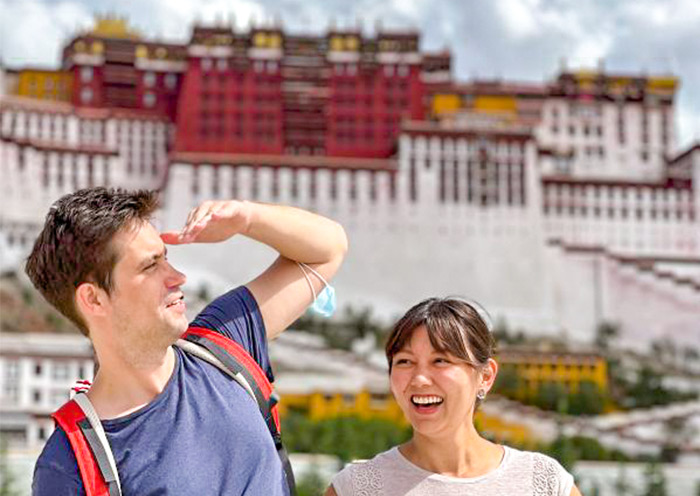
- Top 10 Tibet Tours
- Tibet Group Tours
- Tibet Train Tours
- Tibet Luxury Tours
- All Tibet Tours 2024
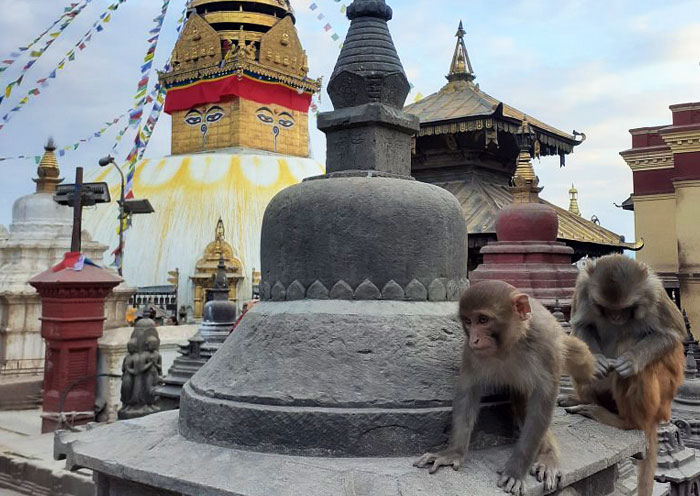
- Nepal Tours
- Best Nepal Tours
- Kathmandu Tour Packages
- Lhasa to Kathmandu Tours
- Kathmandu to Lhasa Tours
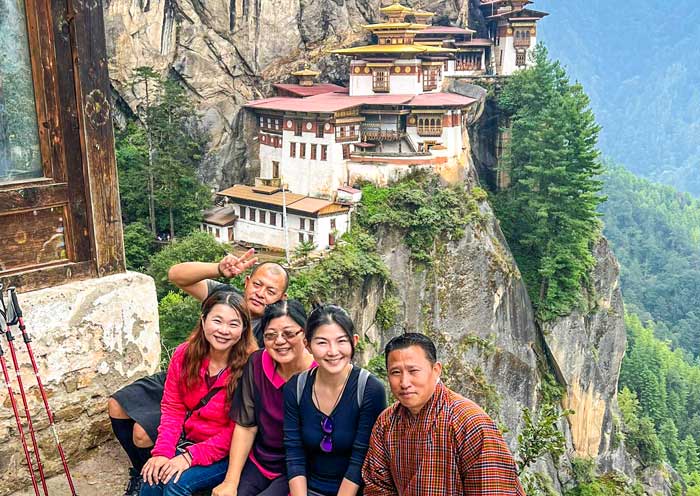
- Top 10 Bhutan Tours
- Bhutan Group Tours
- Bhutan Family Tours
- Bhutan Luxury Tours
- All Bhutan Tours
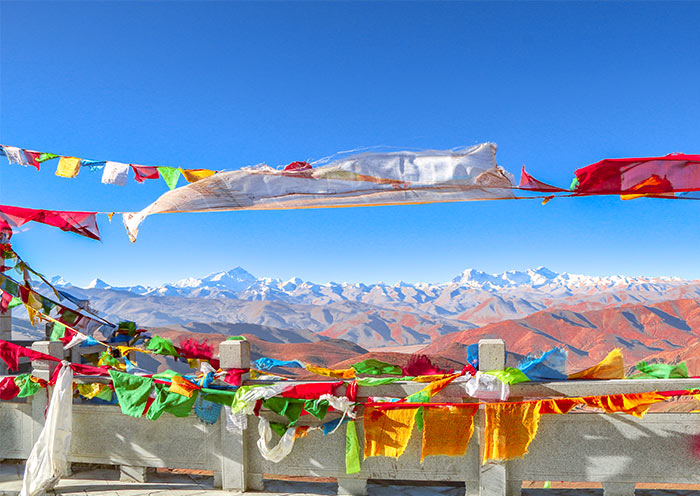
- Himalaya Tours
- Nepal Bhutan Tours
- Tibet Nepal Tours
- China Tibet Nepal Tours
- Tibet Nepal Bhutan Tours


IMAGES
VIDEO
COMMENTS
A China Group Visa and a Tibet Entry Permit are required if you enter Tibet from Nepal by land. This is different from traveling from a Mainland China city to Tibet. 1. China Visa Requirements. Based on current policy, it requires 4 people in a group to apply for a China Visa and an interview is needed at China's Embassy in Kathmandu.
Tibet Travel Permit Application for Nepalese Tourists. Despite being Tibet's closest neighbor, Nepali citizens are still required to have the Tibet Travel Permit to enter the Tibet. Besides, a group tourist visa is also a must, esp. for Tibet entry from Nepal. For our clients, we offer free Tibet permit service.
Overland travel into Tibet from Nepal is fast becoming one of the most popular ways to get to Tibet. Instead of flying to Lhasa from Kathmandu, you travel overland through Gyirong Port, the Chinese border checkpoint between China and Nepal. Getting there is relatively easy and is a six-hour drive from the Nepali capital, though you may want to ...
How to travel to Tibet from Nepal by overland, flight or train? Nowadays, there are only two ways to get from Nepal to Tibet, either overland by car or by flight to Lhasa Gonggar International Airport. ... Just check the article to get more information about the way to travel Tibet from Neapl. [email protected]. Tibettravelcall001 + 86-28 ...
Take a plane from Kathmandu to Lhasa. The fastest way and most convenient to reach Lhasa from Kathmandu is by plane. Nepal is the only country that has offered direct international flights to Tibet in the past but it has not yet resumed. Nepal's main airport is the Tribhuvan International Airport which is around 6 kilometers from Kathmandu's ...
Tibet Nepal tour provides you with the one-stop tour service for the epic journey across the Himalayas from Tibet to Nepal. As a local Tibet travel agency, with offices in Lhasa, and Kathmandu, we offer both small group and private tours that combine the best highlights of Tibet and Nepal tour with easy border transfer and multiple tour options and attentive services.
The first Tibet travel journey is a 10-day Tibet travel that begins in Lhasa and culminates at Mount Everest base camp and Namtso Lake. The second Tibet trip we recommend is a 17-day Tibet travel journey from Lhasa that takes you to Mount Kailash, where you will trek for three days over 52km at an altitude of 5000 meters. During this tour, you ...
Travel from Nepal to Tibet by Overland Journey. The Kathmandu to Lhasa overland tour covers a distance of around 1,300 kilometers, which takes about 7 to 8 days including the sightseeing trips en route. The overland tour from Kathmandu to Lhasa is quite popular among tourists.
Best Travel Seasons for Tibet Tour Via Nepal: A Guide to Planning Your Adventure. Tibet and Nepal are popular travel destinations for adventure and cultural experiences in Asia. However, their climates differ significantly, with Tibet having a high-altitude plateau sub-tropical climate, while Nepal has a more varied climate dependent on season ...
How long is the overland route. Tibet to Nepal classic tour map. The reasonably paced tour from Lhasa to Tibet-Nepal border takes at least 7 days. It includes the time necessary for acclimatizing to the high altitude of Tibet, and the actual travel time. Almost no one takes the shortest possible route to the border.
Also, you need AT LEAST four full business days in Kathmandu for your Tibet and Nepal travel agencies to arrange the group visa. Finally, flying to Lhasa's elevation of 11,975 ft/ 3658 m. from Kathmandu's 4593 ft / 1400 m puts most travelers at high risk of altitude sickness.
Travel overland journey from Nepal to Tibet via Kyirong border port. The Kyirong border town is located 130 kilometres from Kathmandu. The town on the Nepal side is called Rasuwa. There is a daily bus service available from Kathmandu to Rasuwa. You can also arrange private transportation from Kathmandu to Rasuwa.
Rome2Rio makes travelling from Nepal to Tibet easy. Rome2Rio is a door-to-door travel information and booking engine, helping you get to and from any location in the world. Find all the transport options for your trip from Nepal to Tibet right here.
Basically, you need to spend over 1 week on the best highlights in Lhasa, Everest and Shigatse. Day 1 Take a 1.5 hours' flight from Kathmandu to Lhasa. Day 2~3 Visit most famous tourist attractions in Lhasa. Day 4~5 Transfer from Lhasa to Gyantse, Tour Gyantse & Shigatse.
The route from Nepal to Tibet is one of the most spectacular routes in the world, traveling from the stunning Kathmandu Valley in Nepal over the mighty Himalayas. By crossing the vast Tibetan plateau through Lhasa along the renowned Friendship Highway, and continuing along the famous Sichuan Tibet Highway. Finally can enter into the Mainland China and its cities like Chengdu, Sichuan Province.
Travel from the Nepal Side. There are two ways into Tibet from Nepal: by flight and by road. You should first consider issues of a China visa and Tibet Entry Permit, no matter whether you'll go by flight or road. Procedures are different from traveling from a Chinese mainland city to Tibet. You must apply for a China visa and Tibet permits in ...
The extra costs aside from the tour cost itself were: Cost of the Nepal visa ($30 for 15 days, $40 for multiple entries if staying for more days before or after your trip) Cost of the Tibet Visa (Various according to Nationality) American and Brazilian: 195 USD per person. Canadian and Romanian: 150 USD per person.
The Sino-Nepal Friendship Highway makes it possible to travel through the best parts of the Himalayas. There is no doubt that the best way to travel from Tibet to Nepal is to travel through the highway from Lhasa to Kathmandu. It is one of the most epic overland routes in the world. Starting from the holy city Lhasa, you will pass by the sacred ...
Travel from Tibet to Nepal. Nepal, similarly, is well known for its beautiful alpine scenery and tropical landscapes, as well as the sights in Kathmandu. With high mountains on the border with Tibet, Nepal can also offer some great mountain adventures, and also has a base camp at the foot of Everest, on the Nepali side of the mountain. ...
Himalayan Combined Tibet Nepal Tour- 14 Days - Add-on Bhutan, if you are interested; Cultural Tour and Trekking (Nepal, Tibet, and Bhutan) - 20 Days Conclusion. The purpose of this blog is to provide essential information for those planning a trip to Nepal, Tibet, and Bhutan as part of a single package. If the trip ideas mentioned above do ...
[email protected]. + 86-28-81754631. TOP. How to Travel from Nepal to Tibet by Road. Last updated: August,19 2018. There are many ways in which one can travel to Tibet, by flight, by train, and by road. While the train is an amazing journey, it is quite long, taking from 22-55 hours to reach Lhasa, the center of Tibet.
Travel to Tibet. If you intend to travel to Tibet from Nepal, contact the Chinese embassy in Kathmandu for current entry regulations. Children and travel. Learn more about travelling with children. Yellow fever. Learn about potential entry requirements related to yellow fever (vaccines section).
Rome2Rio makes travelling from Tibet to Nepal easy. Rome2Rio is a door-to-door travel information and booking engine, helping you get to and from any location in the world. Find all the transport options for your trip from Tibet to Nepal right here.
This photograph taken on May 31, 2021 shows mountaineers looking back at Camp 4 during their ascend to the summit of Mount Everest (8,848.86-metre), in Nepal.
1) Travel from Tibet to Nepal: It is the top choice to cover both Tibet and Nepal as it will be easier for the procedure. Tour from Lhasa to EBC and exit from Gyirong Border to Nepal. Or, fly from Lhasa to Kathmandu. 2) Travel from Nepal to Tibet: You can explore Nepal first and enter Tibet via Gyirong Border to Tibet.